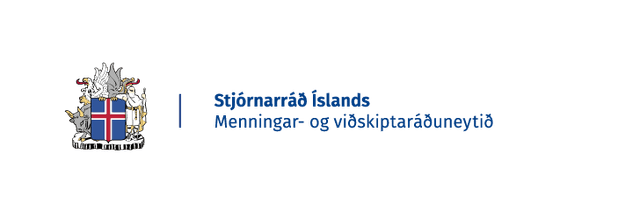BLOG

Unique pictures
Yesterday I was given photos of Bak frá Flögu in Þistilfjörður. The owner had recently sent me a short story about Bak and several photos that [can be seen here](https://www.fjarhundur.is/en/saga/bakur-fra-flogu). I will add these photos I received yesterday to Bak's story soon, but I just want to express my gratitude for these privately owned photos that are so precious to preserve. The photos are from the years 1967-1970. Unfortunately, I know nothing about Bak's lineage, but he was clearly a brilliant and handsome, smooth-haired dog with dark patches on his back. Do you have photos and short stories about your Icelandic sheepdog(s) that you would like to preserve on the site? Contact me!
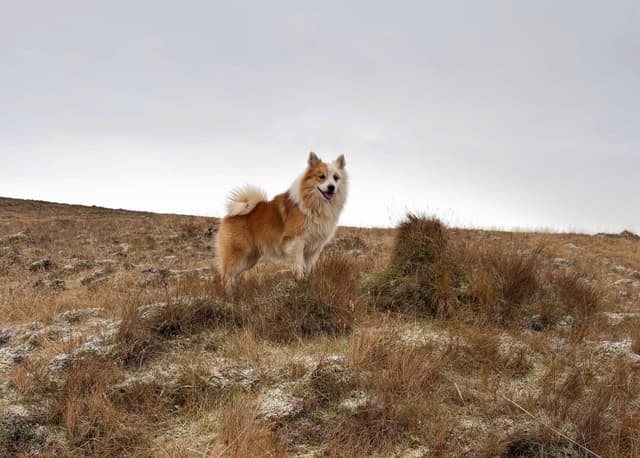
Hundaþúfa
Today, November 16th, we celebrate Icelandic Language Day on the birthday of Jónas Hallgrímsson. Jónas was a prolific writer, poet and translator (November 16, 1807 – May 26, 1845). On this occasion, I'd like to tell you about a dog-related word. In [questionnaire #66](https://sarpur.is/Spurningaskra.aspx?ID=531295&page=0&pageSize=192) in the Sarpur collection, people are asked about the word _hundaþúfa_. The respondents were born between 1896 and 1927. Hundaþúfa refers to cone-shaped grass tussocks that formed along riding paths, enriched by dog droppings. These distinctive mounds became well-known landmarks in rural Iceland when everyone traveled on foot or horseback with their dogs. Plural: hundaþúfur. _"Hundaþúfur were well known. Were other names used for them? Describe this. Do people know the saying: 'Now I think the hundaþúfa is starting to show off'?"_ All interviewees answered similarly to this woman, born in 1905: "In those days, everyone was traveling on foot or horseback with dogs along. Cone-shaped tussocks were found widely along riding paths, they were called hundaþúfur. I haven't heard other names for these distinctive tussocks. When dogs needed to relieve themselves, they ran to these distinctive cone-shaped tussocks. The grass was dark green and lush because of the fertilizer from the droppings. Horses, cows and sheep made little effort to graze on the grass of hundaþúfur." One woman, born in 1908, answered: "As a child, I was afraid of hundaþúfur, because they were the dogs' toilets." This verse appeared in the answers from a man, born in 1904: _Hundaþúfan er höldum kunn_ _hér á landi víða._ _Eðlishvötin á þeim runn_ _læt ég hana bíða._ _(The hundaþúfa is surely known / widely here in the land. / The natural urges at that spot / I let her wait for.)_ About the saying "Now I think the hundaþúfa is starting to show off," the most common response was: "I'm familiar with hearing that, 'this is quite the hundaþúfa,' was said about something that was small and insignificant or trivial." (Woman, born 1912) "Well known is the expression: 'Now I think the hundaþúfa is starting to show off.' It was often said about arrogant men who thought themselves important but others felt they had little to boast about." (Woman 1907) A man, born in 1899, answers: "I have always heard the word hundaþúfa used in a derogatory sense, such as 'there's a difference between a hilltop and a hundaþúfa.'" "I don't remember hearing or seeing other sayings about hundaþúfur in books. Though it may be that I have at some point heard it used disparagingly about a...poor turf house, built of inferior materials, e.g. 'this damn hundaþúfa.'" I end this hundaþúfa compilation on Icelandic Language Day with a verse by Steingrímur Thorsteinsson (1831-1913), author, translator and poet: _Hundaþúfan hreykti kamb_ _hún var nóg með þurradramb,_ _skamma tók hún hefðar fjall,_ _hafðu skömm þú ljóti kall._ _Fjallið þagði, það ég skil, það_ _viss'ei að hún var til._ _(The hundaþúfa showed off its crest / it was enough with its dry boasting, / briefly it took on the mountain's tradition, / be ashamed you ugly fellow. // The mountain stayed silent, I understand that, it / knew not that she existed.)_
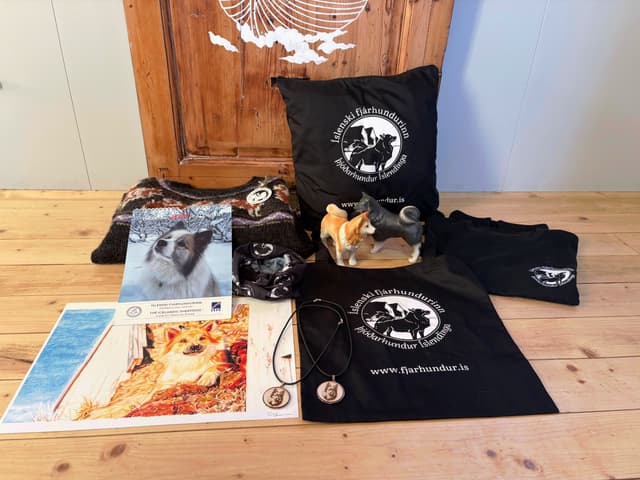
Merch
Would you like to give a beautiful gift featuring Icelands national dog or treat yourself? Our gift items are unique! We offer bags, pillow covers, t-shirts, and buffs with our logo that was designed by Kristine Olivia from Grey Fin Design, who owns and breeds Icelandic Sheepdogs in the United States. These items can be purchased at the Heritage Center or ordered from our online store, [Sveifla.is.](https://www.sveifla.is/en/collections/fjarhundur) We had our German friend, the artist Corinna from Sonnenkunst, paint three pictures of our dogs, and you can buy high-quality reproductions of them. The paintings are called Hraundís (seen in the image above), Sómi ([our opening image](https://www.fjarhundur.is/en)), and Þjóðarhundar/National Dogs ([see here](https://www.fjarhundur.is/en/blog/18.-juli-dagur-islenska-fjarhundsins)). You can also purchase the porcelain figurine "Glaður", designed by artist Guðbjörg Auður Björnsdóttir and produced in one of the oldest family-run porcelain factories in Germany, Wagner & Apel. We have beautiful necklaces for sale featuring the head of an Icelandic dog by artist Kathrin from Katha Design Iceland, who owns an Icelandic Sheepdog. Additionally, we have our own knitting pattern "Sómi" that our friend, artist Barbara, designed for us. You can get hand-knitted lopapeysur (Icelandic wool sweaters) and hats with this pattern from us. However, the pattern itself is not for sale. Last but not least, we have several 2026 calendars that the Icelandic Sheepdog Association – DÍF publishes annually. Our Fönn graces the July page this time. The calendar is also available in [DÍF's online store](https://verslun.dif.is/). Contact us if you're interested in purchasing any of these items or visit us at the Heritage Center.
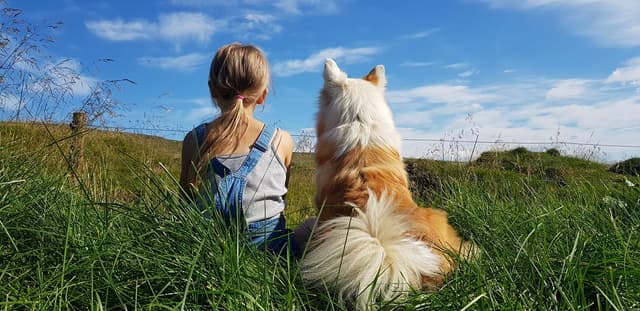
A Milestone for dog owners in Iceland
Good news came yesterday when Alþing, the Icelandic Parliament approved a [legislation](https://www.althingi.is/altext/155/s/0162.html) by Inga Sæland, Minister of Social Affairs and Housing, amending the law on apartment buildings, which stipulates that dog and cat ownership will no longer be subject to approval from other apartment owners. The law entails that: 1. People living in apartment buildings who share stairwells with others no longer need approval from other owners to own a dog or cat. 2. Housing associations will, however, be able to set rules regarding dog and cat ownership, as long as these are reasonable, appropriate, and based on equality. 3. Housing associations can still ban dogs and cats if the animals cause significant disturbance, nuisance, or disruption and owners do not respond to warnings from the housing association and remedy the situation. Thus, a housing association could, for example, ban individual cases of pet ownership if allergies were at such a high level that cohabitation with the animal would become unbearable and no solutions could be found to remedy the situation. 4. However, approval from 2/3 of owners is required for such a ban, and the same applies when a pet owner seriously or repeatedly violates their obligations under the law or the housing association's rules, despite warnings from the housing association. The housing association can then ban the pet ownership in question with approval from 2/3 of owners and require the pet owner to remove it from the building. An important step was taken in dog owners' rights with this legal change. There was a dog ban in Reykjavik for 60 years, from 1924-1984. However, it wasn't until 2007 that the dog ban was completely lifted, except that dog (and cat) ownership in apartment buildings was subject to approval from 2/3 of owners who shared a common entrance or stairwell. With this change in law, that is now a thing of the past and will allow more people to own dogs or to keep their dogs when they need to move to another apartment. This has been incredibly difficult for dog owners in past years. Here you can read more about the [Dog Ban in Reykjavik](https://www.fjarhundur.is/en/blog/hundabann-i-reykjavik-i-60-ar) - this blog post is actually the most read post on this site.

Outside garmar howled
Sarpur is an Icelandic cultural-historical database where you can find, among other things, extensive knowledge about folk customs in the form of questionnaires. [Questionnaire #66](https://sarpur.is/Spurningaskra.aspx?ID=531295) is dedicated to dogs, and contains responses from 71 interviewees. These answers provide a good idea of dog culture (attitudes toward dogs, folk beliefs, customs) in Iceland in the first half of the twentieth century. The recording took place in 1987. I have extensively browsed through the questionnaire #66 because it is a true treasure trove. One question, for example, is about common dog names, and I counted 221 dog names that appeared in the responses. More on that later. Another question was about synonyms for dogs: "Describe synonyms for dogs (hundur, hvutti, deli, búadeli, grey, garmur, rakki, seppi, skinn, héppi etc.). Tell about derived words, meaning and differences in meaning (hundsspott, hundsskinn, garmsskinn, greyskinn, greyskarn etc.). Was the word 'klódýr' used for dogs and cats and even foxes as a synonym? Were the words hrædýr, hrækvikindi sometimes used about dogs?" I have compiled some responses: Derogatory words: hundsspott. Derived words: hundsskinn, garmskinn, greyskinn, greyskarn Garmur is used in a disparaging and pitying tone Hvuttar was rather used for puppies. Pet words for dogs were e.g. garmskinn, greyskinn and greyskarn. I am unfamiliar with hundsspottið, I think it means to be different than it should be, hundsskinnið, garmskinnið, greyskinnið are pitying or pet words, greyskarn could also have meaning but likewise mixed with disparagement, but if someone was said to be hundtyrki it meant they were bad. I recognize most of these synonyms, hundur, hvutti, deli, búadeli, grey, garmur, rakki, seppi, skinn, héppi but I think that klódýr and hrædýr were mainly used by old people and are no longer heard. The words hvutti, mainly about young dogs i.e. puppies, rakki and seppi very common, but grey and garmur rather as pet names and derivatives of them greyskinn and garmskinn no less used about men, as friendly threats About the synonyms for dogs, which are listed in the questionnaire such as hvutti, deli, búadeli, grey, garmur, rakki, seppi, skinn and héppi, all were used by old people in my childhood except búadeli, I have never heard that. Hundsspott, then it particularly referred to puppies that had done something unnecessary. The word klódýr was a synonym for dogs and cats. When dogs came home in poor condition after long wandering, it was sometimes said that the hundshræið had finally come home. Hrædýr and krækvikindi were foxes but it did happen that it was used about wandering dogs or dogs that were starving for some reason. So they were often spoken to playfully, especially by children, grey, also said seppi minn when giving them their share: "Drink this now, greyið." Often there were stray dogs around, dirty and hungry, then it was often said: "One must give to garmur." Often it was said aumingja hræið or hrækvikindið, if something was wrong with a dog. As can be seen, dogs and their synonyms have had great influence on daily speech, and I intend to conclude this post with a quote from Jónas Hallgrímsson in the poem "Óhræsið": Mædd á manna besta miskunn loks hún flaug, inn um gluggann gesta guðs í nafni smaug – úti garmar geltu, - outside garmar howled gólið hrein í valnum – kastar hún sér í keltu konunnar í dalnum. Image: Baldvin Jónatansson, wife and livestock in Víðaseli in 1910
Opening times during winter
The Icelandic Sheepdog Heritage Center was open daily from 9-18 throughout the summer and into autumn. We will not have fixed opening hours during winter. However, we live on-site and can open with short notice if there is interest in coming to see the exhibition. Please feel free to contact us by phone or email. It doesn't matter whether you are traveling alone or with a group. We and the dogs will welcome you warmly. It's also possible to visit our turf houses year-round, with audio guides in English, German, French and Icelandic. We plan to have one open day during Advent and it will be advertised in more detail when the time approaches. It's perfect to take a trip to Skagafjörður, enjoy time together, learn about Icelands national heritage, and purchase some of our unique souvenirs related to the national dog. The summer opening of the Heritage Center begins again in mid-May. We look forward to seeing you!
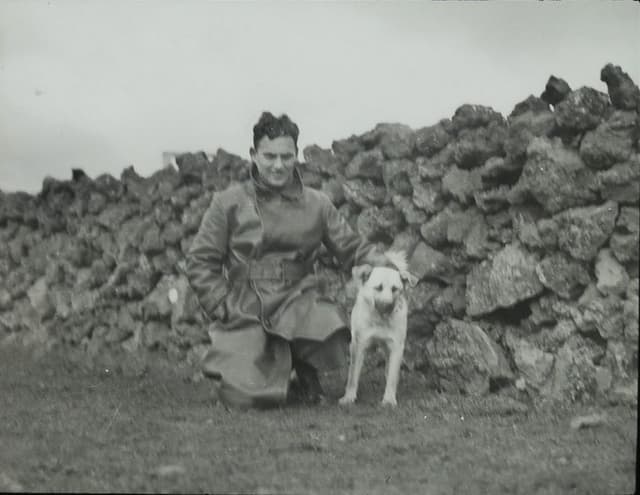
A Journey to Iceland
Earlier this fall, a man called me - Vilhjálmur Örn Vilhjálmsson, an Icelandic archaeologist and blogger, living in Denmark. The conversation was very interesting and we mostly talked about that remarkable man Mark Watson. Vilhjálmur had met Watson during his childhood: "He once came home to my father and bought an old map of Iceland from him. Watson was offered coffee and cake. He was among the taller men and had a particularly tall head compared to my father, and men with such heads often had to be searched for extensively in Iceland," he writes in one [blog post](https://fornleifur.blog.is/blog/fornleifur/entry/2279685/). Then Vilhjálmur told me about buying a box on eBay because its contents aroused his curiosity: "...it contained a complete series of images and accompanying notes for stereoscopic photographs, 8x8 cm in size." The series was titled A Journey to Iceland. The box contained 35 stereoscopic images from the 1930s. It turned out that the images had belonged to Mark Watson and had been shown at the World's Fair in New York in 1939. Vilhjálmur assembled the images into a video and uploaded it to YouTube so that you can watch the images as they were shown at the time during a lecture in New York. [See here](https://youtu.be/Yc84jF3NEMw?si=7keUS0cfeFVWi9B2). It is also interesting to read [Watson's notes for the lecture](https://fornleifur.blog.is/users/5c/fornleifur/files/iceland_lecture_0001_21343.pdf) that came with the box. The notes are typed but Watson also handwrote additions on them. Image no. 29 (shown above) is of an Icelandic dog. About the dog he writes: "A dog more famous than the english sheepdog. Came with first settlers? Will work a mile from master, by signals. Though part of the family never sleeps indoors; below window even in snow. Even Shakespeare mentions it in Henry V, Act2 Sc.1 "The Iceland Cur". Friendly to foreigners, proves well treated. Size of Foxterrier, generally cream, or black and white." Watson's interest in the dog was already sparked during these years, though he did not undertake the rescue efforts until 1955. More about the origin of the images that Watson took mainly in 1937 can be read in an article by Anna Snorradóttir published (in Icelandic) in [Lésbók Morgunblaðsins in 1988.](https://timarit.is/page/3307270?iabr=on#page/n35/mode/2up) Vilhjálmur's phone call was truly interesting and gave me even more knowledge about Watson and his love for Iceland and the Icelandic dog. I thank Vilhjálmur warmly for getting in touch and telling me about the stereoscopic image box and especially for the opportunity to see the images in the YouTube video that he put together.
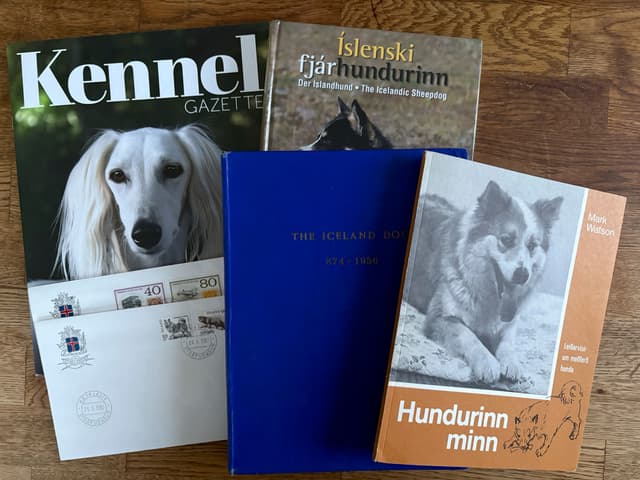
As autumn arrives
As autumn arrives, it's a good time to take stock. It's been planned for a while, but now winter seems to be here. Snow is falling in most parts of the country, though the least amount of snowfall is here in the north. The picture above aptly represents what happened during the autumn days. In the September issue of "Kennel Gazette" from the British dog breeders' association, The Kennel Club, a three-page article appeared featuring an interview with me and plenty of photos from the opening of the Icelandic Sheepdog Heritage Center. This is fantastic, especially considering the growing interest in the Icelandic Sheepdog in Britain after the breed was recognized by the association this year. Now it's finally possible to breed and show Icelandic Sheepdogs in Britain. In September, Darren Adam from RÚV English Radio interviewed me again. This time, we walked through the Heritage Center together and discussed what was on display. [You can listen to the interview here](https://www.ruv.is/english/2025-09-29-ruv-english-radio-the-icelandic-sheepdog-heritage-centre-454737). While I remember, there was a feature on RÚV's evening news in the summer that I meant to mention. [You can watch the news here.](https://www.ruv.is/english/2025-07-06-museum-dedicated-to-the-icelandic-sheepdog-opens-in-north-iceland-447787) My research partner in Denmark, Jørgen Metzdorff (see [www.naskur.dk](http://www.naskur.dk)), gave me a generous gift: another copy of Mark Watson's book "The Iceland Dog 874-1956," for which I am very grateful. I also received the book "Hundurinn minn" by Watson, which I have searched for a long time, and "The Icelandic Sheepdog" by Gísli Pálsson. Jørgen also gave me stamps for my collection. Thank you, Jørgen. These gifts are much appreciated! I wrote an article for the German magazines of the "Deutsch-Isländische Gesellschaft e.V Köln" and "Freunde Islands e.V. Hamburg" about the initiation and execution of the Icelandic Sheepdog project. On that occasion, I gathered figures and found that around 2,500 people have visited the Heritage Center from its opening in May until the end of September. This is quite good. This number includes people who came specifically to see the exhibition, as well as those who unexpectedly stopped by and viewed the exhibition on their way to horse rental or while staying with us. All tour bus groups have access to the exhibition. Maybe not everyone explored the exhibition in great detail, but at least I've introduced the Icelandic Sheepdog to all those people. Last week, about 70 people visited in connection with the tourism harvest festival in North Iceland. It was fun to introduce the Heritage Center as a novelty to our colleagues in North Iceland. What's next? To complete several projects in the building, which has been named Hraunkot (after my bitch, Hraundís), put up more pictures, and create a folder with all the newspaper articles from the summer. I also need to review other materials I have acquired over the summer. I have more ideas to improve the exhibition, but it requires a lot of work. I’ll update on that when it happens.
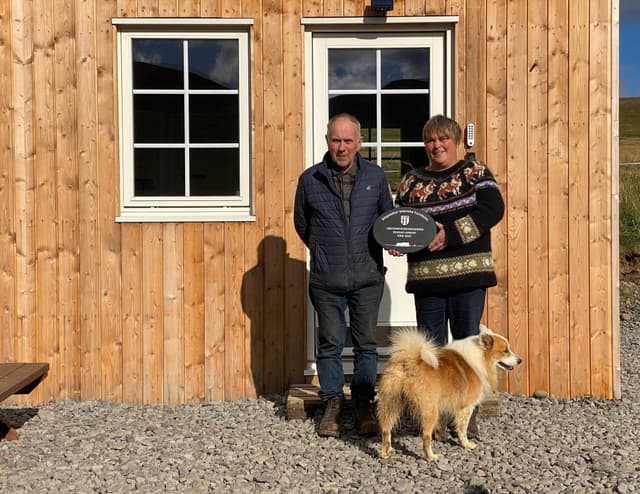
Award
Last week, we received an award from the Municipality of Skagafjörður for “An Exceptional Initiative "– The Icelandic Sheepdog Heritage Center". In the statement it says: "After two and a half years of research and preparation, the family at Lýtingsstaðir opened The Icelandic Sheepdog Heritage Center, in a specially designed building in May of this year. This is a unique exhibition about the history of the Icelandic sheepdog, with the aim of preserving and sharing knowledge about this distinctly Icelandic breed, giving it space, and making it visible and accessible. At the center, visitors can learn about the history of dogs in Iceland, from the settlement period to modern times, about folklore, and also stories of famous dogs. One can also watch a variety of videos and documentaries, view old photographs and engravings, browse through books, read old documents and letters, and discover the softness of yarn spun from dog hair. Three Icelandic sheepdogs on the farm form a cheerful welcoming committee. The Icelandic Sheepdog Heritage Center has attracted great interest from both Icelanders and foreign visitors, in addition to being featured in the media. The Icelandic Sheepdog Heritage Center is a living testament to how passion, respect, and sustainability can come together in an exceptional initiative that preserves cultural heritage for future generations." We are very proud of this recognition and sincerely thankful.
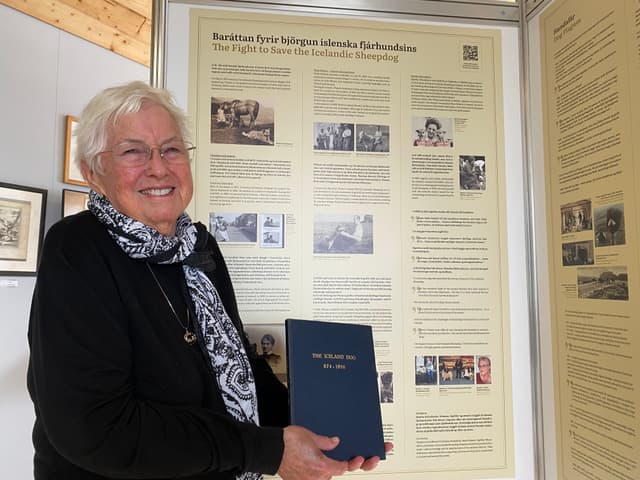
From Vision to Reality: The First Summer at the Icelandic Sheepdog Heritage Center
The Icelandic Sheepdog Heritage Center has now been open for just over three months, and it feels like the right time to reflect on how this first summer has gone. In short, the reception has far exceeded expectations. I am deeply touched by how many Icelanders have visited the exhibition, showing great interest in both the national dog and its history. Many beautiful (sheep)dogs accompanied their owners on visits – and of course, they were warmly welcomed too. What stood out with foreign visitors was that very few of them had ever heard of the Icelandic Sheepdog. I can safely say that we succeeded in introducing our national dog to hundreds of international guests who primarily came to experience the Icelandic horse. Many were surprised to learn that such a unique Icelandic breed even existed. At the same time, we also welcomed visitors who knew the breed well, owned Icelandic Sheepdogs themselves, and even bred them in their home countries. This summer has brought many enjoyable and fascinating conversations – and even some goosebump moments. One such moment was the visit of Rafn Jónsson, who in [1984 filed a lawsuit against then Minister of Finance, Albert Guðmundsson](https://www.fjarhundur.is/en/blog/hundabann-i-reykjavik-i-60-ar), for illegal dog ownership after publicly revealing it on television. Rafn was just as surprised to see his name featured in the exhibition as I was to welcome him in person. Another unforgettable visit was that of Patricia Putmans, who came in connection with the Icelandic Sheepdog Day. Patricia, or Pat, once worked with Mark Watson, assisting him in bringing Icelandic Sheepdogs to the United States in 1955 and in gathering material for the book [_The Iceland Dog 874–1956_](https://www.fjarhundur.is/en/blog/bokagjof). Meeting this lively woman, who fulfilled her dream of visiting Iceland and Glaumbær at the age of 84, is something I will never forget. Now the days are growing shorter and summer is coming to an end. Ahead lie autumn tasks and a long winter, which I look forward to using for further research and collecting more stories. The goal for this year was to open the exhibition – and that was a great success. Now the next step is to continue building and expanding the center. The Heritage Center will remain open daily through September, and after that by appointment. Photo: Patricia Putman holding the book _The Iceland Dog_ in front of the information board about Mark Watson on Icelandic Sheepdog Day, July 18, 2025.
Icelandic Sheepdog Day
Happy Icelandic Sheepdog day to all owners and friends of the Icelandic Sheepdog! July 18th is the birthday of Mark Watson, whom we often call the savior of the Icelandic Sheepdog. This year, the day is being celebrated for the tenth time all over the country, as well as abroad. Social media is filled with pictures of beautiful dogs, showing just how diverse the breed is when it comes to color variations and coat types. On the occasion of the day, various events are being held. In addition to the festivities at Árbæjarsafn in Reykjavík, I would especially like to mention the event here in Skagafjörður, called "Mark Watson Day." Watson is not only connected to the rescue of the Icelandic Sheepdog, but also to the restoration of the old farm at Glaumbær, which became Iceland’s first folk museum. We will begin the celebrations here at Lýtingsstaðir, where we expect guests with their dogs after noon. Admission to the Heritage Center will be free today. Afterwards, we will move over to Glaumbær to delight guests there from 4–6 pm. We are also expecting a guest of honor whom I am very excited to meet. Patricia Putman will be present; she has dedicated her life to dog breeding and training, with the Icelandic Sheepdog holding a special place in her heart. Pat is the chair of the judges’ education committee and the AKC representative for the Icelandic Sheepdog Association of America (ISAA). She worked with Mark Watson in the 1950s on his book “The Iceland Dog 874–1956” and played a major role in the selection and import of Icelandic dogs to the United States. Pat will say a few words about Mark Watson and the Icelandic Sheepdog in honor of the day. Her talk will be streamed on the Facebook page of the Skagafjörður Heritage Museum. Our dogs will be decorated today with an Icelandic ribbon attached to their collars! I would like to end with a beautiful quote I read on social media yesterday, from _Independent People_ by Halldór Laxness: “No matter how things turn out, at least people have the memories of their dogs—those can never be taken from us!” Enjoy the day!
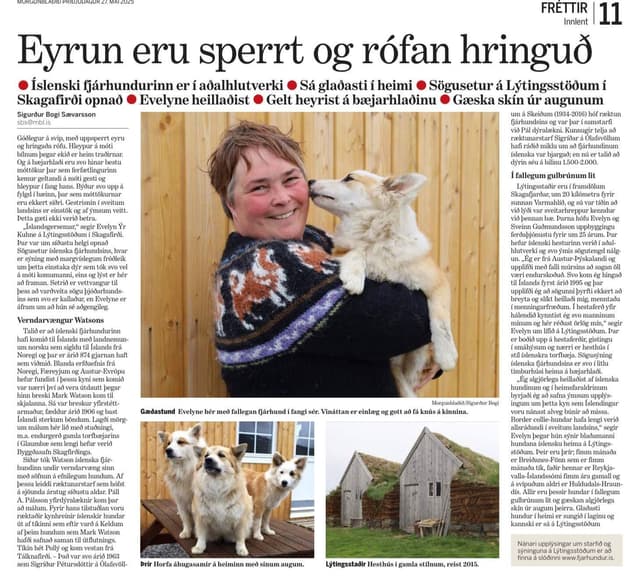
The response
It has now been four weeks since we opened the Icelandic Sheepdog Heritage Center, and it is safe to say that the reception has been fantastic. Many people have already visited the center, both in organized group tours and as individuals. We feel the gratitude of Icelanders that the national dog and its story now have a space and a place to be visible and preserved. Several foreign visitors have come specifically to see the exhibition, as they own—and even breed—Icelandic Sheepdogs in their home countries. Every day, tourists come to us to experience the Icelandic horse and are often very surprised to learn upon arrival that there is not only an Icelandic horse but also an Icelandic dog. Many of them take the opportunity to visit the center before or after their riding tour, and the guestbook is filling up with words of praise. We have received excellent coverage in both Icelandic and foreign media. Morgunblaðið published a great article right after the opening (see photo). The Icelandic Kennel Clubs magazine Hundasámur, featured an article ([see here](https://www.hundasamur.is/greinar1/sogusetur-islenska-fjarhundsins-opnar-a-lytingsstodum-i-skagafirdi)). SSNV, the Association of Municipalities in Northwest Iceland, covered the opening, and the project has twice received grants from the Northwest Iceland Development Fund. The local newspaper Feykir published an article about the Heritage Center, and the Farmers journal [Bændablaðið](https://www.bbl.is/lif-og-starf/lif-og-starf/sogusetur-islenska-fjarhundsins-opnad), of course, also had its finger on the pulse. I was interviewed on a morning radio show yesterday, and you can listen to the episode [here](https://www.visir.is/k/94352390-d34e-43c0-b937-fcb00a56dc0d-1750669179232). A journalist from RÚV North Iceland is expected today. We will see when it will be broadcasted. On social media, coverage appeared from the [North Iceland Marketing Office](https://www.facebook.com/MarkadsstofaNordurlands/posts/pfbid0DzUmGx9fZnJGKqM8BcduTRFu5rpaMxximPZ3aV1FGtwQgmZhHKA88c9SCwcw3xdKl) and on "[Iceland Route 1 and Beyond.](https://www.facebook.com/IcelandRoute1andBeyond)" The Danish Icelandic Sheepdog Owners’ Association published an [article in its magazine](https://drive.proton.me/urls/4K4MD1ZK0G#8C2hSnMiweAU), and an article in the Kennel Club in the UK is forthcoming. We are extremely grateful for the reception and all the coverage about our Icelandic Sheepdog Heritage Center. Sómi, Hraundís, and Fönn always greet all guests and journalists with a smile and do their part to uphold the image of the national dog. The Heritage Center is open every day from 9 am to 6 pm.
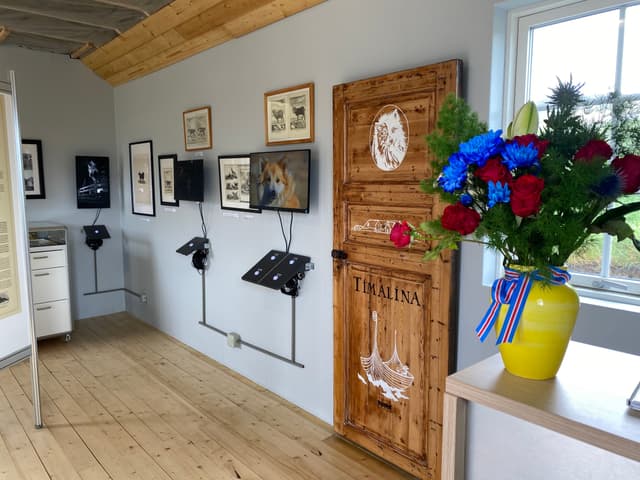
Icelandic Sheepdog Heritage Center
This past Saturday, we opened the Icelandic Sheepdog Heritage Center (Sögusetur Íslenska fjárhundsins) at Lýtingsstaðir in Skagafjörður. The opening ceremony was well attended and full of wonderful guests. Behind the exhibition lies two and a half years of research and preparation. The goal of the center is to preserve the history of the Icelandic Sheepdog and to make it accessible and visible. We hope the exhibition will spark interest among locals as well as international visitors in the Icelandic Sheepdog as an important part of our cultural heritage. The center is open daily throughout the summer from 9 AM to 6 PM, and by appointment outside those hours. Since we live on-site, we’re also happy to welcome visitors during other times of the year. We look forward to seeing you!
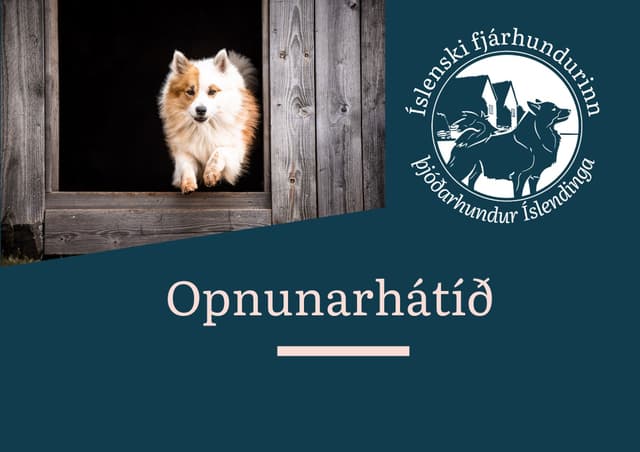
Opening ceremony - Icelandic Sheepdog Heritage Center
The time has finally come! After two and a half years of preparation, we are finally opening the exhibition here at Lýtingsstaðir in Skagafjörður. It will carry the name Icelandic Sheepdog Heritage Center (Sögusetur Íslenska fjárhundsins). The center serves as a platform to preserve, share, and promote the history of the Icelandic Sheepdog. Our goal is to raise awareness among locals and visitors alike about the Icelandic Sheepdog as an important part of our cultural heritage. The opening ceremony will take place on Saturday, May 24th at 3 PM. Light refreshments will be served, and everyone is warmly welcome to celebrate with us! The exhibition will be open daily from 9 AM to 6 PM until October, and by appointment during the winter months. We are truly excited and look forward to sharing this with you!
The coat
The coat of the Icelandic Sheepdog is a double coat, thick and extremely weather resistant and repels water. The texture of the coat should not be very soft, but rather coarse. It is often an advantage that the coat has the self-cleaning property, especially in muddy weather. The mud falls off easily, and the dog remains clean. The hair can have two variants: short-haired and long-haired. In the [FCI breeding standard](https://www.dif.is/UmTegundina/289g05-en.pdf), it states: "Short-haired: The outer coat is fairly coarse, with a thick, soft undercoat. The hair is shorter on the face, top of head, ears and front of legs. It is longer on the neck, chest and back of thighs. The tail is bushy and the hair length is in proportion to the coat. Long-haired: The outer coat is longer and fairly coarse, with a thick, soft undercoat. The hair is shorter on the face, top of head, ears and front of legs. It is longer behind the ears, on the neck, withers, chest and back of thighs and with fringes on the back of the forelegs. The tail is very bushy and the hair length is in proportion to the coat." Short-haired Icelandic Sheepdogs are less common than long-haired ones. It is sometimes said that short-haired dogs receive worse evaluations at shows than their long-haired counterparts. Many people find long-haired dogs more beautiful, but of course, taste varies. Short-haired dogs are often referred to as the "old type." I once heard an elderly farmer say that farmers preferred short-haired dogs because snow doesn’t stick to them as much. Long-haired dogs, so called "Lubbar" sometimes had to have snowballs clipped out of their coats, as they were too difficult to manage. In my experience, however, a long-haired dog with coarse coat texture, like my own dog Sómi, never has problems in the snow—nothing ever sticks. On the other hand, my dog Hraundís has a softer-textured coat, and sometimes snow clumps on her paws. It is very important to preserve both coat types in the breed. I’ve read an interesting discussion by an American woman, Scotti Harvey, who kindly gave me permission to [refer to her post](https://www.facebook.com/scotti.harvey.9/posts/pfbid0HCYZRYMtFrt89T8nVjSdGDpdygU6asQx2Xa8BxCCy7gkQJXdRCFMj6ygKhkNoB23l?rdid=UrUfPD0YN3xvGRoK). She writes: > “As we attempt to preserve our working coats that protect our dogs in rugged terrain and Nordic climates, taking a peek at the population genetics can be an eye-opener. > > On my first trip to Iceland, I was warned that breeding long to long coats could change the structure of the coat. That it was important to preserve the short coat in order to protect the quality of the longer coats.” Scotti encourages the genetic testing of more dogs to better understand where we stand in our efforts to maintain both coat types. Research conducted so far suggests that the proportion of long-haired dogs is so dominant that we may be close to losing the short-haired ones from the gene pool. Although I myself have long-haired dogs, I always admire the short-haired ones and hope that breeders will actively work to preserve this coat type. I’m including a photo of a beautiful short-haired dog from Denmark, Nicu. The photo was taken by Blebea.photography.

Sómi conquers abroad
At the end of 2024, news arrived that the Icelandic Sheepdog would be officially recognized as a breed by the British Kennel Club. This recognition came into effect on April 1, 2025, meaning that the breeding of Icelandic Sheepdogs in Britain will now follow official breed standards, allowing the issuance of official pedigrees and participation in official dog shows—including CRUFTS, one of the world's oldest dog shows, held annually since 1891. [The Kennel Club published the official breed description](https://www.thekennelclub.org.uk/search/breeds-a-to-z/breeds/pastoral/icelandic-sheepdog-imp/) of the Icelandic Sheepdog on its website on April 1. The breed model featured was none other than my dog, Reykjavalla Íslands Sómi, of whom I am incredibly proud. Not only were two photographs of him published, but also a beautiful artwork created from the photograph, displayed above. It will be exciting to follow the progress and development of the Icelandic Sheepdog breed in Britain. The breed enjoyed popularity there during the Middle Ages and has remained known ever since, despite the overall number of Icelandic Sheepdogs in Britain never having been particularly high.
Highlights from March
March has been quite eventful, and I'm happy to share the latest updates here. The building that will host the exhibition is almost ready, and we can soon start setting up. I've finished writing all the texts for the exhibition panels, which are currently with the designer and will soon go to print. This has been a significant and extensive project, and there will likely be eight panels in total. Initially, I didn't intend to have too much text, but after two and a half years of gathering materials, it didn't feel right to shorten everything significantly, especially since it's been carefully organized. Still, what appears on the panels will only be a fraction of what I've written. I'm also planning to better organize the content on this website to make it more accessible and coherent with the exhibition. Recently, I was asked whether this should be called an "exhibition about the Icelandic Sheepdog" or the "Icelandic Sheepdog Heritage Center" (Sögusetrið Íslenska fjárhundsins). After careful consideration, I believe "Heritage Center" is more appropriate, as the exhibition will be ongoing. At the beginning of the month, Darren Adam, a reporter from RÚV English radio, visited me and interviewed me about the Icelandic Sheepdog and my project. [You can listen to the interview here](https://www.ruv.is/english/2025-03-21-ruv-english-radio-the-icelandic-sheepdog-439412). On March 8th, we hosted a small event we called ["Puppy Cuddling with the National Dog."](https://www.facebook.com/events/593096123885848/?active_tab=discussion) Connie from Breiðanes kennel visited us with her puppies, sired by my dog Sómi and Breiðanes Björt, who is featured in the December month of the DÍF 2025 calendar. We had wonderful visitors and both, young and old, enjoyed cuddling the puppies, There was a lot of engaging conversation about dogs and breeding. Two beautiful male puppies from this litter of seven are still looking for their forever homes as I write this, and I hope they find their families soon. If you are interested, please get in touch with me! Quite unexpectedly, one puppy remained with me that day, but I had long dreamed of having a puppy from Sómi. That's how Fönn entered our lives, and the picture above shows her. Now there's lots of joy on the farm, and it's delightful watching her grow and thrive. She is incredibly friendly, gentle, and clever. It's essential to closely monitor what she learns and adopts. Luckily, Sómi and Hraundís are well behaving dogs, so she has excellent role models. Fönn shows great interest in the horses we care for daily and even greets the rams housed in the stable. Lambing season is approaching, and this brings to mind the words of Reverend Jónas Jónasson from Hrafnagil, in his book Íslenzkir þjóðhættir: "A dog raised in late winter (þorri or góa) is ideal because it's suitably aged for introduction to lambs in spring." Last Friday, Fönn greeted her first group of tourists and did so admirably. When I was showing the guests the turf house, Hraundís led her onto the turf house roof, where she sat for the first time. You can follow the daily life of our Icelandic Sheepdog team at Lýtingsstaðir on Instagram using the hashtag [#fjarhundur.](https://www.instagram.com/fjarhundur/) Finally, I'm excited to share that a short film recorded in January premiered last Friday. In it, I tell my story here in Iceland and describe my relationship with the animals. The dogs (only two at that time) also have a small role. [You can watch the film here.](https://www.youtube.com/watch?v=v_prycnrCIA) That's all the news for now!

First dog show in Iceland
In 1969, the Icelandic Kennel Club (HRFÍ) was founded at Hótel Saga in Reykjavík by 29 enthusiasts dedicated to breeding the Icelandic Sheepdog. One of the club’s key objectives was to preserve and promote the breed. On August 25, 1973, HRFÍ held the first dog show in Iceland, which took place in Hveragerði. Jean Lanning from England was the judge at the show and received a special exemption to officiate, as the event was not internationally recognized—HRFÍ had not yet been registered as a breeding club abroad. A total of 60 dogs were entered in the show. The largest group consisted of Icelandic Sheepdogs (23 in total), followed by Poodles (13), Collies (9), and various other breeds. Among the guests at the show was Mark Watson. In 2011, Þorsteinn Thorsteinsson, an Icelandic dog breeder and judge, interviewed Jean Lanning, in which she reminisced about this first dog show in Iceland and her acquaintance with Mark Watson. I would like to republish a part of Þorsteinn's article here, with his permission. The full article can be read in [Hundalífspóstur.](https://hundalifspostur.is/2016/03/23/jean-lanning-judge-and-breeder/) ### Excerpt from Þorsteinn Thorsteinsson’s Article _"The first dog show in Iceland was organized by the Icelandic Kennel Club at Eden in Hveragerði in August 1973. However, it should be noted that this was an unofficial show, and no championship points were awarded. The judge for this event was none other than Jean Lanning, who found the progress since then to be remarkable. 'If I recall correctly, the show was held in a large glass building. I was sent to Iceland at the invitation of the honorable Mark Watson, a noble and wealthy Englishman who admired Iceland and the Icelandic Sheepdog. I believe your country awarded him the Falcon Order.'”_ Jean Lanning operated a busy dog hotel, where she first encountered the Icelandic Sheepdog. _"From time to time, a sweet little female dog named Kim stayed with us. I believe this was in the 1950s or 1960s, and her formal name was Hrefna of Wensum. Her family had to give her up, so we took her in. She was a delightful dog, and we grew very fond of her. She was successful at championship shows in the Y-group, which was the category for unrecognized breeds at the time.”_ _"One day, Mark Watson visited us. He had just returned from Iceland and was concerned that the breed might go extinct there. At the time, Sigríður Pétursdóttir was breeding Icelandic Sheepdogs on her farm but needed new bloodlines. Mark asked us to breed from Kim and another female dog living in Southampton. Both of these pairings were quite inbred, but Mark was finally able to give Sigríður two puppies. He also bought a pair from her, which he gave to me. We continued breeding the dogs for a while, but I was not entirely satisfied with the soft coat of the new dogs from Iceland. The dogs from Mark Watson’s line had a coarser coat, which I preferred. However, I understand that the breed standard for Icelandic Sheepdogs allows for two coat types. When I have judged them in Iceland, I have been very pleased with the breeding standards. The breed owes a great deal to Mark Watson and Sigríður Pétursdóttir.”_ She continued to talk about Watson and the Icelandic Sheepdog: _"I understand that he took his first dogs to California, but when he returned to England, the population had dwindled somewhat because he lost many dogs to a virus known as Hard Pad at the time. Eventually, he lost interest in breeding dogs and moved to London, where he ran a fine antique shop on Old Brompton Road. I said that he was a distinguished English gentleman—I believe he was the son of some noble lord.”_ Jean noted that no one else had continued breeding Icelandic Sheepdogs in Britain, and unfortunately, the breed died out there. The reasons were a lack of interest and a small breeding population. _"We bred a beautiful female (she appears on many postcards today) who lived with a lovely family in Guildford. They intended to breed from her, but sadly, she was killed in a road accident. Perhaps someone will bring the Icelandic Sheepdog to England again. It would be nice if that could happen.”_ ### My reflections on the Breed’s Recognition in Britain I find it remarkable that these are the only records I have come across so far regarding the puppies that Sigríður Pétursdóttir received from Mark Watson. I am also thrilled that the breed has finally been recognized in Britain, as I have written about before. It took many years, despite the fact that the Icelandic Sheepdog was highly sought after in Britain during the Middle Ages and despite Mark Watson’s efforts in the 20th century to breed and exhibit the Icelandic Sheepdog there. ### Additional Articles (in Icelandic only) To conclude, I would like to add two articles about Jean Lanning and the dog show in Iceland in 1983: [Morgunblaðið, September 7, 1983](https://timarit.is/page/1579713#page/n27/mode/2up) [Vikan, October 27, 1983](https://timarit.is/page/4503228#page/n5/mode/2up)

Watson's search for typical Icelandic dogs
Þórhildur Bjartmarz, a dog trainer and former chairman of the Icelandic Kennel Club (1997–2005), has extensive knowledge of the history of dogs in Iceland and has compiled sources for lectures she calls _Dog Life in the Nation's History_. Þórhildur discovered various interesting details about Mark Watson’s efforts to save the Icelandic Sheepdog breed. Her articles can be found on her website, [_Hundalífspóstur_](https://hundalifspostur.is/). With her kind permission, I have been allowed to republish this material, for which I am very grateful. In the article [_On the Outlook for the True Type of Dogs_](http://hundalifspostur.is/2016/04/02/on-the-outlook-for-the-true-type-of-dogs/), she published Watson’s correspondence with several Icelanders who assisted him in finding dogs that still carried the characteristics of the Icelandic Sheepdog. Among them was Haukur Snorrason, editor of _Tíminn_. 1. Letter: In this letter from Mark Watson to H. Snorrason, he described the types of dog he should look for. _DOGS_ _I want two dogs and two bitches not to be more than seven years old and not younger than one year. They are to be typical Icelandic Dogs. Small Prick Ears, a really good coat, golden colour (Gulkolottur), strong shoulders and not too long in the leg or body, must have a well curled and bushy tail which lies flat on the back._ _In the following book there is a picture of an Icelandic dog which might be helpful to Mr. Arni Thorbjornsson. The book is called “Kennslubok I Dyrafraedi”._ _We saw one good but rather old dog at Hoskuldsstadir and we also saw his mother who is eleven years old and were told the grandmother was very beautiful bitch. We also saw a dog at the farm of David Olafsson at Hvitarvellir which was good except for the ears which were rather large and one was not enough pricked._ 2. Letter: From H. Snorrason to Mark Watson in August _Thing regarding the dogs have been moving even if somewhat slowly. But it will necessarily have to take some time if we are to find the right type of dog and be sure we select the right type. Since we have to look for them in isolated district, it is also a question of finding the right people to go there. I thought we would have to wait and see how Thorbjornsson fared in his search in Oraefi before deciding on the next step. We shall now know in a week or so._ 3. Letter: _Akureyri, 30th August 1955_ _Dear Mark_ _A. Thorbjornsson returned to Reykjavík from the Oraefi-district today. He has been weather-bound there for a few days. I have just talked to him on the telephone. The result of his trip is very disappointing. He says he has visited all the likely farms in the district, but nowhere found the true type of dog. It seems that the farmers there have been anxious to have their bitches bred by foreign dogs. It is the old story. Anyway his report is in short: Only one dog he was comes anywhere near the true type. He brought back this one photograph, but has no high hope you will like it. The next step I think will be to send a trustworthy man from here to the rather remote Bardardalur in Thingeyjarsysla, and to let Thorbjornsson visit the sheep-folds now in two weeks’ time, in Skagafjord and Hunavatnssysla, when the farmers gather their sheep from the mountains. On the sheepfolds are to be seen most of the dogs from each district. Thorbjornsson has promised to go there in these two districts, and I could arrange trips from here to the eastern districts._ 4. Letter: _Translation of letter from A. Thorbjornsson to H. Snorrason, dated 25th Sept. 1955_ _I travelled to Raykjavik on August 20th to fly to Fagurholsmyri. I stayed four days in the Oraefi district and travelled over the whole of it, visiting every farm. It so happened that I could go along with the postman, who was going about the district during these days. I did not have to pay any fare for travelling in his car, and for one night in Skaftafell I was not charged. But I stayed three nights at Fagurholsmyri and paid kr 150,00 for the lodging._ _I saw all the dogs in the district and found that they were not suitable. I took one picture, of a black bitch at Svinafell, which, however, is not satisfactory._ _I am very sorry that the results are so poor._ _Sincerely A. Thorbjornsson_ 5. Letter: _Akureyri, Sept. 1955_ _As Thorbjornsson was not able to go to Jokuldalur afterwards, I decided to send my man, Davidsson, who accompanied you to Skagafjord, to Jokuldalur. He spent some time there, and talked to many farmers and had a good look at the dogs I had seen this summer. He is back with a kodacolor film which I am sending you airmail under separate cover. The result is doubtful. In a report on his trip he says:_ _“ In Jokuldalur the dogs seem to be mixed with other types as elsewhere and the individual dogs differ much in colour, built and general appearance. On the farm of Hvanna there are I think some dogs who come closest to the dog Mr. Watson has been describing. The accompanying photographs can be explained as follows:_ Picture 1: Male Kópur, a fairly large dog, three years old, yellowish or golden colour. Tail well curled, ears not very well pricked. Mother is Nafna black in colour. Said to be a clever sheep-dog. From Hvanna Jokuldalur. Well suited for our purposes except that the ears are not quite right. Picture 2: Female Brana is 14 monts old, yellowish rather low on the leg, ears well pricked, tail curled. Mother is Nafna, black, 9 years old, has not had whelps for some time. This mother is a pretty dog and very clever. Picture 3: Male Mosi, 6 months old. Brown in colour, white feet. Ear well pricked, tail curled. Mother is Brana. Picture 4: Male from Finnastadir, Eyjarfjord-district, yellowish, ears are not well pricked, but otherwise it has the right built. Picture 6: Nafna, the black female, 9 years old, mentioned above. Mother comes from farm Hjarðarhagi in Jokuldalur, a blak female, now very old, said to be clever. Picture 8: Dog in Jokuldalur, not of the right type, but common on the farms there. Picture \\VIII:\\The common dog type in Jokuldalur, and neighbourhood. Yellowish, rather long on the leg, tail not quite curled. Ears well pricked. Owner: Farmer at Skjoldolfsstadir. _All the dogs described pictures 1-7 could be bought. Seem to be likely to start breeding of Iceland type sheep dog. In my view the best dogs I have seen are “Brana” the female described under picture II, and the dog Mr. Watson saw in Hoskuldsstaðir in Skagafjord when I accompanied him there.”_ _This is the report of Mr. Davidsson, but hopes his photographs have turned out, I do not know. I hope they are good enough to give you the necessary information as to whether we should plan to take any of the dogs from Hvanna. In a few days I trust to have the information and film from Thorbjornsson, and will then write you again._ 6. Letter: _Akureyri, October 5th 1955_ _Dear Mark._ _As to the dogs we have not found anything better than Brana and Bosi, and so far only the two which ca be said at all to be satisfactory. I have talked on the telephone to the farmer at Hvanna owner of Brana, and he will come to terms and let us have the dog. It can be flown here from Egilsstadir at a short notice. He says Brana has had whelps twice. She is not pregnant now he states. When she last came in season he says he is not sure._ _I cabled today and I had come to a satisfactory arrangement of Bosi. The farmer cane here and we had a lengthy discussion. He finally agreed to let us have the dog, and I can send form him when we are ready. He would like to have a photograph of Bosi in his new surroundings, and to know when he dies. All of which I promised we would do._ 7. Letter: _Akureyri, October 26 th 1955_ _I have received the following from the owner of Brana, Einar Jónsson, farmer in Jokuldalur. In a letter dated October 8th he says_: _„I have been thinking what price to put on Brana. It comes to this: If one is to put a price on a dog at all, it will have to be 1000 kronur, and perhaps more. What do you think? This bitch, Brana, is in many ways a very pleasant dog, very kind and has nothing of the ferocity sometimes characteristic of dogs. And then she is fast becoming an excellent sheepdog. She was rather poor at that in the beginning, but the more often we take her along to the pasture, the better she becomes. It is of course most important that she will turn out well for this American, and it be proved that she is of a pure and old Icelandic stock. I am not in the habit cheating anybody or anything, but sincerely mean that under these circumstances I can well put this price on Brana.“_ _So is the farmers letter. It gives you an idea of the price situation. Probably the Bosi owner will think similarly._ This was the final results of these trips, looking for dogs in the year 1955. We do not have the picture Davidsson took in Jokuldalur November 28th Brana and Bosi was sent from Iceland to London, San Francisco and finally to Wensum kennel California. _Des 5th Watson sent message to H. Snorrason:_ _Dogs arrived Saturday. Good condition, Brana is on heat. Please cable me urgent, if she was on heat when she left Reykjavik on November 28 and if so date she started heat. Is there any possible chance she could have been bred with any strange dog or that she got bred with Bosi. Reply urgent. Mark_ _January 31st wrote Watson:_ _Yesterday Brana had four fine pups and I am very pleased._ The search for typical Icelandic dogs continued in 1956. You can read more in the [Saga section](https://www.fjarhundur.is/en/saga) of this website, where stories are told about the dogs whose names and pictures we have. Bósi frá Höskuldsstöðum (1955, from Skagafjörður) Brana frá Hvanná (1955, from Jökuldalur) Konni frá Lindarbakka (1956, from Breiðdalur) Auli frá Sleðbrjót (1956, from Jökulsárhlíð) Vaskur frá Þorvaldsstöðum (1956, from Breiðdalur) I have found [one more article](https://timarit.is/page/1027157#page/n11/mode/2up) from 1956 about Watsons search, but it is only in Icelandic.

Mayers Images of Iceland 1836
I recently purchased the book _Íslandsmyndir Mayers 1836_. Auguste Étienne François Mayer was a French painter who joined an expedition to Iceland with the French explorer Paul Gaimard. Upon their return, Gaimard published his scientific work _Voyage en Islande et au Groënland_, while Mayer’s contribution from the journey included nearly 200 illustrations. These depict Icelandic landscapes and notable locations such as Geysir, Þingvellir, Möðruvellir in Hörgárdalur, Mælifellshnjúkur, and Mælifellskirkja, among others, as well as images of the expedition, Icelandic people and their homes. It is truly fascinating to browse through the book. I am not aware of whether Gaimard wrote about dogs in Iceland, but dogs appear in many of Mayer’s illustrations. In several of them, it seems to be the same dog—could it have been part of the expedition? I have compiled images showing the dog in three different paintings, along with the main illustration featured in the book. This particular image served as the basis for a copper engraving made by the artist Massard in five copies in 1842. I was fortunate enough to acquire one of them, and despite extensive searches, I have not found another copy. Could it be that this copy, print number 1 of 5, is the last remaining one? Regardless, this illustration, which I hold in great regard, will be on display at the exhibition.
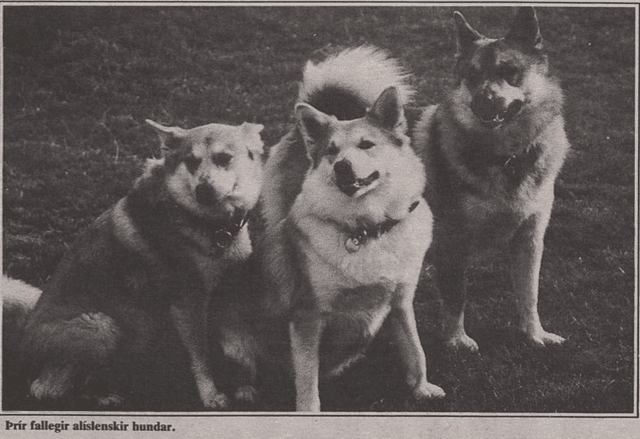
What is the status of the Icelandic Sheepdog today?
A few days ago, the Icelandic Kennel Club (HRFÍ) published [statistics](https://www.facebook.com/photo/?fbid=1408926503736202&set=pcb.1408927423736110) on puppy registrations from the past year. The Icelandic Sheepdog ranked fifth, with 100 registered puppies from 21 litters. In comparison, the Labrador Retriever ranked first, with 374 puppies from 55 litters. Last year, the Icelandic Sheepdog Department received a letter from a lecturer at the Agricultural University of Hvanneyri, stating that the Agricultural Genetic Resources Committee was developing a national plan for the protection and conservation of genetic resources in Icelandic nature and agriculture for the next five years. A specific section of the plan focuses on the Icelandic Sheepdog, and they requested information on the number of living Icelandic Sheepdogs in Iceland and abroad. As indicated in the board meeting minutes of DÍF (the Icelandic Sheepdog Department), the breeding committee is currently processing its reports to determine the actual size of the breed population in Iceland today. It will be very interesting to see what the actual population size is, as the [database](https://www.dif.is/hundarnir/hundar_grunnur_allir_skradir_hundar.php) only shows the number of dogs registered with HRFÍ since its inception. That number stood at 4,503 the last time it was checked, but it does not provide an exact count of how many are alive today. I found an [article from 1988](https://timarit.is/page/4051151#page/n1/mode/2up) stating that only 100–200 Icelandic Sheepdogs existed at the time and that there was significant concern about the small population size and the challenge of maintaining sufficient genetic diversity. The article also mentioned that Icelanders’ awareness of how valuable the Icelandic Sheepdog was had been relatively low at the time. However, there was strong demand from abroad for pure bred puppies from Iceland. Now I ask – perhaps once again – has that changed? Do Icelanders understand our national dog better now than they did 37 years ago? I cannot compare, as I moved to the country in 1995, but I feel that Icelanders are generally aware of their national dog. There are also more dogs now than in 1988, but I would like to see even more Icelandic Sheepdogs – not least as a part of the Icelandic countryside and as working companions for farmers. The 1988 article states that the price of a puppy at that time was 30,000 ISK. Today, the price is around 350,000 ISK, which, as far as I know, is the lowest price for a pure bred puppy with a pedigree from HRFÍ. Therefore, the price of our national dog should not be an obstacle for those who wish to own an Icelandic Sheepdog and thereby support the status of this national treasure.

New sponsor - Royal Canin
I have recently signed an agreement with Royal Canin, which will be a sponsor of the exhibition on the history of the Icelandic Sheepdog. I am especially delighted to collaborate with Royal Canin, which has long supported the Icelandic Sheepdog and is also a sponsor of the Icelandic Sheepdog Club (DÍF). Receiving this trust and support for the exhibition is a great honor for me and reinforces the significance of this project. I look forward to this partnership!
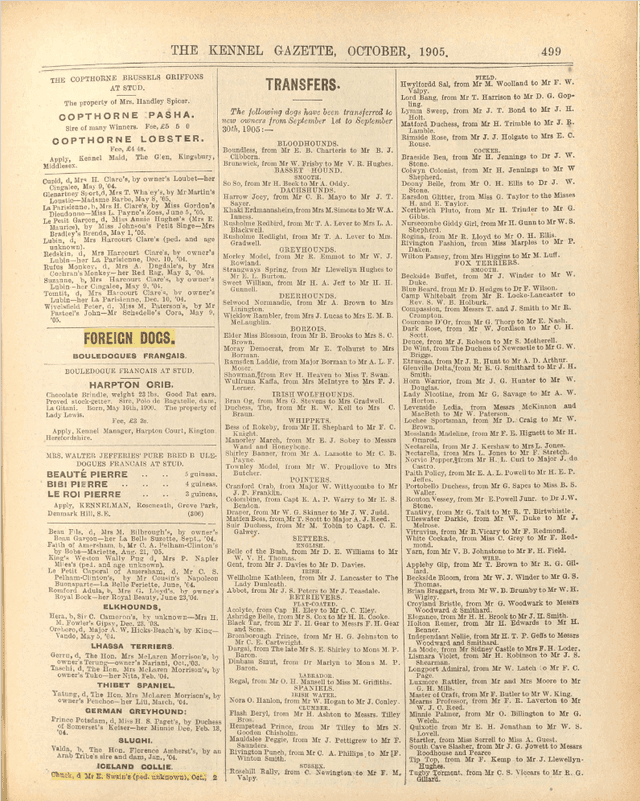
The Icelandic sheep dog in Great Britain
As mentioned in my previous blog post, The Kennel Club in Great Britain, has recently recognized the Icelandic Sheepdog as a breed. I also wrote about Vaskur from Þorvaldsstaðir, who performed exceptionally well at the Crufts show in 1960. I was certain that the breed had been recognized at that time, as Vaskur was allowed to participate in the show. However, I felt I needed to dive deeper into the matter. It is important that the information is correct, especially when sharing the history and facts about this remarkable breed. I wanted to be sure that I was not spreading incorrect information about the Icelandic Sheepdog and its history in Britain. I read articles, books, and other sources I had on hand, but in the end, I contacted The Kennel Club to get clarification on the situation at that time. It only took half a day to receive a very detailed reply from a staff member at the Kennel Club's library, for which I am extremely grateful, and I plan to share part of it here. The Kennel Club is the oldest dog kennel club in the world, founded in 1873. The Icelandic Sheepdog will soon become the newest recognized breed in Britain. However, several Icelandic Sheepdogs have been registered before. The dog Chuck was registered as an Icelandic Collie (in Britain, sheepdogs are often called collies) in October 1905. This was in the registration category "Any Other Variety Foreign or Colonial Dog," meaning the breed had not been recognized in the way we understand it today. This was simply a category for anything people wanted to register, and there were no confirmation processes in place. Registration in the "Any Other Variety" category was abolished in 1970. This register includes unique or rare dogs of various breeds that were never bred from. This applies to Chuck and the few Icelandic Sheepdogs that were registered in the same way in later years. Chuck was registered in the Kennel Gazette (see photo above) in November 1905 as a dog with "unknown pedigree." His owner was Mr. E. Swain, and the date October 2nd is listed with the registration. It is unclear whether this was Chuck's birth date or the day Mr. Swain acquired him. Typically, this date represents the birth date, but it raises questions about how Mr. Swain could not know at least one of the dog's parents if Chuck had been born a month earlier. Chuck was not registered as an imported dog, even though he likely should have been. In [Guðni Ágústsson's proposal](https://www.althingi.is/altext/117/s/0588.html) for the systematic breeding of the Icelandic Sheepdog in Iceland from 1993, it states: "In 1905, the Icelandic dog 'Chuck' was recorded in The English Kennel Club, and at the same time, the breed was recognized as such in England, and a breeding standard was issued, translated from Danish. Icelandic dogs have very rarely appeared at shows there, but Vaskur from Þorvaldsstöðum was the best in his class and competed for the title of 'Best in Show' at Crufts in 1960, when he was seven years old." There is much in this that is simply incorrect, and I would like to correct it here and now, although I cannot change this proposal. Chuck was not recorded in the pedigree, but he was registered in the "Any Other Variety Foreign or Colonial Dog" category. The breed was not recognized as such in England; that did not happen until 120 years later. The Kennel Club did not issue a breeding standard in 1905, but in the book _Dogs of All Nations_ by Count Henry De Bylandt, a breeding standard for the Icelandic dog is presented in four languages (French, English, German, and Dutch). It is likely that this standard was translated from Danish, but it is not entirely clear where Bylandt got it from when he published the book in 1897. Vaskur from Þorvaldsstöðum did not compete for the title of "Best in Show" in 1960, as he competed in the "Any Variety Not Classified at this Show" category and came first in that category. However, this did not give him the right to compete for "Best in Show," as the "Any Variety" category was a mixed category rather than a breed-specific category. A few years after Chuck was registered, two Icelandic Sheepdogs appeared at dog shows in Britain, also in the "Any Other Variety" category, in 1923 at the Birmingham National and 1925 at the Kensington Canine Society. These dogs were owned by Gwendoline Wingfield Digby, a well-known breeder at the time who specialized in another Spitz breed, the Keeshond. She imported both dogs directly from Iceland. They received significant media attention as novelties, as Icelandic Sheepdogs had never been seen at British dog shows before. In the book [_The Iceland Dog_](https://drive.proton.me/urls/MSZXKPRSBW#NJ3Xh5blzdvJ) by Mark Watson, there is a picture from the newspaper _Our Dogs_ showing the registration of these dogs: Mrs. G. Wingfield Digby. Langa of the Borgafiord (Icelandic Sheep Dog) b. June 1921. Br. Mr. E. Einarsson. Pedigree unknown. Mrs. G. Wingfield Digby. Hvita of the Borgafiord (Icelandic Sheep Dog) b. July 1922. Br. Mr. A. Sigurðsson. Pedigree unknown. In Watson's book, there is also an article in which Digby writes about Icelandic dogs: "In Iceland we found a dog of different type to any we had seen before, which was very interesting, as I had not seen it mentioned in the few textbooks I had been able to get hold of, although I have since read and seen pictures in travel books of exactly this type. Also, the dogs must have been peculiar to their country for a great number of years, as they are mentioned in Shakespeare. They are small—at least, they seem very small for a sheepdog, although, of course, everything up there is smaller than the rest of Europe—exceedingly alert, active, and very fast, well-built, with curly tail, broad chest, fine-drawn legs and muzzle, prick ears, and a strong coat, which always should look very shiny and well-kept. The dog does that for himself. If they come in dirty, they clean themselves in about ten minutes. In Iceland, I have seen men work these dogs over the river at a great distance from themselves by waving their arms. We noticed they were absolutely devoted to their masters, and some of them simply could not bear us—strange sort of people they had never seen before—coming anywhere near their belongings. When their masters sat down, the dogs immediately came and sat down and leaned against them. A curious fact is that they are never allowed in the house in Iceland. I suppose simply because the lack of accommodation is so acute there, but I find them to be quite the best of house dogs. They will learn anything, as they are so anxious to please, perfectly devoted and good watch dogs, and they are very strong and healthy. The colours are black and white. Black should predominate, or brown and black. I also saw them over there of a beautiful golden or chocolate color, with yellow eyes, but certainly, the greater number I saw were black ones with white on them." It was fascinating to receive this information, and I hope that the recognition of the Icelandic Sheepdog will lead to it gaining the deserved admiration and increased popularity in Britain in the coming years, as it has found its place there over the centuries, as [Shakespeare proved](https://www.fjarhundur.is/en/blog/shakespeare).

An unexpected call
My phone rang at 10:30 am on December 31st. “Hello, this is Ingibjörg, a journalist from RÚV. I’d like to check if you’re available for a short interview regarding news from Britain – that the British Kennel Club has recognized the Icelandic Sheepdog as a breed and what this means.” Well, I thought so! In addition to explaining what this recognition means for the breed, we talked about my project and the upcoming opening of the exhibition on the history of the Icelandic Sheepdog here at the farm. How wonderful to get an unexpected opportunity to introduce the exhibition to the nation on the last day of the year! The interview was broadcast on the midday news and also appeared on ruv.is. I’m still on cloud nine – not least because RÚV reached out to me, having already heard about me and the project. It was fantastic to end the year with this interview! For clarification regarding the news from Britain: the Icelandic Sheepdog was once a recognized breed by the British Kennel Club. For example, Vaskur frá Þorvaldsstöðum was selected as BOB (Best of Breed) at the Crufts dog show in 1960. Mark Watson brought him from Iceland to California and later to England. Only recognized breeds are allowed to participate in dog shows. Later, as too few individuals were registered in Britain, the breed lost its recognition. Now, after years of effort by owners and enthusiasts of the Icelandic Sheepdog, the breed has regained recognition, and it will once again be possible to breed and show the Icelandic Sheepdog in Britain. Congratulations! Note: correction of this in the next blog post! Collection of links [News The Guardian december 31st 2024](https://www.theguardian.com/lifeandstyle/2024/dec/31/icelandic-sheepdog-breed-mentioned-shakespeare-pedigree) [News on RÚV december 31st 2024](https://www.ruv.is/frettir/erlent/2024-12-31-islenski-fjarhundurinn-vidurkenndur-sem-tegund-432022) [Blogpost about Vask frá Þorvaldsstöðum, model for the HRFÍ logo](https://www.fjarhundur.is/en/blog/vaskur-fra-thorvaldsstodum-fyrirmynd-merkisins-hrfi)
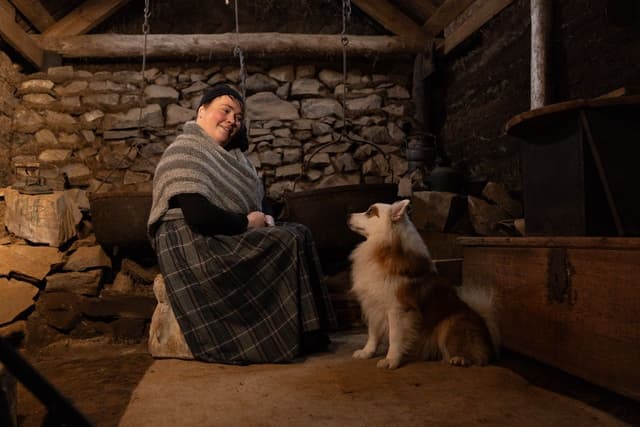
At the end of the year
At the end of the year, it is good to look back and reflect. Unfortunately, we did not manage to open the exhibition this year, as construction work was delayed due to a complicated application process and bad weather. I may have been overly optimistic at the start of the year, but it is optimism that drives us forward – isn’t it? I therefore had more time to prepare the exhibition, which turned out to be beneficial, as the project is larger than I initially envisioned. I would like to highlight some of the key things that were done in 2024 in preparation for the exhibition. In January, a dedicated section was opened on the website where stories about dogs were uploaded. Stories can be added at any time, and I encourage you to send me stories if you would like to share something about Icelandic sheepdogs – your own or others. Stories you have heard or read are also welcome. Including photos, if available, is always a bonus. In February, we brought in a film crew to record material (photos and videos) for the exhibition. This work was supported by a grant from the Development Fund for Northwest Iceland. In the spring, we invested in a beautiful house (pre-cut but unassembled) and began preparing the foundation. Most of the summer’s work focused on construction, and photos of the process can be seen on the project's Facebook page. In July, I attended an event at Glaumbær on Icelandic Sheepdog Day and was invited to present the project to visitors. The collaboration with the Skagafjörður Heritage Museum is very dear to me, and I look forward to continuing this partnership. In the autumn, I purchased several old pictures, primarily copper engravings of Icelandic sheepdogs. I found these treasures in antique shops in Europe and the United States, and they will be on display at the exhibition. I applied for additional grants to complete the preparation and installation, and I received positive responses from both the Ministry of Culture and Business Affairs and the Cultural Fund of the Skagafjörður Co-op. I am deeply grateful for this support. The autumn was also dedicated to continued reading, research, and writing. I now feel ready to take the final step, and I hope to be able to open the exhibition in April or May. Just before Christmas, we hosted an event on our farm and opened our turf house. Visitors also had the chance to peek inside the new building, even though it is not yet fully completed. We set up various items to provide insight into the upcoming exhibition, and the film material recorded in February was shown for the first time, which was very well received by our guests. I bid farewell to this year with immense gratitude to everyone who has supported me in this project, worked for me, encouraged me, given me a pat on the back, sent me books, stories, pictures, or other interesting materials. Last but not least, I thank my family for their patience and belief in my ideas, which I rarely tire of developing and bringing to life. Attached to this post is a photo taken in Glaumbær in February when we were allowed to record material there. Thank you for following along, and I wish you all a happy and peaceful new year.
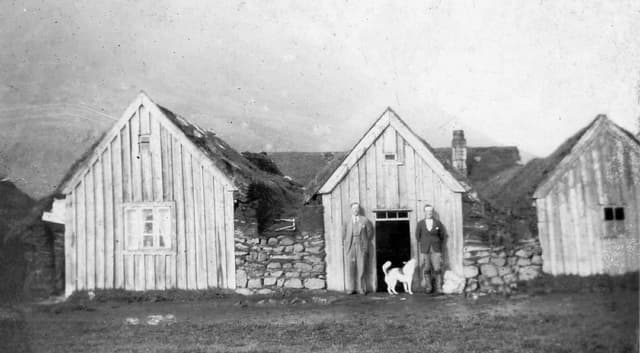
Icelandic National Customs
The book Íslenzkir þjóðhættir (Icelandic National Customs) by Reverend Jónas Jónasson from Hrafnagil is one of the most significant works of Icelandic culture and folklore. It is a unique depiction of the daily life and customs of Icelanders in the 19th century. Jónas Jónasson (1856–1918) was an Icelandic priest, teacher, and scholar, best known for this book, which was published in 1934, sixteen years after his death. The book preserves valuable records of Icelandic daily life, which would likely have been lost with modernization, and is considered one of the cornerstone works of Icelandic folklore studies. Beyond that, it is an enjoyable read, as it is written in a way that appeals not only to folklorists but also to the general public. The book includes a detailed chapter on dogs (pages 177–181), and the account is, in some ways, different from what we find in other writings. Jónas writes about the necessity of dogs for farmers and shepherds. He mentions that Icelanders have long been known for their fondness for dogs, letting them sleep beside them and having them clean their eating utensils. He notes that at Grenjaðarstaður in Þingeyjarsýsla, there were twelve dogs, though that was uncommon. In many places, however, one could see at least six dogs where there was significant livestock and farming activity. Jónas highlights various folk beliefs related to dogs, which I would like to present here: "A dog turns out best if it is raised during Þorri or Góa \[note: old Icelandic months\], as it will then be the right age to be trained with lambs in the spring." "Great care must be taken when choosing puppies to keep; firstly, they must not be born with their eyes open, for if they are, they must be killed immediately. Otherwise, they will disappear into the ground when they are three nights old, only to reappear at the same spot three years later. By then, they will have become such terrifying monsters that any creature that looks into their eyes will die. If such misfortune occurs, arrangements must be made for this abomination to see itself in a mirror upon emerging, as that will be its immediate end." "But there is another matter—to ensure that the dog raised will turn out well. Some say that one should choose the firstborn puppy, while others, and they are more numerous, say that the puppies should be taken from the mother after she has given birth and carried away from her sight. She will then take them back and place them in her den; the puppy she takes first will turn out the best and should be the one raised." "In places where shepherding took place in steep mountains, many preferred to have white or very light-colored dogs, as they are the easiest to spot when sent over long distances." "The loyalty of dogs has often been praised, but some shepherds have been unlucky enough to have dogs unwilling to follow them. To ensure a dog's loyalty, all one needs to do is give it a piece of food and rub the food in one's sweat. The dog will then willingly follow its master and become loyal to them." "Some dogs developed a tendency to be aggressive and bite the hind legs of sheep, even tearing them to injury. If they could not be trained out of this behavior in other ways, it was customary to break their fangs with a nail clipper; they were then unable to harm the sheep by biting." "Dogs are clairvoyant and can see people's guardian spirits and other apparitions; when dogs become restless and bark in the evening, either inside the farmhouse or outside, it is because they see spirits or something unclean brewing. When a sense of unease overtakes them due to something unclean wandering around nearby, they sit down and howl softly or emit a high-pitched whine, as it is called. They can also sense in other ways when guests are expected." "Dog skin is useful for many things. For example, mittens made from dog skin are exceptionally warm, as are socks and mittens made with dog hair mixed into wool. Dog fat is considered the best ointment for arthritis, bruises, sprains, and other injuries, and many still believe this to be true today." Fortunately, Jónas does not describe the preparation of dog skins or the production of dog fat, as that could be difficult reading in today's context. Following my review of the book, I would like to point out a [questionnaire on dogs available in Sarpur,](https://www.sarpur.is/Spurningaskra.aspx?ID=531295&page=0&pageSize=192) a cultural heritage database. The responses touch on many of the topics Jónas mentions in _Íslenzkir þjóðhættir_, and it is fascinating to read through them. It is only available in Icelandic, but with modern translation techniques, it should be accessible to anyone interested in these folklore topics. Image: Djúpadalur, 1930. Photographer unknown.
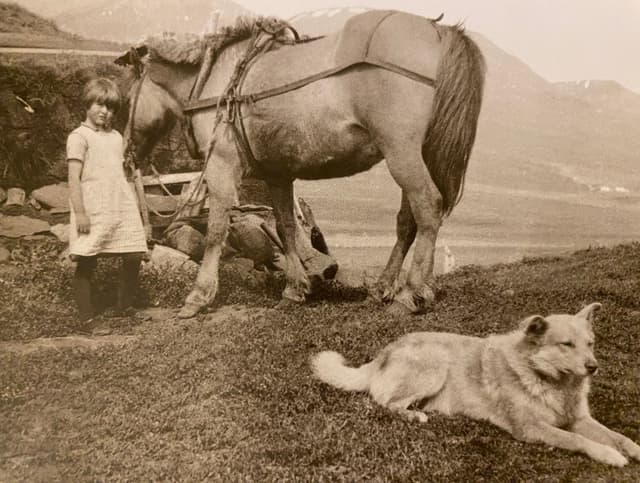
Description of Iceland, 1920
I have often wondered how Mark Watson managed to gather all the sources about Icelandic dogs for his book. How did he find the books he references? Did he travel between countries and libraries? Who translated? That would have taken him many years, but it doesn’t entirely align with everything else the man accomplished and stood for. Finally, I found an explanation in the book Lýsing Íslands - Description of Iceland -by Þorvaldur Thoroddsen, Volume Four, First Issue, printed in 1920. This book was one of the last I planned to include in my research, and I was fortunate to find it in an antiquarian bookstore, as this volume is not available in digital format. Lýsing Íslands is a comprehensive work in four volumes by Þorvaldur Thoroddsen. The first volume was published in 1881, and the final volume in 1920. This work was the result of many years of research by Þorvaldur, often conducted under challenging conditions. Þorvaldur Thoroddsen (1855–1921) was an Icelandic geologist and geographer, regarded as one of Iceland's most prominent scientists of his time. He traveled extensively across the country to collect data. Lýsing Íslands has retained its value and is still considered an essential source on Icelandic nature, geology, and geography. The fourth volume delves deeply into agriculture in Iceland, with the first issue covering livestock, gardening, and crop cultivation. Þorvaldur dedicates several pages to dogs, including a detailed account of their history in Iceland. He mentions the settlement period, the famine of 990, and Arnór Kerlingarnef's proposal, Sámur, Gunnar's dog from Hlíðarendi, as well as references to dogs in _Sturlunga saga_ and other sagas. He also discusses the export of Icelandic dogs during the Middle Ages and their popularity among English women. I find the following critique by Þorvaldur of the false stories that emerged in the 15th century regarding the export of Icelandic dogs to England particularly remarkable: "From this trade in dogs arose the false story that first appears with Martin Behaim in 1492, who writes about Icelanders: 'They are accustomed to selling their dogs at a high price, but they give their children to merchants for nothing, so the others may have food.' This has been repeated countless times by foreign geographical authors. Olaus Magnus writes in 1555 that Iceland has white dogs, furry and with hair like wool, which noblewomen and priests keep for their amusement. Blefken claims these dogs are earless and tailless. This is, however, undoubtedly nonsense. There is little reason to doubt that the small, white Icelandic furry dogs once existed, but they seem to have disappeared long ago; the breed may have died out in one of the canine epidemics." Regarding the typical Icelandic dogs, Þorvaldur writes: "They belong to the dog breed referred to as 'Spitz' dogs, similar to those found in northern Norway and Lapland, as they originally come from there. They are rather small, agile, and intelligent, with short but sharp snouts, erect, pointed ears, and a curled, furry tail. They come in various colors but are most often reddish-brown, and quite a few are also spotted." Þorvaldur harshly criticizes Icelanders for their poor treatment of dogs. He argues that the qualities of the Icelandic dog breed are not given the respect they deserve, as dogs are allowed to breed randomly, and many endure suffering from hunger and cold. He believes this treatment stems "mostly from the carelessness and neglect of people. Dogs have been despised and considered worthless. However, a good and well-trained dog is one of the greatest assets to a farmer and can be a true treasure on a rural homestead." Þorvaldur highlights the strengths of the Icelandic dog, which could be further enhanced through breeding, selective improvement, and proper upbringing. He describes them as excellent herding and sheepdogs, which can also serve as effective guard dogs, hunting dogs, and travel companions, for example, for managing horses and navigating paths in poor visibility. The keen sense of smell of these dogs has often proved useful for locating livestock buried in snow. On the relationship between humans and dogs, Þorvaldur writes: "Nowhere in Iceland have there been special houses, kennels, or shelters for dogs, as is customary in other countries. It has been common to send dogs outside in the evening, in weather that was 'fit for a dog,' as the saying goes, and then lock them out. They would have to fend for themselves outdoors, no matter the weather, curling up in window wells, haylofts, or other small shelters. On the other hand, in some places, there has been excessive pampering of them, or through thoughtlessness, they have been kept in too close contact with children and adults, slept in living rooms, licked utensils, and so on. As is well known, dogs acquire tapeworms from eating offal from sheep, and the eggs of these tapeworms can then enter human food, causing echinococcosis, which has been so widespread in Iceland and caused so much harm." Þorvaldur then delves deeper into echinococcosis, the dog tax, and diseases in dogs. Þorvaldur's descriptions in this book are an invaluable resource on dogs and dog ownership during this period, and it is fortunate that this information has been preserved in such detail. For Mark Watson, this book likely served as the foundation for his research and writings. Image: Bruno Schweizer
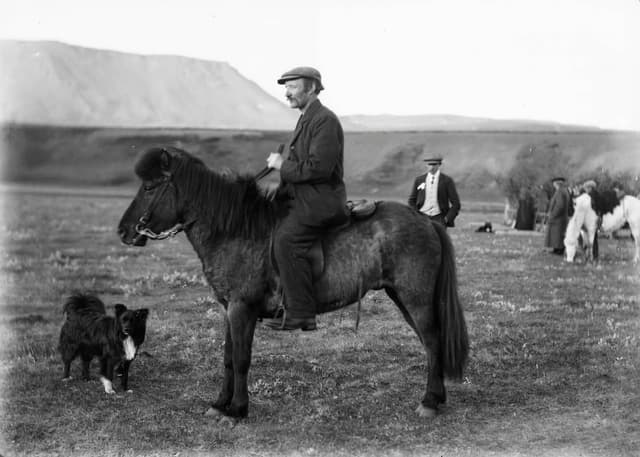
Dog Epidemics in Iceland
So-called dog epidemics or canine plagues have often occurred in Iceland, and they were frequently caused by highly lethal diseases. Historical records mention outbreaks among dogs in earlier centuries. In 1591, there are accounts of the deaths of cattle, dogs, and foxes across the country, with the disease reportedly brought to Iceland by an English dog in the western part of the island. In 1727 and 1728, a canine plague is mentioned in Snæfellsnes, during which livestock also perished rapidly. Between 1731 and 1733, there are reports of a pestilence affecting cattle, horses, dogs, and foxes. In the travel journal of Eggert Ólafsson and Bjarni Pálsson, the outbreak in South Iceland in 1731 is described: "The dogs and foxes became confused, but not rabid. Foxes wandered toward farms and were killed there." In 1786, a major canine plague struck Iceland. In 1827, a deadly epidemic affected dogs, making them so valuable afterward that some farmers were willing to give three sheep for a dog. In 1855, a canine plague swept through much of the country, devastating entire regions of dogs to the point that it became nearly impossible to herd livestock. It was said that the disease was so contagious that if a healthy dog sniffed a person from a farm where the plague had spread, it would fall ill immediately. The widespread lack of dogs caused significant difficulties, to the extent that a cow or horse was sometimes offered in exchange for a dog. "In the depths of winter, in March and April, 30 people from various northern regions—Bárðardalur, Eyjafjörður, and Skagafjörður—crossed the mountains via Sprengisandur, Eyfirðingavegur, and Kjölur to buy dogs in Árnessýsla and Rangárvallasýsla. The weather was favorable at the time, so the mountain journeys went well." In 1870, a severe canine plague struck northern Iceland, killing large numbers of dogs and leaving some households entirely without dogs. It was said that the plague had been introduced by an English dog accompanying an English traveler. The disease subsequently spread to western and southern Iceland. In 1871, Snorri Jónsson, a veterinarian, wrote in [_Heilbrigðistíðindi_:](https://timarit.is/page/2043924#page/n5/mode/2up) _"The dog is one of those animals that is rarely in short supply here in Iceland, but people only truly realize how much they depend on it when it is absent. When the canine epidemic swept through the country 16 years ago, many experienced how unbearable it is for anyone keeping livestock to be without a dog. This year, it seems that many will face the same situation; for although the dog epidemic has largely subsided in South Iceland, reports suggest it has begun in both North Iceland and the Eastfjords, and it is already proving quite severe. It therefore seems appropriate to say a few words about this disease here, and to touch on the main measures that can be taken to mitigate it."_ He further notes that this illness resembles _Febris catarrhalis epizootica canum_, which is known abroad, except that abroad, the disease only affects dogs younger than one year old. In Iceland, however, it is equally severe for dogs of all ages. The disease presents itself as follows: _"The illness usually begins with coughing and hoarseness. The nose is dry and hot. At the onset of the disease, clear fluid runs from the nose and eyes, which soon becomes pus-like. This stage can last for several days without the dog appearing very ill; but then the condition gradually worsens. The dog becomes weak, staggers on its legs, experiences seizures, and dies within a fortnight or sooner. Often, this disease is accompanied by severe headaches, causing the dog to act as if rabid—running back and forth, spinning in circles, and sometimes attempting to bite anything in its path. Weakness is always most pronounced in the hindquarters, and it is not uncommon for this weakness to persist even after the dog has otherwise recovered. It is also frequently observed that the dog appears semi-delirious after the illness, particularly if the headaches were severe. Blindness or impaired vision is also a common consequence of this disease."_ Snorri continues to urge people to take good care of their dogs, prevent them from coming into contact with healthy dogs, ensure they are not left outside at night, and provide them with sufficient nutritious food, especially meat. He also offers guidelines on various remedies that can be used to treat sick dogs. In the years 1888, 1892-93, and 1900, epidemics swept across various regions of Iceland, during which numerous dogs were infected and perished. Source: _Description of Iceland_ by Þorvaldur Thoroddsen. Volume Four, First Issue. 1920. Image: Hallgrímur Árni Gunnlaugsson (b. October 25, 1867), cooper from Raufarhöfn, riding. 1911. Photographer Bárður Sigurðsson.

Qualiscunque descriptio Islandiae
It doesn’t necessarily sound exciting to read a book titled Qualiscunque descriptio Islandiae from the 16th century, but what a feast it is, I must admit. Still, I had postponed starting this book, which I had ordered from an antiquarian bookstore earlier this autumn. The book is called Íslandslýsing in Icelandic and is believed to have been written by Oddur Einarsson. In the book's preface (by Jakob Benediktsson), it is revealed that the manuscript has had a rather tumultuous history and was not preserved in its entirety; it narrowly avoided being lost altogether. Various copies by scholars in the 17th century are thought to have been destroyed in the Copenhagen fire of 1728. However, one copy was rescued and taken to Hamburg, where it was preserved in the State and University Library. This manuscript remained unknown until the 20th century, when a librarian at the library, Fritz Burg, noticed it and finally published it in print in 1928. Burg had his own theory that the author of the manuscript was a schoolmaster in Skálholt named Sigurður Stefánsson, but Jakob Benediktsson points to several indications that Oddur Einarsson was the author. Among these are Oddur’s in-depth knowledge and detailed descriptions of northern and southern Iceland, which, according to Jakob, a resident of the south could not have had. But who was Oddur Einarsson? Oddur Einarsson (1559–1630) was born in Oddi, Rangárvellir, and received his education at Hólar School, where he became well acquainted with northern Iceland and the living conditions there. Later, he continued his studies in Copenhagen and Germany, focusing on theology and philosophy. In 1589, he was appointed Bishop of Skálholt, a position he held until his death in 1630. Oddur was a highly learned man and wrote _Íslandslýsing_ in Latin in 1593 to defend Iceland against the negative descriptions of foreign scholars, who often regarded the country as remote and barren. It is highly enjoyable to read his descriptions, for instance, of volcanic eruptions, hot springs, avalanches, and natural phenomena such as the northern lights. Particularly interesting are his accounts of birch forests, driftwood, and firewood. He describes the dwellings of the people of that time, providing a valuable source for how Icelandic turf houses developed into the 20th century. He recounts the relentless cunning and thievery of the Arctic fox and the polar bears that arrive on drift ice from Greenland. He describes livestock and domestic animals such as horses and dedicates an excellent section to dogs: _"Iceland is very rich in dogs. Some are farm dogs, bred to guard houses; others are herding dogs, fiercely eager to gather the flocks scattered throughout the mountains and valleys. Then there are those that are solely lapdogs, taught various tricks by country folk. Finally, there are hunting dogs, much larger and trained in entirely different ways. They are used for fox hunting, tracking down the fox with incredible skill—not only by sight or sound but also by scenting the tracks of their prey. When they catch the fox, they either bite off its head, tear it apart, or strangle it without causing damage, depending on their level of ferocity. Additionally, farmers use various techniques to ambush the fox and avenge its cunning and theft."_ When I read these descriptions, I see the Icelandic dog as we know it today: a blend of the best qualities of these dogs. They guard houses, herd flocks, are pampered, and can be taught tricks. They are highly skilled trackers and possess excellent scenting abilities. From the three types of dogs frequently mentioned well into the 18th century (e.g., by Eggert Ólafsson and Bjarni Pálsson, 1752–1757), the dog we have today emerged. For me, this explains the versatility that the Icelandic dog embodies today. Image: From a 16th-century manuscript in the Árni Magnússon Institute.
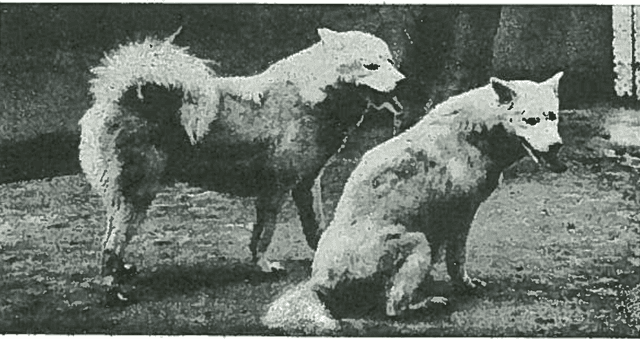
Zoological garden in Copenhagen
The Icelandic dog has long been popular in Denmark, as can also be seen in the blog posts about Njord, Pillar, and Schierbeck. In the Danish magazine VORE HUNDE from 1898, [an article by Eugen Colding](https://drive.proton.me/urls/MHDE8XE8QR#DiBpN4PYfz5e) was published in which he writes about the Zoo's plan to focus on three national dogs: the Great Dane, the Icelandic Sheepdog, and the Greenland Dog. Here is a translation of this article: The Zoo "The Zoo in Copenhagen intends to focus on three national dogs: the Great Dane, the Icelandic Sheepdog, and the Greenland Dog, in addition to other breeds. At present, the Zoo owns no Icelandic dogs, but this is only a question of time. The picture shows the last descendant of the Zoo’s previous population of this breed. It died here, and now - in accordance with Mr. Hoffmann-Bang’s custom with all animals that die in the Zoo - it decorates the wall of his home. This is a beautiful act and well-suited to the animal lover that Mr. Hoffmann-Bang is. Icelandic dogs are primarily found in Aalborg in this country - some of which were previously purchased by Captain Christensen for the War Ministry to be trained as war dogs, while others were bred by the Captain himself. However, experiments with Icelandic dogs in military service were discontinued, and the dogs have since been transferred to various owners. At the Tivoli Dog Show in 1897-98, “Yips,” owned by Sergeant P.C. Hansen, won 2 first prizes; “Svartur,” owned by Sergeant Steen, won 2 second prizes and 1 third prize; and “Pillar,” owned by Sergeant T. Lindholm, won 2 first prizes and a cup. A few specimens can also be found in Copenhagen." This plan never came to fruition, and the dogs in the picture were the last Icelandic dogs to reside in the Copenhagen Zoo. Additionally, the breeding of Nordic dogs was discontinued.

Canis Islandicus
I would like to compile a few descriptions of the Icelandic dog from the late modern period (18th and 19th centuries) that I have not previously mentioned in my blog. Mark Watson provides an excellent summary in his book [_The Iceland Dog 874-1956_](https://drive.proton.me/urls/MSZXKPRSBW#NJ3Xh5blzdvJ). I was unable to find all the original texts, but where I succeeded, I have included links behind the book titles. The Icelandic dog (_Canis familiaris Islandicus_) was the only dog breed in Iceland during the 18th and 19th centuries and naturally attracted the interest of foreign visitors. It is frequently described in historical texts, both in connection with travels to Iceland and in encyclopedias. Its physical characteristics are often detailed, such as erect ears (though descriptions are not always consistent), a thick coat in a variety of colors, and a curled tail, as well as its roles and uses. It is noteworthy that the Icelandic dog is often compared to the Greenland dog. 1791 Encyclopedia Britannica "The first species is the pastoralis, or shepherd'-s dog; which is the same that isused at present, either in guarding our flocks, or in driving herds of cattle. This kind is so well trained for these purposes as to attend every part of the herd, be it ever so large; confine them to the road; and force in every straggler, without doing it the least injury....The Iceland Dog is the only one that has not his ears entirely erect; for their extremities are a little inclined; and Iceland, of all the northern regions has been longest inhabited by half civilized men." [1792 THE ANIMAL KINGDOM or Zoological System of the celebrated Sir Charles Linnaeus](https://archive.org/details/animalkingdomorz00linn/page/130/mode/2up) "The ears are erect, with pendulous points; and the hair is universally long, except on the snout, which is short." [1813 JOURNAL OF A TOUR IN ICELAND IN THE SUMMER OF 1809, by William Jackson Hooker](https://archive.org/details/journaloftourini00hook/page/276/mode/2up) Among the domestic animals in the island, the dog deserves the first place, not only as the companion and solace of the natives as we 11 as the guard of, their houses, but as being of essential service in their agricultural pursuits, by keeping the horses from eating the grass intended for hay, and by collecting the sheep scattered over the mountains, and driving them to the milking places. Hence they abound throughout the country, and few huts are unprovided with one or two of them. The Fi a a r h u n du r of the Icelanders (Canis lslandicus of some authors) if it has not sufficient characters to rank it as a species, is at least a very strongly marked variety; differing in many points from any of the dogs I have elsewhere seen but most nearly approaching the figures and descriptions that we are given of the Greenland dog. It is rather below the middle size, well proportioned in its parts, having a short and a sharp nose, much resembling that of a fox and small erect pointed ears, of which the tips only, especially in the young animal, hang down. The hair is coarse, straight, and thick, very variable in colour, but most frequently of a greyish brown; the tail long and bushy, and always carried curled over the back." [1811 TRAVELS IN THE ISLAND OF ICELAND during the summer of the year MDCCCX. By Sir George Steuart Mackenzie](https://archive.org/details/Travelsintheisla000253532v0MackReyk/page/n397/mode/2up?q=dogs) "The dogs which are generally seen in Iceland, bear a strong resemblance to those of Greenland. Like them they are covered with long hair, forming about their necks a kind of ruff. Their noses are sharp, their ears pointed, and their tails bushy, and curled over their backs. Their predominant colour is white; yet they vary considerably; and some are entirely brown or black. Very few of them can be induced to go into the water; and though some are of service in guarding the cottages and flocks, and preventing the horses from eating the grass intended for hay, yet the greater number appear very useless. Scarcely any family, however, is without one or two of them." [1829 BIOGRAPHICAL SKETCHES AND AUTHENTIC ANECDOTES OF DOGS. By Thomas Brown](https://archive.org/details/biographicalske00browgoog/page/186/mode/2up) "This variety of the dog bears a strong resemblance to that of Greenland, differing, however, in the hair and woolly fur not being quite so long. His head is nearly of the same shape, with pricked ears, slightly turned downwards at the tips. His general colour is white, with large patches of black over different parts of the body. In some few instances they are found altogether black The Iceland Dog is frequently of great use to the natives, especially while travelling in winter through the snowy, trackless, and extensive deserts with which that country abounds, as he is oflen their only compa\ nion in these excursions. His instinctive sagacity is of much service to his master while journeying through those regions, for he will forewarn him of a coming storm by skipping and yelling ; and if far from a village, will frequently discover a snug shelter among the rocks for hinpiself and his fellow-traveller. If he is forced to attempt the passage of an unfordable current he sets up a most hideous howling." 1840 THE NATURALISTS LIBRARY MAMMALIA. VOL. X. Sir William Jardine "The Norwegian emigrants to Iceland seem to have carried a race of dogs to its shores which at present is not found in the parent country. The head is rounder, and the snout more pointed, than the preceding. In stature, it is not larger than that of Kamtschatka, and in fur like the Esquimaux; the ears are upright, and the lips flaccid; the colours white and black, or white and brown. This race is somewhat allied to the following, and therefore may have been obtained from the Skrelings or Esquimaux, by the adventureres who first visited Greenland.'' [1863: ICELAND: ITS SCENES AND SAGAS. By Sabine Baring Gould](https://archive.org/details/icelanditsscenes00bari/page/58/mode/2up) "The Icelandic dog (Canis familiaris Islandicus) has been already briefly described in the Introduction: its head is just like that of a fox; it is small, has sharp eyes, short legs, a profusion of hair, a ruff round the neck, a tail curled over the back, and it is generally of a white, dappled, or tawny colour. In Iceland the different kinds of dogs are distinguished by different names. The sheep-dog is fjárhundr; the hound, veithihundr; the dog which can follow scent, rakkr ; the poodle, lubbr ; the house-dog, bærhundr ; and the lap-dog, mjóhundr. The farm, at the door of which Grimr and I reined up, is celebrated for its breed of dogs. The price of a puppy is about a dollar, but the traveller had better not purchase one, as it will not live in England. A skipper, who visited Iceland yearly, informed us that he had brought a dog with him to Leith on his return from every cruise, but that he had never been able to rear any, with the exception of a pup bom on the voyage." [1875: ULTIMA THULE OR, A SUMMER IN ICELAND, by Richard F. Burton](https://archive.org/details/ultimathuleorsum01burt/page/171/mode/2up) The Fjarhundr or shepherd-dog (C. Islandicus), according to Mackenzie, is of the Greenland breed ; the " prick-eared cur " certainly resembles the Eskimo, sometimes with a dash of our collie. Formerly they were far more numerous than men ; and old authors mention several breeds — "lubbar" or shag-dogs ; dýrhundar, deer or fox hounds, and dverg-hundar, dwarf hounds or lapdogs. Foreign animals are now rare; the common sort is a little "pariah," not unlike the Pomeranian; stunted, shortbacked, and sharp-snouted, with ruffed neck and bushy tail, or rather brush, curling and recurling. The colour is mostly brownblack, some are light -brown, deep-black, white, and piebald. Those brought to Reykjavik appear shy, savage, and snappish as foxes. Formerly they were trained to keep caravan-ponies on the path ; now they guard the flocks, loiter about the farms, and keep cattle off the "tún." Good specimens easily fetch $6; a horse may be exchanged for the most valuable, those which, they say, can search a sheep under nine ells of snow. They are accused of propagating amongst their masters, hydatic disease and intestinal worms (Tænia echinococcus) ; and this consideration induced the Althing, in 1871, magno cum risu of the public, who asked why the cats were not assessed, to impose an annual dog-tax of $2 per head upon all exceeding a certain number on each farm — it will cause the premature death of many a promising pup. Half of the amount is the perquisite of the Hreppstjórar, the other moiety goes to the Treasury. The danger would be less if the dogs were not so often allowed to lick the platters clean, and to perform other and similar domestic duties." 1887 HUNDEN OG HUNDERACERNE (THE DOG AND DOG BREEDS) by Viggo Moeller "The ICELAND DQG resembles the GREENLAND DOG, but is smaller, more slenderly built and more long-legged. It is somewhat under medium size, being only 10¼-15 ½ inches tall, and if anything should be described as small. The head is comparatively larget with a broad, high -domed skull, rather pointed muzzle and tight lips. The ears are large, broad at the base, pointed (triangular) and upright. The eyes are small, round and dark in colour. Head and neck are carried high. The body .is lightly built, with a comparatively short back, broad in front, deep chest. Belly drawn up. Legs slender, well set and well shaped. The foot is long with small, curved claws. The bushy tail is carried curled up over the back. The coat is of medium length, longest on the haunches, the tail and the underside of the belly, and it lies close to the body. On the muzzle and legs it is short, and there is no plumed fringe on the front legs. The colour is commonly brownish or greyish and dirty white or yellowish. A usual colour distribution is: back black, underside of the body and limbs white, with the latter colour also on the underside of the tail and its tip, and as a collar around the throat. For this type of dog the Icelanders have a special name: strútóttur, i.e. with a collar around the throat. Dr. Krabbe has obtained a couple of stuffed specimens of this type for the museum of the Royal Veterinary and Agricultural High School of Denmark. The breed is well defined on the whole, though not quite pure near the commercialcenters to which foreign dogs have been imported. Dr. Fitzinger describes various types of Iceland Dogs and distinguishes between Fjaar•hundar, Dyr-hundar, Dvaerg-hundar and Lubbar, but now there is only one breed. Dr. Krabbe, who has visited the island for the purpose of studying domestic animals there, has given an interesting description of the Icelanders' dog-keeping. I take the liberty of quoting the following from his article in Tidsskrift for Landoekonomi (Journal of Agronomy): As will be known, the Icelanders' chief occupation apart from fishery is sheepraising, particularly for those who do not live immediately on the coasts. The dogs are not used to watch the sheep, for all summer they roam freely. Only the milch ewes are gathered close to the farms. All the rest are driven up into the mountains to graze and are not taken home before autumn. But the dogs are excellent at rounding up the sheep and particularlz at fetching them down from inaccessible hills. They also make themselves useful by keeping the horses collected on journeys and by keeping the live stock away from the tún (home meadow)....." Picture: Interior of Shepherd's Hut, Iceland eftir Bayard Taylor, 1862
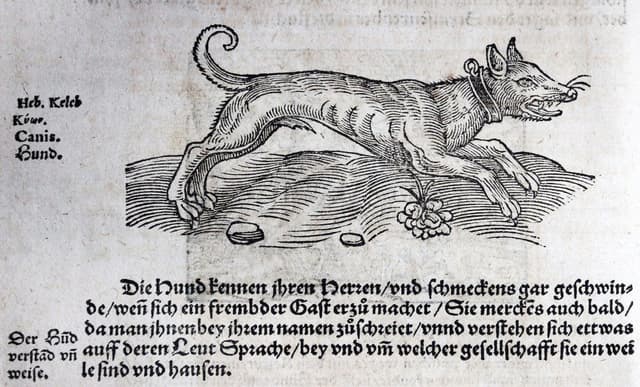
Bastard of the dog and the fox
Sir Thomas Browne (1605–1682) was an English physician, scholar, and author known for his diverse works on religion, science, philosophy, and nature. He was renowned for his poetic and elegant writing style and the profound insight in his works. One of his most famous works is [_Pseudodoxia Epidemica_ (1646)](https://archive.org/details/BrownePseudodoxia1650Clark/page/n3/mode/2up), also known as Vulgar Errors. In this work, he examines common misconceptions and myths of his time, attempting to correct them through reasoning and scientific observation. Among other topics, he discusses the notion that the Icelandic dog, which was imported to Britain and valued both as a working dog and a family pet, could be a hybrid between a dog and a fox ("Bastard of the dog and the fox"). He rejected this idea, pointing out that, despite their similar appearance, dogs and foxes are biologically incompatible. Picture: Plinius, 1565
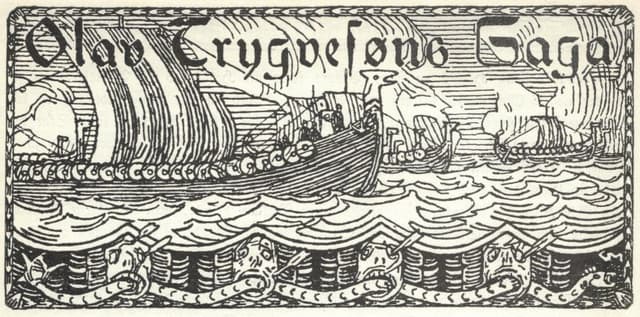
Famine around the year 990
In the _Saga of King Ólafur Tryggvason_, it is mentioned that around the year 990, there was a famine in the country. Arnór kerlingarnefur then proposed that most, if not all, of the dogs in the country should be killed, as their large numbers meant that many human lives could be saved if the food used to feed the dogs was redirected. However, the farmers did not follow this advice, and the dogs were spared. This chapter is part of the summaries about the history of the Icelandic sheepdog, which can be found online. Notable among these is a proposal by Guðni Ágústsson, a member of parliament, from February 15, 1994, where he presented ideas to promote the stature and respect for the Icelandic sheepdog. See my [blog post](https://www.fjarhundur.is/en/blog/lifandi_listaverk) and an article about Gísli Pálssons book The Icelandic Sheepdog from [_Morgunblaðið_](https://timarit.is/page/1954753#page/n11/mode/2up) dated December 19, 1999. I have long wanted to look up this story, and I spent a good amount of time on it today. I found an English version of the [_Saga of King Ólafur Tryggvason_](https://drive.proton.me/urls/05E2CBKNWR#EEDXrZsbNOW2), and Chapter 226 on page 360 describes the events that led Arnór to make this proposal. I have not been able to find this chapter in an Icelandic version, but it seems to me that the story is only found in Ólafs saga Tryggvasonar hin mesta ("The Saga of Ólafur Tryggvason the greatest"). This saga was composed around 1300 and is based, among other sources, on the _Saga of Ólafur Tryggvason_ as compiled by Snorri Sturluson in [_Heimskringla_](https://drive.proton.me/urls/PBR4RP0P9G#1LOrGUFGULRV). However, it expands the narrative with additional material. A later version of Ólafs saga Tryggvasonar hin mesta is preserved in _Flateyjarbók_, where the saga is significantly expanded by inserting entire stories or chapters from other sagas connected to King Ólafur Tryggvason. I was not able to examine _Flateyjarbók_ today to find the original Icelandic text, but perhaps that will be a task for another time—who knows? Nevertheless, I am pleased to have found the context surrounding Arnór's proposal.
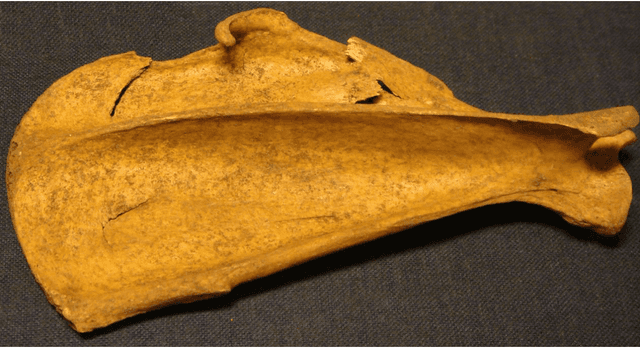
Archaeological Research
After writing the post about [Dogs during the Settlement Age](https://www.fjarhundur.is/en/blog/hundar-a-landnamsold), I wanted to delve deeper into archaeological studies to enhance my knowledge and gain more insight. Little is known about the appearance of dogs during the Settlement Age, but it is clear that they accompanied the settlers to Iceland in the 9th century. We know that dogs served various purposes and therefore differed in type. Some followed chieftains in both peace and war, such as Sámur, Gunnar's dog at Hlíðarendi, who is believed to have been an Irish wolfhound used for hunting. Small dogs, on the other hand, were known as pets of the aristocracy and clergy. Most settlers were farmers. Their livestock roamed freely and did not stay in groups, as the animals had no natural predators and dispersed widely. Dogs were therefore used to herd the livestock together and drive them home. Neither wolfhounds nor small dogs were suitable for this task in Iceland's vast landscape. However, sheepdogs became indispensable companions for farmers. Archaeological research has shed light on the types of dogs present during Iceland's early settlement years and on the relationships between humans and dogs at the time. Dog bones have been found in 32 Viking Age burials. Animal bone studies in Iceland began in the 19th century. For example, a Viking Age burial was discovered at Hafurbjarnastaðir in 1868, where bones of a horse and a dog were excavated. "Dogs in the Viking Age varied more in appearance than the Icelandic breed today, and they were sometimes buried with humans. It was rarer to kill and bury dogs, and this practice was not as established as horse sacrifices. Dogs always shared a grave with a human, but sometimes only part of their body was buried. Marks on the bones of some dogs indicate that they were well cared for in life, supporting the interpretation that they were buried with their owners." ([Rúnar Leifsson, _Ritual Animal Killing and Burial Customs_, 2018)](https://drive.proton.me/urls/J9DSCKP9SR#2gQ9MSu4H4kW). In studies of dog bones, old, healed fractures have been identified in some cases, and sometimes teeth are missing. It is believed that the dogs were buried in this condition. Such injuries may indicate violence or mistreatment, which is rarely seen in connection with livestock. However, the relationship between humans and dogs has always been characterized by strong emotional bonds. Dogs were much closer to their owners than other animals and often served as companions and loyal friends. (Rúnar Leifsson). It is also interesting to read about how dogs were placed in human graves. Unlike horses, they always accompanied a human and were never buried alone. The placement of the dogs strongly indicates close bonds between humans and animals. Most commonly, the dog's body was placed at the feet of the deceased. This might have mimicked a dog crouching and resting at its owner's side, just as it would in life. In two cases, the connection between human and dog was even closer. In Gautlönd, in southern Þingeyjarsýsla, a man was buried lying on his side in the so-called "fetal position," with a dog placed under one of his knees. A similar placement of a dog is likely in a grave at Dalvík (Brimnes) in Eyjafjörður. Archaeologists there concluded that the deceased was buried in a seated position, with the dog resting between their legs. It is unclear how dogs were killed for burial rituals in most cases. This is partly due to poor preservation and sometimes due to the random selection of samples during excavation. It may also be because some methods of killing left no traces on the bones. The only recorded evidence so far suggests that it was done using poleaxing (blunt force). Beyond Rúnar Leifsson's doctoral dissertation (written in English), which I have largely used as a source for this post, Kristján Eldjárn's book _Kuml og haugfé_ (1956) is an invaluable resource for those interested in archaeological studies of graves and burials in the 20th century. Additionally, the publication [_Margt býr í moldinni_](https://drive.proton.me/urls/DZXJT7S52G#nI12j4ZMGmm8) by the Skagafjörður Heritage Museum, which discusses research in the archaeological environment of Skagafjörður from 2000 to 2005, is very interesting and provides accessible knowledge for the public. In research conducted in Skagafjörður, dog bones were found at the places Kolkuós and Keldudalur. Kolkuós was one of the main trading ports in Iceland from the Settlement Age until the 16th century and is located near Hólar, which became a bishop's seat in 1106. Among the finds at Kolkuós were dog bones, including those from a Maltese lapdog, a pet associated with European aristocracy during the Middle Ages. This is the first time such remains have been discovered in Iceland. At the farm Keldudalur, a burial site and remnants of a Christian cemetery were accidentally discovered. Dog bones were found in two graves. In one, bones from an Icelandic dog were identified, while in the other, remains of a so-called "nobleman’s dog" or "Greyhound" were uncovered. Large dogs are known from the sagas, such as the aforementioned Sámur, Gunnar’s dog at Hlíðarendi. Such dogs were not owned by commoners, and these finds, like the lapdog bones at Kolkuós, suggest that dogs were imported as status symbols for local chieftains. (_Margt býr í moldinni_). Picture: right dog scalpula, found in Vatnsdalur. From: [(Rúnar Leifsson. Ritual Animal Killing and Burial Customs. 2018).](https://drive.proton.me/urls/J9DSCKP9SR#2gQ9MSu4H4kW)
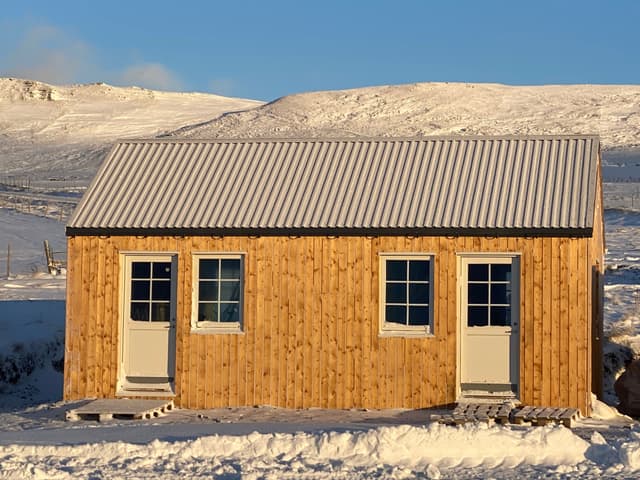
Short news
It’s starting to feel like winter outside, and now there’s time to focus intensively on the final stretch for the exhibition. The building is now insulated on the inside, but there’s still plenty left to do. I continue reading and researching, but I also recently traveled abroad and took the opportunity to visit several museums. It’s always fun and educational to see how museums present and process material for exhibitions – which is usually just a small fraction of what’s "behind the scenes." I submitted a grant application this fall, and I hope to receive a positive response. I’ve said before that without the grants I’ve already received, it wouldn’t have been possible to make all of this happen. Regardless of the outcome, the research work over the past two years has been incredibly interesting and educational. I was very pleased to see a post on Facebook the other day by a well-known Icelandic writer and storyteller about the history of the Icelandic sheepdog, where the primary source cited was a blog post from me here on this site about the origins of the Icelandic dog. This shows me that I’m doing something noteworthy here. I plan to hold an open day during Advent to introduce the project and showcase the first visible museum artifacts to my local community.
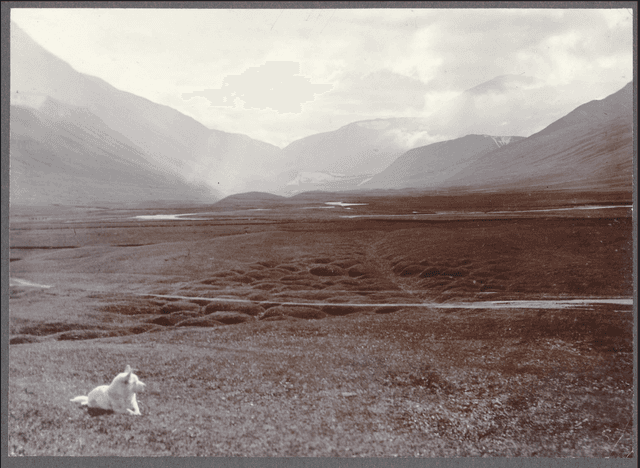
Dogs during the settlement of Iceland
There are no written records or detailed descriptions from the Age of Settlement. Our knowledge comes mainly from the books _Landnámabók_ and _Íslendingabók_, which are both from the 12th century. There are few sources regarding dogs from the first centuries of settlement in Iceland. No descriptions of sheepdogs can be found in the _Icelandic sagas_, and there is very little mention of dogs in general. However, one can mention Gunnar at Hlíðarendi’s dog, Sámur, who is believed to have been an Irish wolfhound. Knowledge comes also from archaeological investigations. In Keldudal in Hegranes in Skagafjörður, a burial site was accidentally discovered when the foundation for a new guesthouse was being dug. Upon initial investigation, it became clear that this was the remains of a Christian burial ground, and that it was at least partially older than the Hekla eruption in 1104. Later, a burial mound area was also found on the site. In extensive archaeological investigations conducted in 2002–2003, not only human remains were found, but also animal bones in several burial mounds. Some of these were from full-grown tall and short-legged dogs, which tells us about the existence of dogs in various sizes and "types" shortly after the Age of Settlement. Interested parties are referred to the [investigation report.](https://www.glaumbaer.is/static/files/pdf/Rannsoknarskyrslur/bsk-2013-135-keldudalur-i-hegranesi-2002-2003.pdf) As far as I can see unfortunately only available in Icelandic. Although we have only limited sources from the Age of Settlement, we can imagine how the dog, which later became the Icelandic Sheepdog, came to the country and became part of daily life, in both joy and sorrow. Let us now turn to a story found in the book [_The Icelandic Sheepdog: The Dog of the Vikings_](https://www.amazon.com/-/de/dp/B0CTXFXBFP/ref=sr_1_1?__mk_de_DE=%C3%85M%C3%85%C5%BD%C3%95%C3%91&crid=3KO80S3TVFP2V&dib=eyJ2IjoiMSJ9.KKoPt-Sp8bbQESMfuZdsRvxS_u5scLmbD34te5uG78ATgFTI8X50WmepSZYTxJWBKecVwRXPPI2QYcypKsEecfXiABDFXH31-jTOFvYU5rPGbUZOm_kG5HRpiOuXm7QHgl9cWhRqGECUE-3TXYlzGFksTYUommn1Tnbr_LsfRx6bh74HM6ZOrgJqIEh-qq4HTCFh21nAMyrAD42izvCPlkCsWmyuXDt7gaIJP14pPQI.zcXY1hx1-7fQz7vvkCTNMzjxBLZhQHhZb4WpNqyHCOo&dib_tag=se&keywords=the+Icelandic+sheepdog&qid=1729243660&sprefix=the+icelandic+sheepdog%2Caps%2C213&sr=8-1) by Tom Verbeeck, which was published earlier this year and is an excellent read for friends of the Icelandic Sheepdog. In the book, Tom discusses the relationship between the Vikings and their dogs, which I find particularly fascinating because it gives us some insight into how they chose their dogs before embarking on their journey to Iceland. "The journey from the mainland to Iceland was quite an undertaking. Most people who ventured on the crossing were small farming families, drawn by the promise of land and freedom. There are no written sources that tell us about the crossing, but most likely, a farmer who had taken the leap would have told the following story: In the late summer, as the days began to shorten and a cool breeze crept through the air, I gathered with my family our most valuable possessions. We had heard the stories, the rumors of an untamed land in the north waiting to be discovered and inhabited. Iceland, so the winds whispered, offered a fresh start, a chance for a better life amidst the abundant resources and space of the unknown land. Our knarr, a sturdy trading ship that served as a sort of home away from home, lay ready at the rugged coast. Her hull had cleaved through the fierce waves of many seas, and now she was poised to carry us, brave souls, to the promise of a new future. The knarr, laden with wooden crates, food supplies, and clothing, also provided space for a farmer's most cherished possession: his herd. The sun reflected off the sparkling waters as we guided our sheep, cattle, and horses into the cargo hold. Straw and hay were carefully spread to provide a comfortable shelter for our faithful companions during the long journey ahead. The air was filled with a mixture of excitement and nervousness, for while we dreamed of a fresh start, we knew the path would not be without its challenges. The sail was hoisted, and the wind propelled our knarr forward with powerful gusts. The seas were unpredictable, at times rough and wild, then calm and reassuring. Days passed as we sailed northward, the horizon always shrouded in a haze of hope and promise. Our dogs, faithful companions who were as much a part of our family as the livestock we transported, barked excitedly as they roamed the ship back and forth. The journey was no simple feat. Along the way, we faced challenges, from rough storms to calm days where we longed for the land we hoped to reach. But eventually, after weeks of determination and perseverance, the rugged coast of Iceland loomed before us. We felt the tension in the air as we stepped ashore and carefully led our animals onto land. The ground beneath our feet was rough and untouched, a canvas waiting to be shaped and cultivated by us. We were pioneers, intrepid farmers embarking on a new life in this unknown land. With the knarr in the distance, rocking on the waves, as a witness, we began to establish our settlement, our sheep and cattle grazing on the vast meadows, while our dogs eagerly scanned the hills for signs of life. Thus began our adventure in Iceland, with our ships as silent witnesses to our determination and perseverance. The knarr and its crew, with livestock and dogs on board, brought us to a new chapter of our lives, where we planted our dreams and hopes in the fertile soil and began to forge our future in the rugged landscape of the unknown land. With each passing day, our bonds with the land grew stronger and deeper. Our sheep grazed on flower-strewn hillsides, finding sustenance amid the lush vegetation. The cattle traversed the valleys, seeking respite by clear streams, while our horses tested their sturdy legs on the rugged paths we began to forge. Our dogs, loyal companions seamlessly adapted to our new life, were indispensable. They raced eagerly across the hills, searching for our scattered herds. Their keen senses and vigilant nature aided not only in guarding our livestock against potential threats but also in guiding the sheep back home once found. The barking of the dogs filled the air as they led the herd back to the farm, their tails proudly curled on their backs. During lambing season, we kept our sheep close, knowing the vulnerable newborns required extra care and protection. Our dogs were ever-present, their watchful gaze on the lookout to deter potential birds of prey eyeing our precious lambs. Their actions akin to a dance of protection and care, tirelessly guarding the herds and aiding us in preventing a loss that would hinder our efforts. Our settlement grew and flourished, through the hard work of our hands and the faithful dedication of our animals. The dogs always by our side. During the day, they played an active role in the farm work; herding the livestock, guarding the property, and offering a helping paw where needed. In the evenings and nights, lounging at our feet or on the bed, sharing their warmth with us on cold dark nights. The seasons changed and the years passed. Our dogs were not just guardians and workers, but also beloved companions and friends. They shared our joys and sorrows, our triumphs and setbacks. And as we shaped our new life in Iceland, the dogs became a vibrant thread in the fabric of our existence, a constant reminder of our connection to the land, the livestock, and each other. And so, the history of our settlement is infused with the presence and dedication of these remarkable animals. They were part of our daily life and formed an indelible part of our memories. Their loyalty, devotion, and versatility aided us at every step of our adventure in Iceland, and their legacy lives on in the hearts of us and future generations." Thank you for taking us along on this journey, Tom!
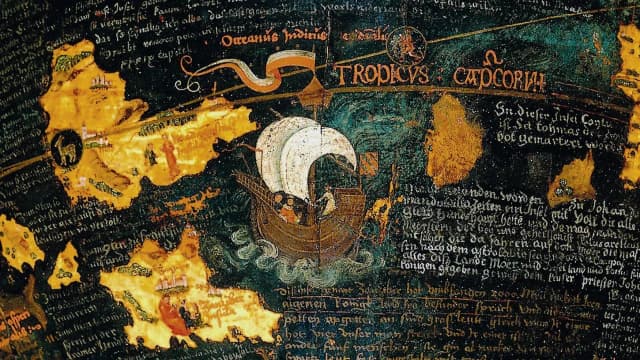
Martin Behaim 1492
Another name that appears in the historical accounts of the Icelandic sheepdog is Martin Behaim, and here I will briefly summarize a few words about him. Martin Behaim (1459–1507) was a German cartographer, explorer, and merchant from Nuremberg. He is best known for having created the oldest surviving globe, the so-called ["Erdapfel" (1492)](https://globus1492.gnm.de/en). On the globe, all the known lands of the time are depicted, as they were before the discovery of America. Much is written on the globe about the countries, including a small note about Iceland. Iceland is placed north of the northwest corner of Scotland, a bit north of the Arctic Circle. It is oval-shaped with small indentations here and there. Next to the country, the following is written in German: "In Iceland, there are beautifully white people, and they are Christian. They are accustomed to selling their dogs for high prices, but they give their children to merchants for free, so that others may provide for them. In Iceland, there are also octogenarians who have never tasted bread; no grain grows there, and instead of bread, people eat dried fish. In Iceland, you can find stockfish, which is exported to our country." Source: [Landfræðisaga Íslands. Eptir Þorvald Thoroddsen](https://baekur.is/bok/ce2fb989-1c57-4fca-87e5-eb09c7e41f4b/1/114/Landfraedissaga#page/n113/mode/2up).
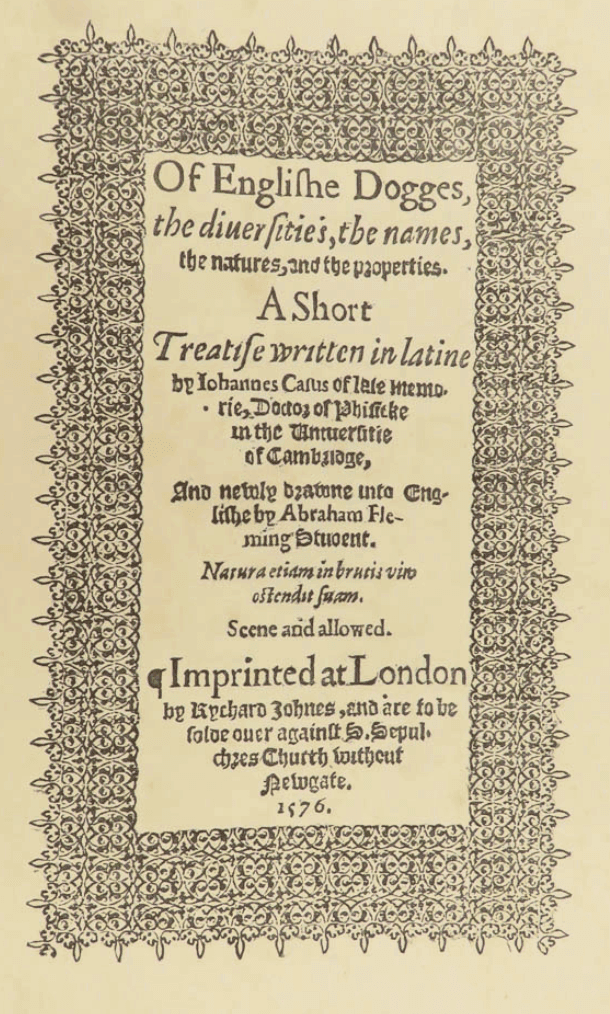
De Canibus Britannicis 1570
John Caius (1510–1573) was an English physician, scholar, and founder of Gonville and Caius College at Cambridge. He was a well-known Renaissance humanist and authored _De Canibus Britannicis_. [_De Canibus Britannicis_](https://www.gutenberg.org/files/27050/27050-h/27050-h.htm#dogges), written in Latin in 1570, is one of the first works to systematically categorize British dog breeds, describing their types, roles, and characteristics. It provides insight into the use of dogs in Elizabethan England, including breeds for hunting, guarding, and companionship. In a chapter on foreign dogs, he writes about Icelandic dogs: „Externos aliquos & eos majusculos, Islandicos dico & Littuanicos, usus dudum recepit: quibus toto corpore hirtis, ob promissum longumque pilum, nec vultus est, nec figura corporis. Externa prælata. Multis tamen quòd peregrini sunt, & grati sunt, & in Melitæorum locum assumpti sunt: usque adeo deditum est humanum genus etiam sine ratione novitatibus. ἐρῶμεν ἀλλοτρίων, παρορῶμεν συγγενεῖς, miramur aliena, nostra non diligimus.“ "Some foreign dogs, particularly larger ones like Icelandic and Lithuanian, have long been used here. These dogs are entirely covered with hair, with long, flowing coats, and neither their face nor body shape is visible. Foreign dogs are favored. Because they are foreign, they are highly valued and have replaced the Maltese dogs, as humanity has a fondness for novelties, even without reason. We love what is foreign but neglect our own." It seems that Icelandic dogs, with such thick coats that their head and body are hard to distinguish, were highly favored by the British aristocracy. It is also worth noting again that William Shakespeare referenced the Icelandic dog in _Henry V_, written around 1600: "Pish for thee, Iceland Dog! Thou prick-ear'd cur of Iceland!"

Olaus Magnus 1555
I decided to look a little further back in time. In the short summaries of the history of the Icelandic sheepdog that can be found, Olaus Magnus is often mentioned. It is usually phrased like this: "In 1555, Olaus Magnus wrote that Icelandic dogs were popular with priests and noblewomen. He also describes the dog as light-colored or white with a thick coat." I tried to find more, possibly the original text, because I prefer to examine the source itself to better understand the full picture, but I was unsuccessful. Perhaps it's not surprising, as this description comes from his work Historia de gentibus septentrionalibus (History of the Northern Peoples), which was written in Latin. The work was published in Rome in 1555 and is considered one of the most significant works about the culture and life of the Nordic peoples in the 16th century. But who was Olaus Magnus? Olaus Magnus (1490–1557) was a Swedish bishop, explorer, and author, best known for his work "Historia de gentibus septentrionalibus". He was born in Linköping, Sweden, and was educated in both Sweden and Germany. He traveled extensively across the Nordic countries, gathering information about the peoples and cultures of the north. Olaus was a strong advocate of the Catholic Church and lived in exile in Rome after the Reformation in Sweden. He dedicated his life to writing and preserving the history and culture of the Nordic countries. Both his works and his drawings are still highly regarded today for their magnificent depictions of the culture and nature of the Nordic regions. "Historia de gentibus septentrionalibus" focuses particularly on the Nordic countries, including Iceland, Sweden, Norway, and Finland. It also covers various aspects of daily life, such as hunting, fishing, farming, and even magic. Olaus Magnus emphasizes the harsh weather and difficult living conditions, but he also describes unusual customs, religions, and strange figures from folklore. The work is adorned with many illustrations. Olaus Magnus also drew a remarkable map, Carta Marina. This is one of the oldest maps that accurately depicts the northern regions. Carta Marina is not only a geographical map but also an important source of medieval ideas about the world, especially about the Nordic countries. For example, the map features illustrations of sea monsters in the northern seas, which at the time were believed to be real creatures by sailors and travelers. This map has been highly significant for historical understanding of the Nordic countries and was a major advancement compared to earlier cartography. Carta Marina is both a work of art and a scholarly piece, providing insight into the world of the Nordic peoples in the 16th century. Those interested are directed to the following websites to read more about Olaus and view the illustrations: ["Historia de gentibus septentrionalibus"](https://gallery.lib.umn.edu/exhibits/show/olausmagnus/historia) [Olaus Magnus - History of the Nordic Peoples (from 1555) - Illustrations with Comments](https://www.avrosys.nu/prints/prints23-b-olausmagnus-intro.htm) [Carta Marina](https://gallery.lib.umn.edu/items/show/1026)
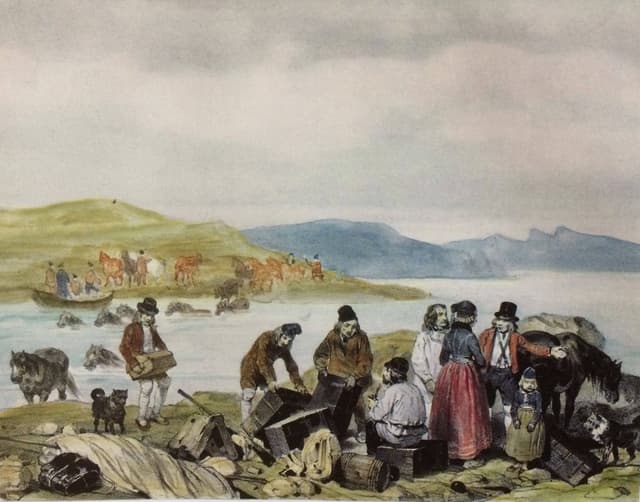
Sharp is the guests eye
Since we do not find many descriptions and depictions of the Icelandic sheepdog throughout the ages from Icelanders themselves, travel books and accounts by foreign travelers often give us a good picture of the Icelandic dog, both in words and images. A book that contains at least two descriptions of the Icelandic dog is [By Fell and Fjord or Scenes and Studies in Iceland](https://drive.proton.me/urls/3Q1KHSM1N8#bDgLp2dOvXp3) by Elizabeth Jane Oswald from the year 1882. I plan to make an extract from the book and add the stories of Kári and Móri to the history section of the website. I also recommend browsing through the book; see the link above. Narratives like these are extremely important for preserving the history of the dog—how it looked, what it was used for, and so on. And as is often the case, it proves that the sharp eye of the guest is invaluable for describing what they see, while it seems ordinary to people who have grown up here. Image by Auguste Mayer, 1836.
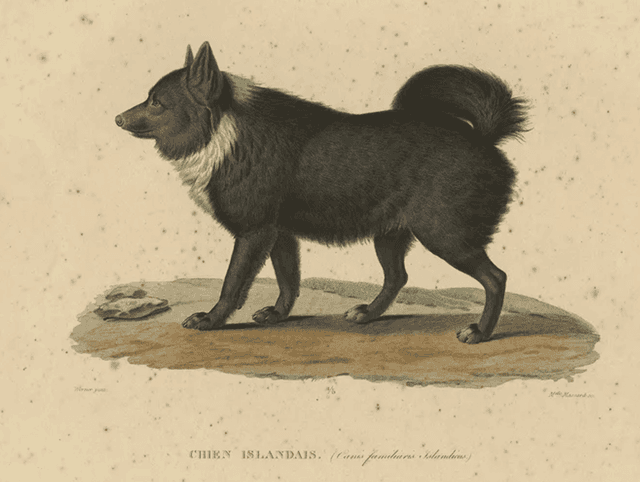
Bósi
Bósi Growl, my Bósi, never bite — better heed this warning! Or someone — turning snappish — might smash your jaw some morning. And never join the gibing pack of "gentlefolk" that flatters until a man has turned his back — then tears his name to tatters. [Jónas Hallgrímsson (1844-5)](https://digicoll.library.wisc.edu/Jonas/Bosi/Bosi.html) The French explorer Paul Gaimard visited Iceland in 1835 and 1836. During the second summer, he led a scientific expedition on behalf of the French government. His scientific work, _Voyage en Islande et au Groënland_, was published in nine volumes after his return. Gaimard became so famous in Iceland that [Jónas Hallgrímsson (an Icelandic poet, author, and naturalist) wrote a poem about him.](https://digicoll.library.wisc.edu/Jonas/Herra/Herra.html) The book _Voyage en Islande et au Groënland_ (1840–1842) contains numerous drawings, reports, and studies on the nature, wildlife, and culture of Iceland. The image above is from this book. The following description accompanies it: This is a rare print titled _"Mammifères Plate 7 - Chien Islandais (Canis familiaris Islandicus)"_, depicting the Icelandic sheepdog. It is a copperplate engraving with contemporary hand coloring on vellum paper. The engraving was made by the artist Massard, after a drawing by Werner. Such prints are not only significant as works of art but also serve as scientific documents from the 19th century. They were often created to provide detailed descriptions of animal species, with a focus on their natural characteristics, and in this case, the Icelandic sheepdog is depicted. According to the inscription on the print, this is number 1 of 5 prints, and I am pleased to announce that I recently acquired this very print for the exhibition.
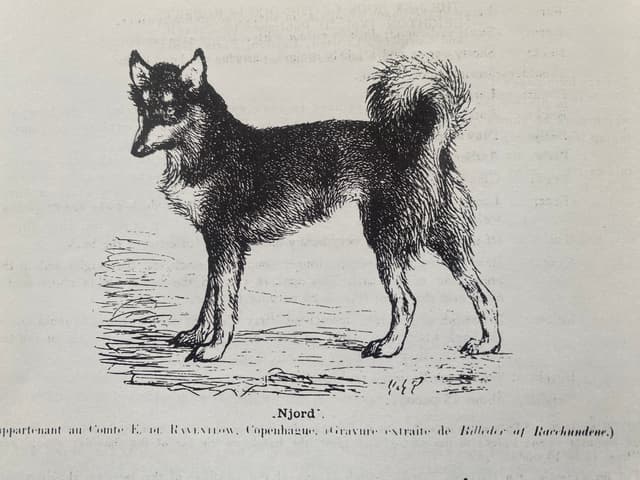
Njord
I was searching for information about this picture, which is also in Watson's book and marked as Njord, but no further explanation is provided. It was once again [Jørgen Metzdorff](https://naskur.dk/) who was able to help me, as he knew that this picture was printed in the Danish magazine _Vor Hunde_. Most likely, Njord was one of the Icelandic Sheepdogs that lived in the Copenhagen Zoo. The drawing of Njord closely resembles the dog in the photograph of the dogs in [_Københavns Zoologiske Have_](https://drive.proton.me/urls/MHDE8XE8QR#DiBpN4PYfz5e). That photo was taken in 1898/99 and shows some of the last dogs that lived in the zoo. They had a dream to breed and showcase different national dog breeds – Icelandic Sheepdogs, Greenland Dogs, and the Great Dane. The picture hung for a long time in the zoo director’s office. Jørgen tried to find more information in the zoo’s archives but was unfortunately not lucky in uncovering anything further. Thus, the mystery of Njord will remain unsolved.
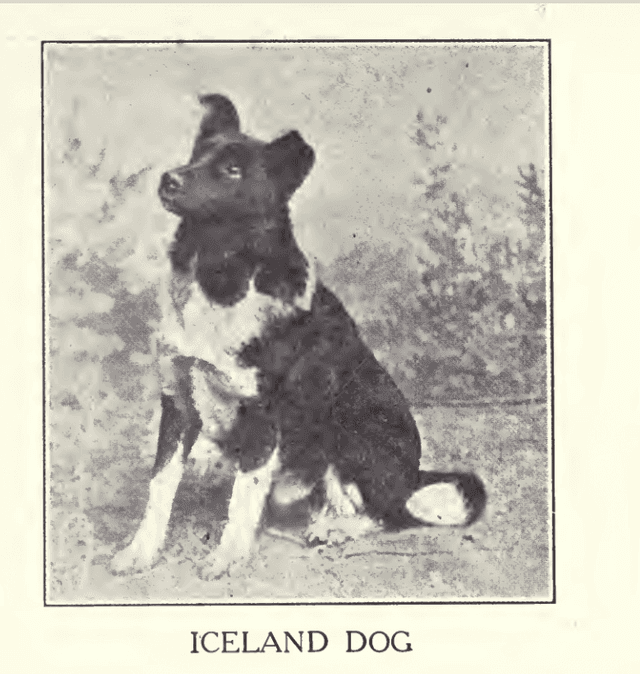
Who was Pillar?
In my search for old pictures and drawings, I came across a picture of "Pillar," which appears in the book _Dogs of all Nations_ by Mason, which I mentioned in the blog post [_Les Races de Chiens_ (1897)](https://www.fjarhundur.is/en/blog/les-racen-de-chiens-1897) a few days ago. However, my Danish research colleague, [Jørgen Metzdorff](https://naskur.dk/), provided me with more information about this picture, and I would like to share this information here. He mentions that the picture of Pillar was originally published in an article in [_Vore Hunde_](https://drive.proton.me/urls/H706PG7DKR#ihCMe0IeZOJF) in April 1900. Pillar was a so-called war dog that was supposed to play an important role. Jørgen states that a number of Icelandic Sheepdogs were brought from Iceland to Denmark around 1890 to fulfill communication roles. The dogs were part of a military experiment in which Icelandic Sheepdogs were used to carry messages between advancing units, so-called war dogs. The experiment was initiated by Captain Christensen, and the Icelandic Sheepdog was selected because of its versatility, independence, and intelligence. However, the use of the Icelandic Sheepdog as war dogs remained an experiment only, as message delivery was soon taken over by other inventions. Pillar lived with Sergeant Lindholm in Aalborg and was awarded an honorary prize at the Danish Kennel Club Show in 1897, as well as first prizes in 1898 and 1899. As far as we know, Pillar was used for breeding twice. The book [_The Iceland Dog_](https://drive.proton.me/urls/MSZXKPRSBW#NJ3Xh5blzdvJ) by Mark Watson contains pictures from Danish Kennel Club show catalogues. Two of the pictures are from the July 1900 show, where three of Pillar's offspring (born in 1899 after Svartur) participated. The other two pictures are from a 1901 dog show in Copenhagen, showing two other offspring of Pillar (born in 1900 after Sampa, owned by Sergeant Andersen). All of the offspring were owned by Sergeant Lindholm. Some of these dogs were for sale for 50-100 DKK, which in today’s value equals 3,600-7,200 DKK. A small side note: An average Danish worker earned 0.39 DKK per hour according to data from 1907. If this amount is adjusted for 2024, it would equal 33 DKK per hour. In 1900, it took about 250 work hours to pay for a dog. The average salary in Denmark in 2024 is 240 DKK per hour – so, using the same assumptions, a dog would cost around 60,000 DKK or 1.2 million ISK. Dogs were relatively expensive at that time compared to today. Thus, Pillar gained fame in Denmark during these years, and a picture of her was later used in Mason’s book.
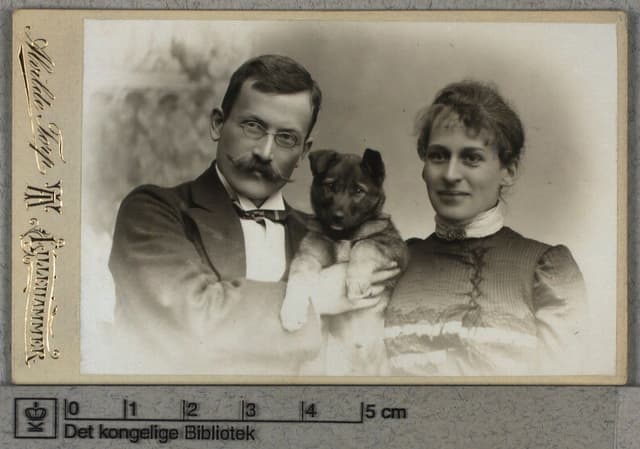
Christian Schierbeck - Den ægte islandske Spids
Christian Schierbeck was born in 1872 in Denmark and completed his medical studies in Reykjavík in 1900. He worked as a doctor in Reykjavík during 1901 and 1902. Christian Schierbeck married the Danish woman Berta Schultz in Reykjavík in 1900, and during their stay, they lived on Laufásvegur in the city center. From Iceland, they moved to Norway and then to Australia, where he died in 1917, only 45 years old. Schierbeck acquired the dog Sámur, who attracted attention in Denmark, and he lamented that the Icelandic sheepdog was not well-known in Denmark and had become rare in Iceland. He wrote an article about the "Icelandic Spitz" that was originally published in _Vore Hunde_ in 1900. Schierbeck was one of the first to point out that the Icelandic dog population was declining in its homeland. Part of his article appears in Watson's book, but the full article can be found on the Danish website [Naskur.dk](https://naskur.dk/islandsk-farehund/historisk-tilbageblik/den-aegte-islandske-farehund). I received permission to republish the article here in translation\_.\_ The True Icelandic Spitz By Chr. Schierbeck, M.D., Reykjavík. Originally published in _Vore Hunde_, 1900. Sámur and I have now spent approximately 2 1/2 hours at the Hansen & Weller photo studio – the result was dozens of failed plates. We had the best one printed, and the result now appears as an artistic supplement to _Vore Hunde_. Readers of _Vore Hunde_ may not understand that Sámur’s stay here in this country was one continuous triumph. It started in the kennel with flattering comments from cynologists; it continued on the street, where we were constantly called after: "Look at that beautiful animal!" "No, have you seen the dog, he looks like a bear!" "Daddy, isn’t that a wolf walking there?" "I’ve never seen a dog like that before!" and so on and so forth. Similar comments and high praise of the utmost kind rained down on Sámur in cafés and gathering houses. It reached a peak when the editor of _Vore Hunde_ visited me here in Amaliegade to ask for a picture of Sámur for his famous magazine. I mention all this only to emphasize that I am not the only one who admires the beauty of the true Icelandic Spitz. Those who have admired Sámur the most have been people with a far greater cynological understanding than mine. And he has won the hearts of refined women with storm. The Great Dane, the Greenlandic Spitz, and the Icelandic Spitz seem to me to form a three-leaf clover that should be bred at home. But why has the old, true Icelandic dog been forgotten; the dog mentioned in the oldest Nordic sagas (my dog is named after the famous dog of Gunnar in the _Njáls Saga_); the dog the Norse Vikings brought to Iceland; which has kept its breed pure for more than a thousand years, indispensable to every Icelandic herder, as it is so wonderfully wise at retrieving, gathering, and recognizing sheep; the dog that is so loyal it would rather die than leave its master (Sámur has proven that to me) – why has this wonderful animal been forgotten in Denmark? Yes, I know it hasn’t been completely forgotten. But one must admit that those who truly own the genuine Icelandic dog, who can stand up to critical scrutiny, are, to put it mildly, very few. The reason why the Icelandic Spitz is so incredibly rare here is first and foremost the sad fact that, despite everything said to the contrary, it is also rare in Iceland itself. It is now only found on rural farms located by remote fjords, where there is very little shipping traffic and until recently, none at all. In all the well-known fjords and in Reykjavík itself, the breed has been mixed with numerous French and English dog breeds found there. Another reason it’s not kept here at home is fear of the notorious tapeworm, as prevalent among Icelandic sheepdogs, purebred or not, as among Australian sheepdogs. I will discuss these two points in more detail: the characteristics of the breed and tapeworms. First, the characteristics of the true Icelandic Spitz, brought to Iceland by the Norse Vikings, or perhaps earlier by Irish monks, from Britain. --- The Breed The dog is somewhat shorter (about a hand’s width) and smaller than the Greenlandic Spitz. Its coat is thick and filled with wool that can be combed out in clumps when it sheds. This is therefore a real coat; it has shiny, soft, and long hairs that somewhat resemble the fur of a bear. The colors are usually white, golden white, or spotted brown, more rarely black. I have only once seen a completely black purebred in Iceland. The front part of its body is unusually developed compared to the back, which is slender and narrow. In terms of body structure and lines, the same general difference exists between the Icelandic Spitz and the Great Dane as between the Icelandic horse and the Danish horse: the Icelanders are smaller, with stronger front parts and weaker rear parts, and this applies to both the dogs and the horses. I consider this an indication that the Icelandic Spitz, like its brother, the horse, is a mountain animal; accustomed through thousands of generations to dangerous leaps on steep mountains, while the Danish dog (the Great Dane), like the Danish horse, is an animal of the plains. Between the toes, the Icelandic sheepdog has distinct webbing (it swims extremely well across rough glacial rivers!). The head is pointed, even more so than that of the Greenlandic dog. The eyes are large, intelligent, and highly expressive. As with all mountain dogs, it is also characteristic of this one that it sees and hears exceptionally well, while its sense of smell is less developed than that of plain-dwelling dogs. The ears – yes, here comes one of the breed’s distinguishing features – must be able to stand completely upright; not a single millimeter of the outer edge of the pointed ear may droop when the animal listens, and it listens almost constantly when outside: then the conical, finely-haired ears stand erect like a horse’s ears. Most dogs in Iceland have drooping ear tips even though the ears are perked, making it immediately clear that they are crossbreeds. On purebred animals, the wedge-shaped head merges with a beautiful, broad, and fluffy mane that rises like that of a bear. Behind the ears, it rises like a priest's collar when the animal bends its head. The body tapers, and the hindquarters are, as mentioned before, noticeably smaller. The tail should be very bushy (thick) and curl up like a bell over the back, where the hairs form a sort of part under the curved end of the tail. On the ears, mane, and tail, purebred animals can be distinguished from crossbreeds in Iceland. Females have a much weaker mane and tail and are generally much smaller. Thick hair growth around the rump is yet another adornment of these animals. Each front leg has small dewclaws; each back leg has well-developed double dewclaws. The beautiful shape does not appear properly in photographs because the animal is too lively to stand still long enough to be posed and “taken.” Sitting still is something my dog can do better, but then you mostly only see the strong chest. The thick coat allows it to withstand the harshest cold. Snow is the dog's favorite environment, where it plays with true joy. When I first saw Sámur, he lay one winter night at 1 a.m. in the shelter of a large snowdrift, sleeping, while a fierce snowstorm howled around my horse and me, and snow drifted over his furry body; but he slept calmly, as if in his mother's bed. If they are well-bathed, they never get lice. I believe that fleas cannot survive in the dense wool. The fact is, I’ve never owned a dog that was as flea-free as Sámur. Regarding the mental characteristics of the breed, I must be briefer than I would like due to space. The true Icelandic dog is incredibly quick to learn – it learns ordinary tricks as easily as a good poodle. As a mountain dog, it has an extraordinary sense of direction, which is also a great advantage for a dog kept in a large city. Sámur found his way home from Frederiksberg to Niels Juelsgade after a two-day stay in Copenhagen (he had never been in a city before!), where I lost him, and he sat waiting for me when I arrived. He is as loyal as any dog, I think. When he is sad (if left at home), he doesn’t whine like a fool but curls up and quietly accepts it. He expresses joy in a very exuberant manner and rarely needs to be reminded and almost never scolded. He is used in Iceland to drive sheep and horses together and keep them in herds. His best work is done in the autumn when, from far away, even from over a thousand feet in elevation, he is sent to fetch sheep down from the mountains, where the farmer only occasionally sees a white spot far, far away. Then the dogs are sent out after them, recognizing each lamb in the herd; and without the dogs, the herder could not gather the sheep at all on the dangerous and long roads. The dogs are so indispensable that, for example, only about twenty years ago, when a dog plague swept the country and killed over 3/4 of Icelandic dogs, one horse and two sheep were offered for a single true Spitz! But as I said before, the true dogs are now almost extinct, and one must travel far and wide into the country, especially to remote districts, to find a true Icelander. The Tapeworm Regarding tapeworms, I must be very brief. In fact, this question doesn’t really belong in this magazine, but as a doctor, I can’t help but make a few superficial remarks on the subject. Over 95% of all dogs in Iceland (both purebred, imported, and mixed breeds) host a 4 mm long tapeworm in their intestines, which is called _Taenia echinococcus_ in Latin. The tapeworm common in Danish dogs and harmless to humans—\_Taenia coenurus\_—is also somewhat common in Iceland. However, only 1 to 2% of dogs in Denmark carry these same harmful tapeworms (_echinococcus_). The eggs of this tapeworm are expelled with the dog's feces, and it’s not uncommon for a dog in Iceland to have such eggs on its snout. If such an infected dog licks a plate that isn’t later cleaned thoroughly—or even worse: licks a person—the risk of transmission is present. The eggs of the tapeworm (_echinococcus_) need to go through a larval stage, the so-called cyst stage (hydatid) in humans or sheep. These insignificant tapeworms, unfortunately, have enormous larvae. So enormous that I have seen them in humans, where they could fill an ordinary water bucket. It sounds like a fairy tale, but it is unfortunately all too true. If one of these eggs enters a person’s digestive system, it develops into a tiny larva that travels through the intestinal wall and usually settles in the liver (_liver echinococcus_). There, it grows into a tumor that typically becomes as large as a human head. Only surgery can then provide a cure. And many patients die from this prolonged disease (the illness often lasts many years, up to 20 years). As mentioned earlier, the dog carries a mature but small tapeworm. Humans are usually infected by dogs; dogs are infected by sheep, which, like humans, host these enormous larvae (hydatid cysts). Dogs are easily infected because they are unfortunately still often fed raw scraps of meat after the slaughter of sheep. The hydatid cyst mainly resides in the fat membrane of the sheep (less often in the liver, as in humans)—and the fat membrane is only suitable as fertilizer and dog food. Moreover, hydatid cysts, which are transmitted from dogs, are the most common tumors in humans in Iceland. It is now legally required that every dog undergo a deworming treatment twice a year, aimed at killing and removing these small, dangerous parasites from the intestines of dogs. The treatment is as follows: First, the dog is fasted for 24 hours and confined to a shed. Then, it receives 5 grams of areca nut and must remain in the shed for 6 hours. By then, the areca nut has taken effect, and one of the results is significant defecation. Afterward, the dog is bathed, and the treatment is complete. Many dogs die during this treatment. In my opinion, this treatment alone is not reliable. The most important thing is that the dog does not eat raw slaughter remains of sheep. Although it is legally required to bury these remains, only a few Icelandic dogs are fed exclusively cooked or fried meat—most still receive raw meat. I have deliberately not hidden this danger from the readers of \_Vore Hunde\_—I, who have seen so many serious and painful cases of hydatid disease in humans, have felt it my duty to warn against careless purchases of Icelandic dogs through merchants or farmers there. Sámur is completely free of these tapeworms, having undergone many difficult treatments, and in the 2 years that I have owned him, he has never had the opportunity to eat raw meat and now has such an aversion to it that he won’t touch it. In March, Sámur is to mate—he is now 2 1/2 years old and therefore at the age where "street meetings" are no longer sufficient. If I manage to get a good puppy, I plan to offer one or two for one (or two) of the readers of _Vore Hunde_. They will cost nothing except transportation and any possible veterinary certificates here. As a doctor, I can guarantee that such puppies will be free from _Taenia echinococcus_ (I will not send them until I have observed them for some time). Next March (1901), I am returning to Iceland, and a year later, 1 or 2 puppies will likely be available. My dog was once offered to a Parisian by a Scottish collie breeder for an additional 100 francs. A doctor in London wanted to buy him from me for 10 pounds sterling—but even if I were offered 50 pounds, I would not sell him. I mention this at the end only to show how highly the dog is valued abroad as well. Photo: Christian Schierbeck and Berta, his wife. Schierbeck holds a puppy that is Sámur’s offspring. The photo was taken in Lillehammer, Norway.
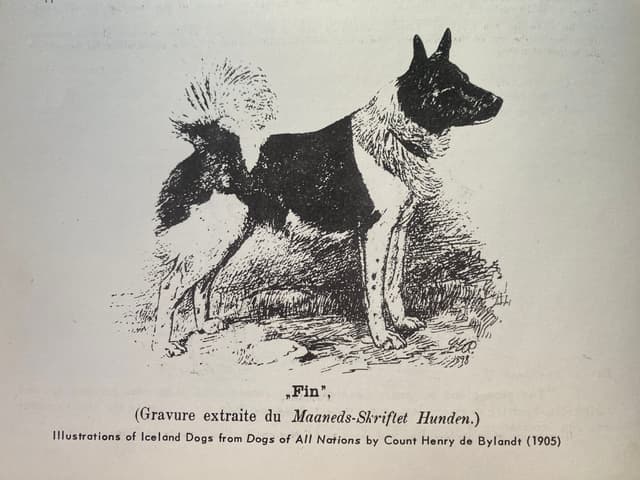
Les Races de Chiens (1897)
Henri de Bylandt (1860-1943) was a Belgian nobleman and cynologist. He was known for his work on dog breeds, particularly his book "Les Races de Chiens" from 1897, which was an important contribution to the field of dog breeding and canine studies. The book was published in English in 1904 as "Dogs of All Nations." The book contains detailed descriptions and illustrations of numerous dog breeds as they were recognized in the early 20th century. Bylandt's work is significant for research on dog breeds and was used as a reference for breeders, judges, and dog enthusiasts. It shows the development of breed standards and advancements in their international recognition. The book does not seem to be available in digital form (as a scanned copy), and unfortunately, I currently do not have access to a library to consult it. In Mark Watson's book, there is a discussion of "Dogs of All Nations" by Walter Esplin Mason, published in 1915, where Watson writes that Mason appears to have taken his descriptions from Bylandt's book. It is also mentioned that Mason states that the ears of the Icelandic dog can sometimes be semi-erect. The illustration of the Icelandic dog in Mason's book indeed shows a dog with semi-erect ears. [Mason's book can be viewed here, and the section on the Icelandic dog is on page 93.](https://drive.proton.me/urls/5BG13MJKB8#L2Zxk7KVyULh) The image above is from Bylandt's book and can be found on page 35 in ["The Iceland Dog 874-1956"](https://drive.proton.me/urls/MSZXKPRSBW#NJ3Xh5blzdvJ) by Mark Watson.
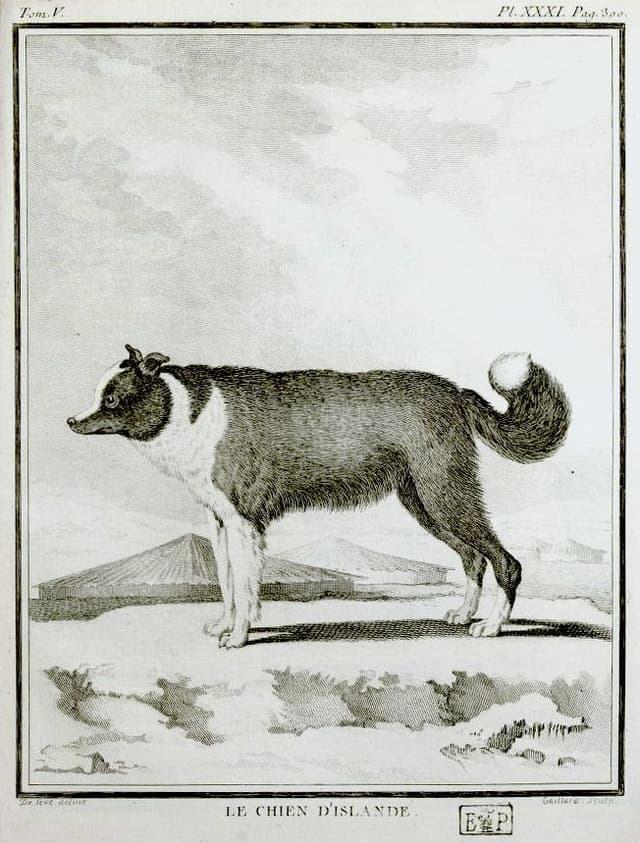
Chien de l'Islande 1755
I stumbled upon these historical images today and would like to continue sharing discoveries. The image is an engraving from 1755, engraved by Gaillard after a drawing by Jacques de Sève. The French naturalist Georges-Louis Leclerc, Comte de Buffon, mentioned the Icelandic dog – "chien de l'Islande" – in his work _"Histoire naturelle, générale et particulière,"_ which he published in the 18th century. Buffon described the Icelandic dog as a medium-sized animal particularly adapted to the harsh climate of Iceland. He noted that the dog had a thick, dense, and weather-resistant coat that helped it survive in the cold and damp northern climate. Buffon emphasized the robustness and hardworking character of the Icelandic dog and considered it an important companion for Icelandic shepherds and farmers. He described the Icelandic dog as brave, energetic, and vigilant, qualities that made it especially suited for herding sheep and other animals. Its attentive and lively nature made it a valuable guardian and protector. The engraving of a dog against the stark Icelandic landscape accompanied his description in his monumental work _“Histoire Naturelle.”_
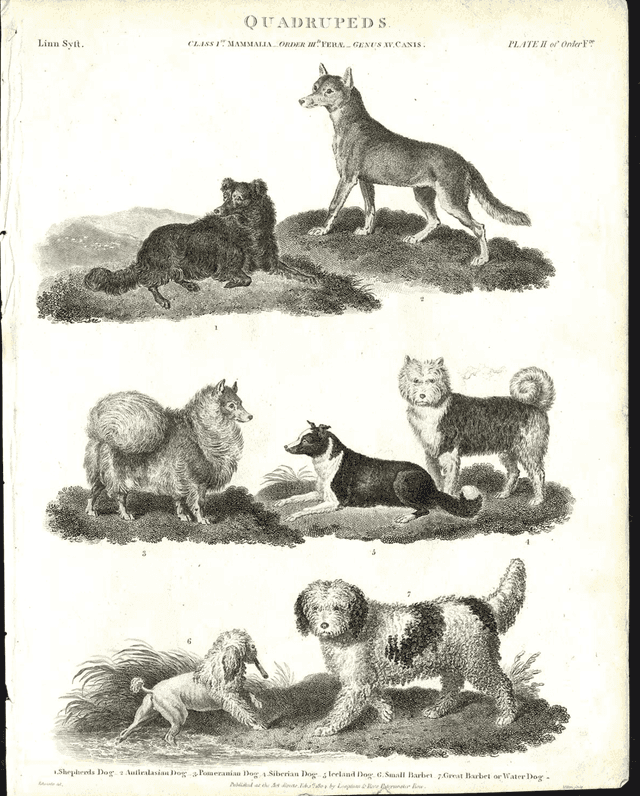
Historical illustrations
There are not many historical illustrations of Icelandic sheepdogs, and the ones I have found are mainly in old foreign dog books, encyclopedias, and travel books. These images are not necessarily beautiful, and sometimes it is hard to believe that they depict an Icelandic sheepdog. For example, the dog in this "Quadruped" illustration from "THE CYCLOPAEDIA or Universal Dictionary of Arts, Sciences & Literature". The dog marked with the number 5 is supposed to be an Icelandic sheepdog, but it looks quite different from the dog as we see it today. But who knows, maybe the Icelandic sheepdog resembled this dog in the year 1804? We find accounts of the Icelandic dog, for example, in the great Travel Book by Eggert Ólafsson and Bjarni Pálsson from the years 1752–1757. They describe the dog as follows: “The Icelandic dog is small and strong, with long legs and a short-haired coat. It is agile and fast, has a lot of energy, and is especially good for herding sheep. It has very good herding abilities, can stay in the mountains for a long time, and drives the sheep with great skill. The dog is also a great friend of the farmer and a reliable guard of the home.” They also write: "In Iceland, dogs are generally small in size, hardy, and very skilled at herding. They have the characteristic of being able to endure hard work and cold without getting sick. The dogs here are especially well-trained to work with sheep and to drive them together. They are very loyal to their master and protect the livestock with great vigor. Often, they can be seen running long distances after sheep in the mountains, and they have very keen senses, especially of smell and hearing." Perhaps the illustrator read this text and drew the picture based on this description, as it is not certain that he had ever come to Iceland and seen an Icelandic sheepdog.
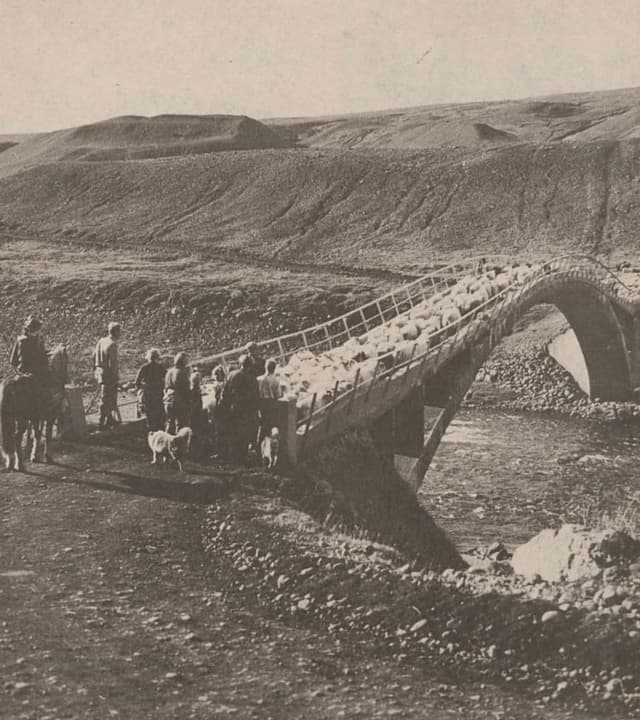
Autumn
Autumn has arrived, a wonderful time that brings with it all kinds of work in the countryside, including sheep gatherings and roundups. Some time ago, I came across this picture, which came with little to no information. The author was not correctly credited. It was stated that the German, Franz-Karl Freiherr von Linden, had taken the picture, but he visited Iceland in 1868. The bridge over Fnjóská was built in 1908, so that can't be correct. However, the picture is interesting because it shows a sheep drive, probably driving sheep for slaughter westward over the bridge, into Vaðlaheiði mountain pass. In the picture, you can see two dogs behind the herd. The atmosphere is so Icelandic! I used the past summer to "practice" telling stories about the Icelandic sheepdog and to explore where people's interests lie in learning about the dog. Every group of tourists who visited us at Lýtingsstaðir received an introduction to the Icelandic horse and the Icelandic dog. It was very noticeable that most foreign visitors were unaware of the existence of the Icelandic sheepdog, but they were certainly not lacking in interest in learning more about it. I was often asked about the dog's working nature, and it was enjoyable to explain how the dog is used in our vast country to drive the sheep home from the mountains. But through these stories, it also became increasingly clear to me how incredibly versatile the Icelandic dog is, and it is not possible to talk about it merely as a "sheepdog" — it is so much more than that. The construction of the house for the exhibition is progressing well, but the work inside the house remains to be done. I will make good use of the time this autumn to prepare the setup of the exhibition and hope that it will be possible to secure more funding for the project.
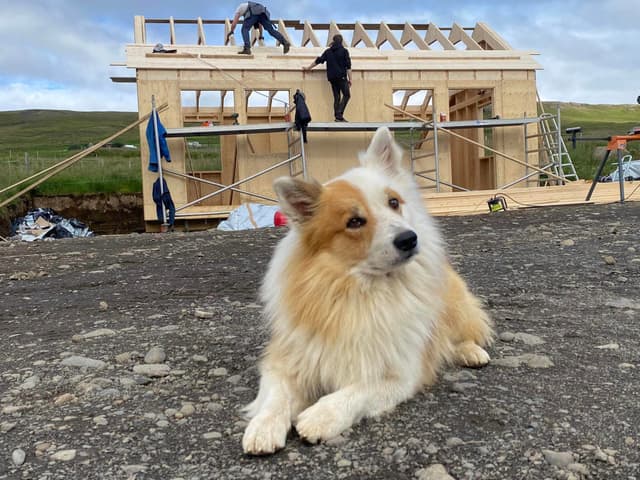
Construction work in progress
The construction work has been progressing well lately despite the persistent and unpleasant weather. We hope to finish the work soon so that I can turn my attention to the preparations for the exhibition itself. I already have a lot of material and a plan, but before I make the final decisions on the setup, I want to get a better feel for the exhibition space. You can follow the progress on our Facebook page, where I have been posting photo albums with regular updates.
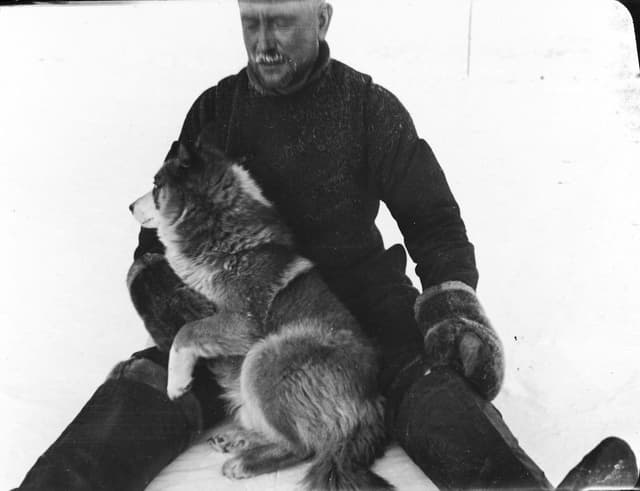
More about Gloí in Greenland
Since I stumbled upon the story of Glói in Greenland in 1912/13, it hasn't let me go. I devoured the book after Vigfús Sigurðsson "Um þvert Grænland". I still plan to make excerpts from this book and Alfred Wegener's diary to present Glói's story, but today I was lucky to receive an article about Glói written by Anna Louise Schneider. [The article was previously published in Icelandshunden No. 1, 1999, the Danish club magazine.](https://drive.proton.me/urls/AC4NF3Z6DR#YLqyz8SS3wDc) I got permission to publish a translation here on the website. And here we go: "I grabbed my cup with the dog meat and crawled down the mountain – or rather slid – as fast as I could, followed by Wegener.... During the slide down the mountain, I ate from my half-raw dog meat at every little stop. I had suddenly become terribly hungry, and the dog meat tasted like the most delightful dish to me." Thus ended the days of the Icelandic sheepdog GIöé, after having trekked 1200 km through ice and snow in -40 degrees, across northern Greenland, as a member of the Koch expedition of 1912-13." In the book "Through the White Desert" by Captain J.P. Koch, the expedition is described in diary form. The purpose of the expedition was to investigate the natural conditions in the marginal zone of the inland ice, primarily atmospheric and geological conditions. The italicized passages are taken from this book. Traditionally, sleds pulled by Greenlandic sled dogs have been used for expeditions to Greenland, but the conditions on the Koch expedition's planned route forced them to use other methods to progress. They had to cross rough glacier ice, which the sleds could not withstand, and the dogs risked cutting their paws on the sharp and pointed ice needles. The journey also went through long stretches free of snow, where neither sleds nor dogs were suitable. The expedition also couldn't be sure they could move forward by boat due to ice formation. They had to carry all their goods overland to the edge of the ice. In summer, this could only be done using pack horses. The expedition consisted of four men and 16 Icelandic horses. One of the participants was the Icelandic leader Vigfus Sigurdsson, born in 1875; Vigfus was, as an Icelandic farmer, practically born and raised on a horse. As a postman in northern Iceland, he was particularly familiar with the arduous and often dangerous winter journeys over the snow-covered Icelandic highlands. Vigfus naturally had an Icelandic sheepdog, Glói, with him on the expedition. Glói was also called the Kamik animal, and despite inquiries at the Arctic Institute in Copenhagen, there is no immediate explanation of whether the name has or had any special meaning (besides it being a term for shoes). Besides helping Vigfus, Glói had other tasks, such as keeping foxes away from the house, scaring musk oxen away from the horses, and warning the people about polar bears. The book contains many descriptions of how the dog was part of the expedition's daily life, and one clearly senses its character, which is very similar to the Icelandic sheepdog we know today. October 21, 1912 Glói had so far had to stay outside, but when the temperature dropped to -28 degrees, he was exceptionally allowed to lie in the storage room. Here, where it was completely dark, he lay most of the day. He whimpered softly when stepped on, and one could hear him wag his tail when comforted. I felt there was no point in keeping a dog in such a way, so I brought him into the living room. Glói was happy. He licked our hands, gave his paw, rubbed his nose against our trousers, and trotted around until he, overwhelmed by the warmth, collapsed on the floor, from where Wegener lifted him onto his sofa. One quickly gets used to an improvement in external conditions and therefore constantly seeks greater luxury. This was also the case with Glói. After resting on Wegener's sofa, he took a reconnaissance tour of the room and came across a low shelf under the table where food items – blood pudding, cheese, butter, and liver pate – were kept. The situation overwhelmed Glói. He just had to smell the liver pate. But by doing so, his nose got too close to a can, which fell to the floor. A few "whacks"! Out the door! - the bliss was over, and Glói lay again in the dark storage room, whimpering when stepped on. The next morning, I tried to bring him into the living room again, and this time it went well. Every time he got near the fatal liver pate, I gave him a warning: "Be careful, Glói! Ah, be careful!" And now he no longer touches the food shelf.... Since then, I look more kindly at Glói. The little story has brought us closer together. The journey undertaken by the four men, their dog, and 16 horses was exciting but harsh. They traveled by ship from Iceland towards Denmarkshavn in Greenland on July 7, 1912. By mid-October, they reached their wintering place, where they stayed until April the following year. Then began the long journey across Greenland, which ended on June 17. When they reached the colony "Prøven," all the horses were dead. Some were slaughtered along the way as they were no longer needed to transport the wintering house, thus extending the fodder for the remaining horses. About six horses died of exhaustion and hunger - the last horse, Grani, was attempted to be dragged on the sled, but they had to shoot it a few days before the goal was reached. Besides hay and concentrated feed, the horses were fed blood pudding, meat chocolate, horse meat, lemon drops, butter, cheese, and biscuits. Glói proved to be incredibly resilient. When the horses sank to their bellies, Glói "swam" through the snow. One night, the expedition's tent site was hit by a massive avalanche. All the men saved themselves, and the next morning they were reunited with Glói.... When we came out of the tent, Glói came running to meet us. We had missed him during the night and had heard him howling somewhere up the valley. It was likely that he was stuck in some crack. He had been lying behind the tent right where the ice blocks had crashed down; naturally, he had been frightened and had fled. We had searched for him during the night but could not find him, although he howled every time he was called. Now he had managed on his own. At one point, however, Koch accuses Glói of being a bit dumber than a dog should be when crossing the inland ice. Today, we would probably find the situation comical and praise the dog for its problem-solving ability. May 28, 1913, evening. It has been a cruel May month. I hope that June will be better. Poor Glói - he got into trouble. In the severe weather, we allowed him to be inside the tent, but he was always in the way and had difficulty managing under the difficult tent conditions. A few days ago, he failed to get out in time – it is not easy for him as the tent door is always closed – and as a result, he had to resort to Wegener's windbreaker hood. Naturally, he got a beating and was thrown out, and since then he has been more careful – too careful. Last night, when I lay by the tent door, he wanted to go out three times within the first four hours, so I constantly had to open and close the door for him. It affected my sleep. The third time, Glói was away for so long that I got tired of waiting for him, closed the tent door, and went to sleep. However, it was not the Kamik animal's intention to stay outside, and as he could not get in any other way, he gnawed a hole through the tent door. When Glói crawled over me, I woke up, and when I saw his misdeed, I gave him a good beating and threw him out again. Poor Kamik animal! It was -29 degrees last night and cold all day today. He no longer dares to ask to come into the tent but lies outside and freezes. Glói survived the journey without illness or injuries, except for snow blindness, which everyone suffered from. When all the other animals had succumbed, Glói still followed. Near the goal, the men were very exhausted from hunger and cold. Glói lay on top of them to warm them. First, we had to regain some strength, and for that, we had only one means: we had to slaughter our good friend, our little, kind dog.... It was hard to give the order, but I did it without hesitation. The situation was becoming critical. The moment Koch was eating the half-raw dog meat, they could make contact with people suddenly appearing on boats in the fjord and were saved. The slaughter of Glói could thus have been avoided, but the men could not have foreseen that. It is a somewhat sad ending to the story, but all Icelandic sheepdogs can be proud to "be related" to such a brave and clever travel companion. In the book "Through the White Desert," there are many both touching and hair-raising descriptions of Glói and his people's journey across Greenland. If you are interested in Icelandic horses, it is definitely also exciting reading! Literature: "The White Desert" by J.P. Koch. Gyldendals forlag 1914. If you want to read more, "The Greenland Explorer Wegener - and the Drifting Continents," by Mogens Rud, is recommended - the book also mentions Glói Eilers forlag 1997. The Arctic Institute has a library with additional literature on the subject. Tel. 32BB 0150. Anna Louise Schneider
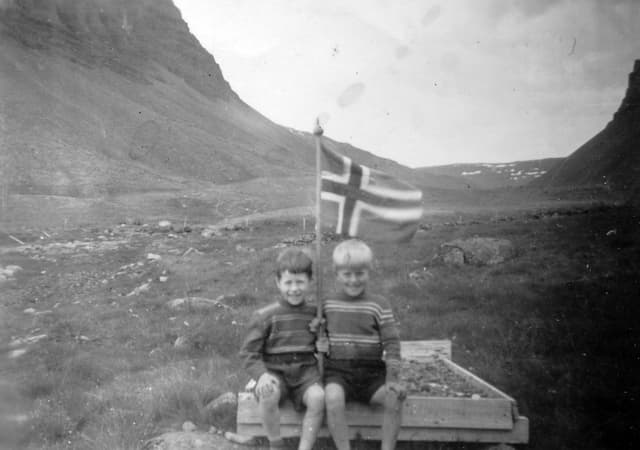
Dog toilet at Sellátur
I came across this little and entertaining story from Sellátur, and it is Höskuldur Davíðsson who once again has the honor of sharing his childhood memories, for which I extend my best thanks. Stories like this give us a small insight into the intertwined lives of humans and dogs in the old days. Höskuldur writes on July 19, 2024: "The floor in the front hallway of the old house at Sellátur was made of sea-washed gravel from the shore. The dogs could relieve themselves there if the outer door was closed due to weather or other reasons at night. It was just cleaned up in the morning, and it was considered a rather unpleasant task for the youngsters. In this picture from my sister Guðný's album, my foster brother Björgvin and I have clearly solved this troublesome issue and created an outdoor toilet for the dogs, so we wouldn't have to do the cleaning. We failed to connect that the dogs only did this when they were locked inside. This was clearly a big event and a reason to borrow the Icelandic flag, which was a sacred object and not used lightly. At the farm, there was much talk about everyone needing to do their utmost to support the newly gained independence of the country, and we probably felt we had done our part in that matter. However, we don't mention that the materials were likely "borrowed" from the construction of the farms power station and that our tools were scattered all over the field, coming up from the grass, rusty and broken in the spring, to my father's little delight. But the pride and feeling of having done something useful probably overshadowed the scolding and reprimands from the master builders. Anyway, the need to continue building something remained with both of us, well into old age."
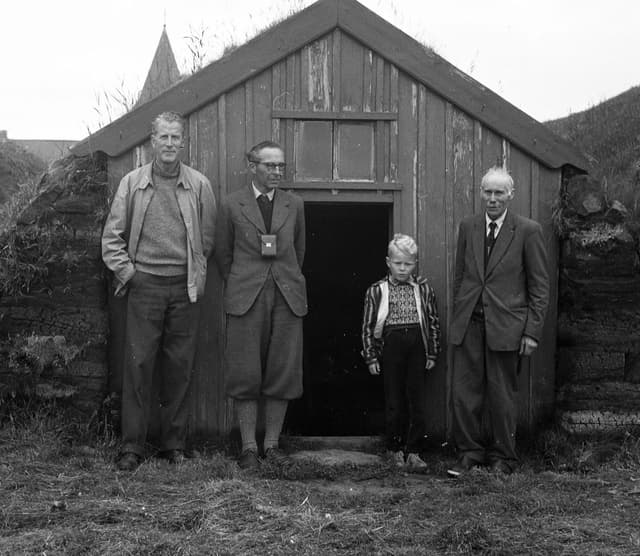
A successful day
Yesterday was Icelandic Sheepdog Day, and the national dog was celebrated widely across the country as well as abroad. Social media was filled with pictures and festive greetings. At noon the National Broadcasting Service RÚV featured [a segment and an interview](https://www.ruv.is/utvarp/spila/hadegisfrettir/25243/a16kcp/thorarinn-eldjarn-um-mark-watson) with Þórarinn Eldjárn, author and poet, about a picture he posted on his Facebook page in honor of the day. The picture, shown above (with Þórarinn's permission for publication), depicts Mark Watson, his British travel companion, Þórarinn Eldjárn (then 9 years old), and Hjörtur Benediktsson from Marbæli, the curator at Glaumbær. The photo was taken by Þórarinn's father, Kristján Eldjárn, author and scholar, who was the President of Iceland from 1968 to 1980. Þórarinn recounts that on July 7, 1958, he was on a trip with his father, who was then the national museum curator, and they were heading to Glaumbær in Skagafjörður. Father and son were trying to get there before Mark Watson arrived to ensure that he would not have to pay the admission fee for the museum, which he himself had funded. When they arrived at Glaumbær, Mark Watson had already arrived and paid the admission fee. [See also here.](https://www.ruv.is/frettir/innlent/2024-07-18-minnist-bjargvaettar-islenska-fjarhundsins-417938) I greatly enjoyed this segment and the photo, which I had never seen before. When I arrived in Glaumbær around 4 PM, we dog owners who had gathered to celebrate the day met right by the same house corner where the photo was taken 66 years ago. To our great delight, RÚV also attended the event and captured the wonderful atmosphere in Glaumbær that forms every year on this festive day. The event was covered in the [evening news on RÚV.](https://www.ruv.is/frettir/menning-og-daegurmal/2024-07-19-blidir-barngodir-og-gott-ad-knusa-tha-418004) It is fantastic to see that Icelandic Sheepdog Day is gaining more and more attention. Here you can see pictures from [the event in Glaumbær](https://www.facebook.com/byggdasafnskagfirdinga/posts/pfbid02af61MeL4A2ymcLZ3N9CW5sVTFdWRsjvE9Gc5tHXzZ6Z6hWrZNw88qqPbxydbxfEal) and here from [the event at Árbæjarsafn](https://www.facebook.com/media/set/?vanity=ola.bjartmarz&set=a.3280778332054132) in Reykjavík.
July 18th - Icelandic Sheepdog Day
The Icelandic Sheepdog is Iceland’s native breed of dog. It is the descendant of the dogs brought to Iceland by the original Viking settlers (AD 870-930). The dogs became indispensable in the rounding up of livestock and in the daily work on the farms. Their method of working adapted to the local terrain, farming methods and the people’s hard struggle for survival over the centuries. [Excerpt from FCI-Standard](https://www.dif.is/UmTegundina/289g05-en.pdf) Tomorrow, July 18, 2024, will mark the ninth celebration of Icelandic Sheepdog Day. It has become a tradition for owners of Icelandic Sheepdogs to make their dogs “extra” visible on this day. Sómi, Hraundís, and I will join others at the Heritage museum Glaumbær from 4 PM to 6 PM. I was also asked to give a short presentation on the Icelandic Sheepdog and the exhibition I intend to open this year. At the Árbær Open Air Museum in Reykjavík, Icelandic Sheepdogs will welcome visitors from 1 PM to 4:30 PM in honor of the day. I would have liked to be ready to open the exhibition on this day, but as I have written before, construction was delayed particularly due to the weather. However, progress is good now, and the building will be erected soon. Therefore, it should be possible to open the exhibition later this year. Good things take time, and I prefer to do this project well rather than in haste. I wish all owners and their dogs a happy day tomorrow!
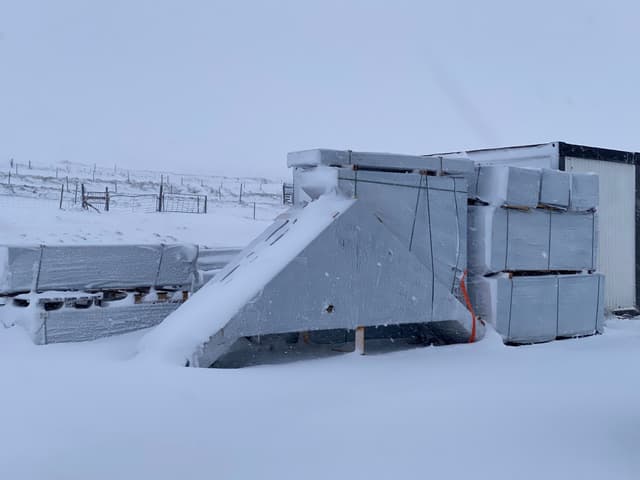
Construction work news
It has long been decided to build a house for the exhibition. This winter, we purchased a beautiful timber house in units, which arrived at the site in early May and is awaiting assembly. The process of applying for the building permit has been long and arduous, and in my opinion, far too complicated and not at all transparent. But finally, we obtained the permit and all the necessary documentation, and the only thing left was to have the building inspector come and mark out the foundation. Then a violent storm hit at the beginning of this week; it snowed an incredible amount, and we farmers had our hands full trying to save the livestock. We were lucky not to have laid the foundation earlier, as it would surely be full of snow now. So we must continue to be patient, allow the soil to dry and settle, and move forward. It looks like the opening of the exhibition will be later as expected, but I am hopeful that it will be no later than this fall. In the picture, you can see the building materials on the first day of the storm.
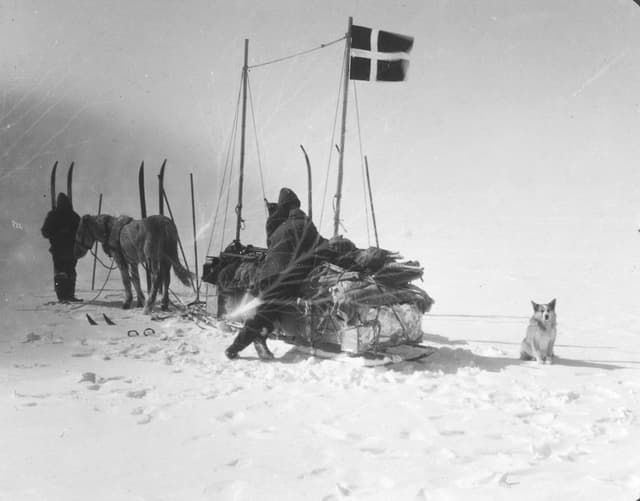
Glói´s destiny in Greenland
I came across a picture the other day with information about an expedition to Greenland that I had actually heard about before, but mainly in connection with the use of Icelandic horses in that context. What caught my attention was an Icelandic dog in the picture, and I decided to learn more about this story. After a short search, I found a narrative by Vigfús Sigurðsson of his journey with Capt. J. P. Koch, Dr. Alfred Wegener, and Lars Larsen in one of the world's harshest environments during the Danish expedition of 1912–1913, to Dronning Louise Land in northeast Greenland and across the Greenland ice sheet to Kangersuatsiaq on the west coast, which was then called Pröven. I acquired the ebook "[Across Greenland: Struggle for Survival and Exploration with J.P. Koch & Alfred Wegener](https://www.amazon.com/Crossing-Greenland-Survival-Exploration-Wegener-ebook/dp/B0BWZ1WFGM)" but also found an original edition in an antique bookstore, which I bought. This expedition is unusual because the expedition members used Icelandic horses to pull sleds with equipment and supplies from the coast to the glacier and across the Greenland ice cap to the west coast. They also conducted scientific measurements. Dr. Alfred Wegener had already published scientific papers on his theory of continental drift, which would later revolutionize the understanding of the movement of the earth's crust. Accompanying the expedition was the Icelandic dog Glói: "On the evening of July 6th (1912), everything was ready. The horses were on board and secured on the deck. We had gained a new travel companion, a small yellow dog with a white chest, who went by the name Glói. He didn't seem to be much of a model dog in terms of intelligence, but that mattered little; he was only there to add to the companionship..." In Vigfús's book, Glói is often mentioned, and various incidents are described, such as when a musk was killed to provide meat for Glói, when Glói warned of a polar bear, when he got lost after a glacier flood, how his bed was made, and how Glói saved the four men from starvation when he was slaughtered. I will definitely compile some stories about Glói and more pictures I found to create a special story about him in the story section of this website. I am so fascinated by the story of this dog, and I feel it needs to be made more visible. You can also read [Alfred Wegener's diaries](https://www.environmentandsociety.org/exhibitions/wegener-diaries/nl001-010167#main-content) and his account of Glói. Picture: Alfred Wegener ---
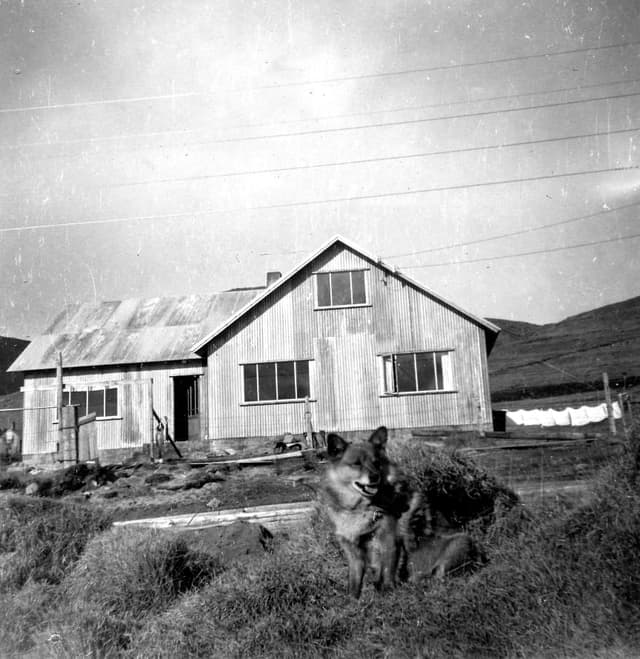
Dogs from Sellátur
My brain is essentially full of names of dogs that are somehow connected and are notable dogs, and I feel the need to write down this information and my thoughts about these dogs. But where to begin? Let's start with Mark Watson. He took eight dogs to California: four from Breiðdalur, one from Jökuldalur, one from Jökulsárhlíð, one from Fossárdalur, and one from Blönduhlíð in Skagafjörður. The dogs Mark Watson acquired from various parts of the country were kept at Keldur and then shipped abroad from there. According to the writings of Þórhildur Bjartmarz, the story goes that the manager at Keldur had a part in ensuring that the bitches Pollý and Snúlla were not sent abroad but instead used for breeding. Birgir Kjaran, a member of parliament and one of the founders of the Icelandic Kennel Club HRFÍ, wrote an article about Icelandic sheepdogs in [Morgunblaðið in 1969](https://timarit.is/page/3292626#page/n7/mode/2up). Birgir writes: "… there (at Keldur) are two Icelandic bitches that Mark Watson seems to have left behind at that time: one is called Pollý and is a beautiful reddish-brown color. The other is black with a white collar and is named Snúlla." Birgir himself owned the dog Klói from Sellátrum, and according to Birgir, Klói was paired with Pollý and Snúlla: "… With them, Klói has probably had nearly a hundred puppies, most of which have lived and spread widely around the country, including at Hestur in Borgarfjörður and at Hólar. Their descendants are also the dogs of Sveinn Kjarval and the breed that Mrs. Sigríður Pétursdóttir at Ólafsvellir in Skeið is now trying to breed. – So I suspect that Klói probably contributed significantly to the survival of the Icelandic dog breed." Since dog keeping was difficult in urban areas, Birgir arranged for Klói to stay for long periods at Keldur in Mosfellssveit. According to [the database](http://www.islenskurhundur.com/Dog/Details/4896#), Pollý had a total of four puppies, all with Klói. [Snúlla from Tunga](http://www.islenskurhundur.com/Dog/Details/12089#) seems to have been Pollý's mother, and Pollý is her only registered offspring. So it's uncertain where the hundred puppies Birgir mentions are. One of Klói's offspring was [Kátur from Keldur](https://www.fjarhundur.is/en/blog/merkishundar), about whom I have written before. Kátur had [53 puppies](http://www.islenskurhundur.com/Dog/Details/4965#), and most or all dogs from Ólafsvellir trace their lineage to him. Perhaps Birgir was referring to Klói's influence on breeding? Probably. It's also worth considering whether the registrations during the early years of organized breeding were always accurate. Who knows? It's at least very interesting to read Birgir's article, and I'd like to write a few words about the dogs from Sellátrum, where he got his Klói. Birgir writes in Morgunblaðið in 1969: "About Klói's pedigree and origin, this is the main thing to say, according to information from Davíð Davíðsson, a farmer at Sellátur, now the chief officer in Tálknafjörður, from whom Klói originates. When Davíð Davíðsson came to Sellátur around 1940 or 1941, there were two dogs there. One was a yellow bitch with a black mouth and muzzle and black eyelids. It is believed she was from Stóra-Langadalur. The dog was from Kvígindisfell. Davíð believes that this breed was brought west from Snæfellsnes by a man named Ólafur Kolbeinsson, who moved west around the turn of the century. According to Davíð, this breed has spread throughout Tálknafjörður and is generally yellow in color (golden), sometimes even white or brown with white toes. The ears are well upright, and the tail is curled. He considers their temperament pleasant, gentle, somewhat sensitive, good herding dogs, and excellent at tracking foxes. When they sniff out fox tracks, they become extremely excited and hard to control. They just follow the trail." In recent months, I've corresponded with Höskuldur Davíðsson, one of the 12 siblings from Sellátur, and it was fun to hear his memories from his childhood years in Tálknafjörður. Regarding the dogs, he told me: "They understood the language and obeyed what they were asked to do, such as bringing sheep from the mountains. They never bit but still had a good knack for making the sheep obey them. Their qualities passed naturally between generations… they were emotional and sincerely participated in our joys and sorrows. They ate the same food as us and were just part of the family." The bitch Kollý was a particular favorite of Höskuldur, and he sent me a short story and lots of pictures, which [you can see here](https://www.fjarhundur.is/en/saga/kolly-fra-sellatrum). I've often wondered if Kollý is the bitch [Kola from Sellátrum](https://www.dogsglobal.com/icelandic-sheepdog/dog/details/73633/6/) in the databases, as she is listed as Klói's mother. Kola is said to have been born in 1956, and her parents' names were Tryggur and Snotra. I asked Höskuldur if that could be right and if he remembers these dogs Tryggur and Snotra. Regarding Kola's birth year, Höskuldur says, "In my mind, Kollý was around when I started walking. 1956 seems a bit late, as I was eight years old then." He consulted his two older sisters, and the siblings did not recognize the names Tryggur and Snotra. Sigurlína, Höskuldur's sister, remembers so-called "livestock dealers" who traveled around the countryside and bought disease-free sheep, and on one occasion, they also got three puppies. So the name extension "from Sellátrum" can be true in many cases, but the puppies were often sent to other owners without names. Likely, Kola is not Kollý, and of course, it doesn't matter much, but it's fun to speculate. I thank Höskuldur and his sisters for their contribution to recounting the history of the dogs from Sellátur.

Two verses
I found the following two verses during my early morning reading. Initially, I thought I wouldn't even try to translate them, as I felt incapable of conveying these Icelandic words into poetic English. However, after my morning coffee, I sought help from Aubrey Wood. Aubrey lives in Iceland and owns the beautiful Laufeyjar Íslands-Tangó frá Dverghamri. After exchanging a few messages back and forth, we decided to give it a try. Translating poetry is never easy, and we employed a bit of "artistic freedom," but hopefully, you'll get a glimpse of what the verses convey. Thanks, Aubrey! _Heitir Valur hundur minn_ _hann er falur valla._ _Einatt smalar auminginn_ _upp um dali fjalla._ [Author unknown](https://bragi.arnastofnun.is/arnes/visur.php?VID=24274) _Heitir Kolur hundur minn,_ _hefur bol úr skinni._ _Er að vola auminginn_ _inn í holu sinni._ [Baldvin Halldórsson from Þverárdal 1863–1934](https://bragi.arnastofnun.is/skag/hofundur.php?ID=15568) The name of my dog is Valur He is handsome, without a doubt Always herding, the poor thing In the valleys of the mountains. The name of my dog is Kolur His body is covered in fur The poor thing is crying In his hole. _Picture found in the book:_ 100 Íslenzkar myndir. Pálmi Hannesson. Reykjavík 1965 (?)
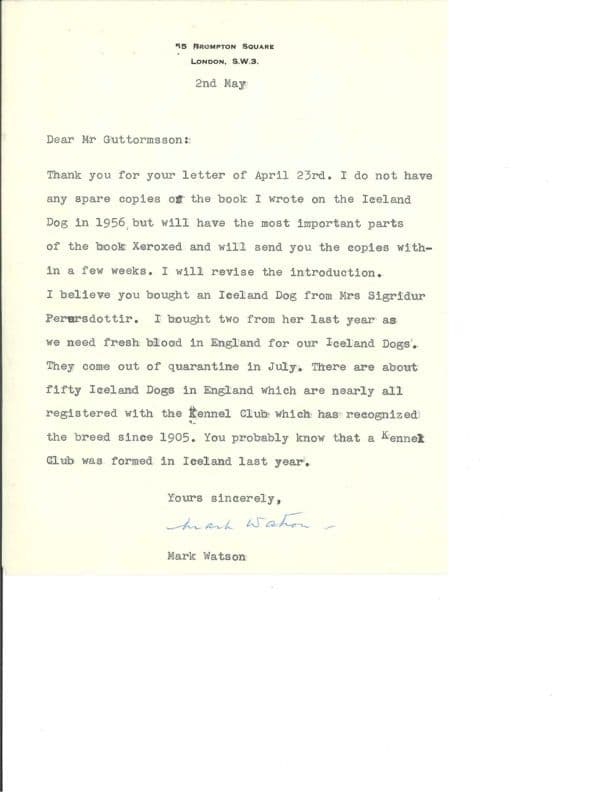
Documents of interest
Recently, I received a large electronic shipment of interesting documents from Canada for the exhibition. I have previously written about [Strútur from Ólafsvellir](https://www.fjarhundur.is/en/saga/strutur-fra-olafsvollum), the first Icelandic dog that was exported to Canada. Now, I have obtained letters and other documents about his purchase and export, newspaper articles, photos, and also photocopies of correspondence with Mark Watson about his book. It is very pleasing to receive such documents that trace the interesting story of Strútur and preserve it. The Consulate General of Iceland in Winnipeg assisted with the photocopying of the documents that Salín Guttormsson was providing. I am very grateful to Salín and the Consulate General of Iceland in Winnipeg for this collaboration. The photocopies are of the highest quality so it will be easy to reprint the documents and have them on display at the exhibition.
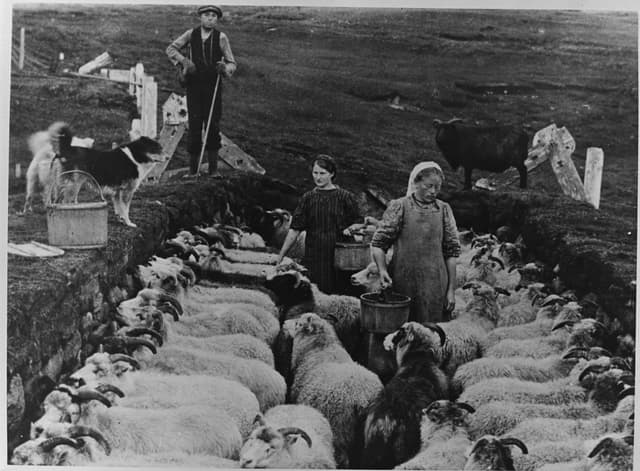
More reflexions on the naming
Following my post yesterday, I decided to discuss my thoughts about the naming with the owners and friends of the Icelandic Sheepdog. I asked people on Facebook, "If the Icelandic Sheepdog were just called the Icelandic dog, what would be different?" This sparked a significant discussion that I found both necessary and interesting, and I thank everyone who shared their thoughts on this matter. It was noted that the Icelandic Sheepdog is a working dog, used for herding sheep, cattle, or horses. But it is also good at many other things. Some can catch mice, collect eggs from nests, track scents, or serve as rescue dogs. Given the Icelandic Sheepdog's diverse roles, names like Icelandic farm dog or Icelandic herding dog were suggested, as well as watch and guard dog, though more in jest and to explore how they would sound. Nobody wants to change the name; that much is clear, and it is not what I want or am calling for either. At some point, the name Icelandic Sheepdog was decided upon or documented, and I heard that the Agricultural Association played a role in this decision to make it more appealing as a farming dog. That was when organized breeding began, and a lot of effort was needed to prevent the dog from going extinct. Of course, if we look at the dog's history and what it was used for through the ages, it was the work involving sheep. Hanna Kristin, who breeds Icelandic Sheepdogs at Reykjavellir, put it well: "...it was most useful around the sheep. Few farmers owned many horses, and they were just outside. There was little fussing with them on a daily basis. The sheep needed to be driven to where the pasture was, brought home when the weather turned foul, kept in pens, driven out of the fields in summer, retrieved from cliffs and crags when they got stuck, searched for when they were snowed in, and dug out of the snow. It seems natural to me that the national dog is associated with the sheep, which sustained the life of the nation. It played such a significant role in the work around the sheep" In old Icelandic texts, the term "sheepdog" is often used. In English texts, however, the term Icelandic dog is more common, and when I was searching for old books in digital libraries that mentioned Icelandic dogs, I hardly found any books with the search term _Icelandic sheepdog_, but I did find books when I entered _Icelandic dog_. Mark Watson named his book The Iceland Dog 874-1956 and writes in the book's preface: "As there is only one true type of dog in Iceland, would it not be easier to call him simply the Iceland dog, and at the same time let it be understood that he comes under the heading of a 'working dog'? Many more authors refer to the Icelandic Dog rather than the Icelandic Sheepdog - occasionally the Danes mentioned the Islandske Spidshunde..." It seems that this discussion is not new at all and will most likely not end here. And that is okay.
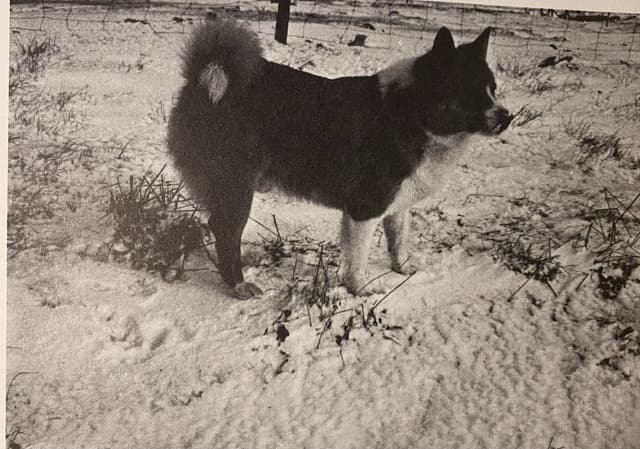
A bit of delving and reflections on the naming
Time flies and tasks change with the rising sun. But there is still a little time to delve into books and articles. I came across this narrative that fits so well with the weather tonight (blizzard ahead): "Numerous stories have been recorded about the interaction between man and dog. Since the settlement era, the dog has been, along with the horse, the most useful servant to Icelanders. It led its master when one could not see out of one's eyes due to the blinding blizzard and delivered him home to the farm doors." Sarpur/Þjóðhættir. Male, born in 1905 Then there were two books by Stefán Aðalsteinsson that I was flipping through. Stefán Aðalsteinsson (1928-2009) was an Icelandic author and PhD in animal science. He completed his doctoral thesis on the genetics of sheep colors. His research on Icelandic livestock, including the origins of domestic animals, is still important today and makes for very interesting reading. In the book "The Sheep, the Land, and the Nation", Rvk. 1981, I found a short text from a dissertation in Búnaðarrit (The Agricultural Journal) from 1891 (by Hermann Jónasson): "It is extraordinary to think that in mountainous areas, where sheep farming is the main occupation, the majority of dogs should be of little use and poorly trained; and that hardly any men are found who have the skill, or rather the will, to train them. ... Then it is to consider whether it is possible to train Icelandic dogs so that they become as promising as "foreign dogs". This is difficult to answer; for, although it is remarkable to contemplate, I know of no instance where an attempt has been made with full diligence and patience to train an Icelandic dog. That is to say, with the persistence that is applied abroad." It's always interesting to contemplate the working nature of the Icelandic sheepdog and I actually think it's completely unnecessary to always compare its nature to that of Border Collie dogs or to expect the Icelandic dog to work like "foreign dogs." They are just different and that's perfectly fine. I've been thinking lately that the naming "Icelandic Sheepdog" might not have been very wise. If it were just called the Icelandic dog, what would be different? Would we avoid endless comparisons with other sheepdog breeds? Would there be less prejudice against it? Would we be prouder of our national dog? Picture: Stefán Aðalsteinsson

Filming week
There's been a lot happening in the last few days as we had a film crew with us, busy shooting pictures and videos for the exhibition and promotional material related to it. On Sunday, a good group of people with their dogs came for a photo shooting in front of our turf houses. It was incredibly fun, the weather especially nice, cold but sunny. I want to list up all the dogs because they will play their part in various materials related to the project: Leiru Tryggur (see picture) Breiðanes Kría Breiðanes Björt Breiðanes Eldur Breiðanes Elding Gerplu Kvika Sunnusteins Prins Stokk-Sels Bósi On Monday, we shot material here at the farm. Our dogs _Reykjavalla Íslands Sómi_ and _Huldudals Hraundís_ played the leading roles as we focused on their interactions with the horses and sheep and the working nature of the Icelandic sheepdog. Among other things, they were equipped with GoPro cameras on their backs, which will provide a different perspective than we are used to. On Tuesday, we interviewed Hanna Kristín at Reykjavellir about her view on the Icelandic sheepdog and her breeding goals. We then followed Hanna on a walk with her dogs. They are: Reykjavalla Sæla Reykjavalla Viska Reykjavalla Vaskur Vestanvindur Hrauni Tindsson Close-ups were taken of Vaskur and Hrauni. They, along with Viska, are dogs with double dewclaws, and breeding them is one of Hanna's breeding goals. Then we went to Glaumbær and got permission to film inside the old farm. It's still very difficult to find historical pictures of Icelandic sheepdogs, so we thought of solutions, and I look forward to seeing the outcome. Thursday was the last shooting day, and then it was our turn, the farmers, to talk about our dog life and discuss the characteristics of the Icelandic sheepdog. Sómi and Hraundís finally got their photo shoot at the turf houses. The evening was used for further brainstorming for the exhibition, and I feel I have a good idea now of how it will be best to set it up. We're quite exhausted after this week but very excited to see all the footage. There's still a lot of work to do before we can open the exhibition, but we're on the right track. Producing such high-quality content as we did these past days wouldn't be possible without the grant we received from the Development Fund of Northwest Iceland. The grant allowed us to hire professionals for the job, and since we've worked with the same team before, we expect an excellent outcome. I want to thank everyone who helped us in this part of the project; those who traveled to bring their dogs for the photo shoot, Hanna for the reception, the museum director and staff at Glaumbær who granted us special and by no means guaranteed permission, and special thanks to my husband and son for their patience and support with all my ideas. Finally, I want to mention our social media. It pays to hit "like" on our [Facebook page](https://www.facebook.com/fjarhundur) to hear about new content on this site and those who want to follow the daily dog life on our farm Lýtingsstaðir are directed to our [Instagram](https://www.instagram.com/fjarhundur/).
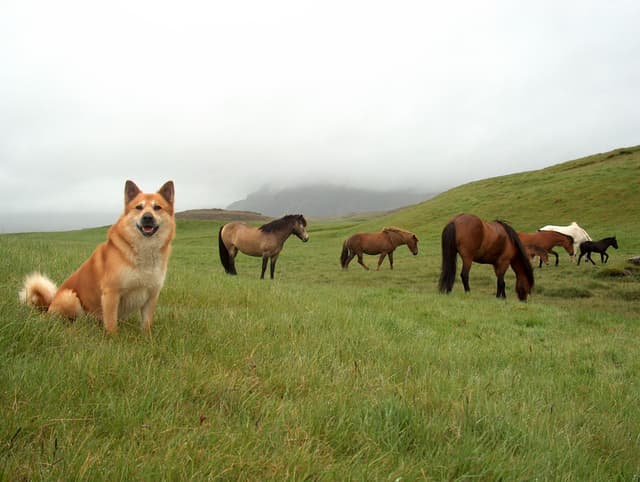
Stories about Icelandic sheep dogs
A while ago, I advertised for stories about Icelandic sheepdogs; old and recent, entertaining and poignant, interesting achievements and beautiful everyday stories. I want to create a collection of stories that touch peoples hearts and are representative for the Icelandic sheepdog. Now, the first stories are out there, and I am very pleased with the outcome. I still have to put more stories into the collection but it is good to get started to present them. I also hope to receive more stories that are enjoyable to preserve here. The stories can be found under the button labeled "SAGA," and I hope people enjoy reading them. In the end, I want to thank everyone who sent me stories and pictures. _In the picture above is Reykjadals Móri, taken by Brynhildur Inga._
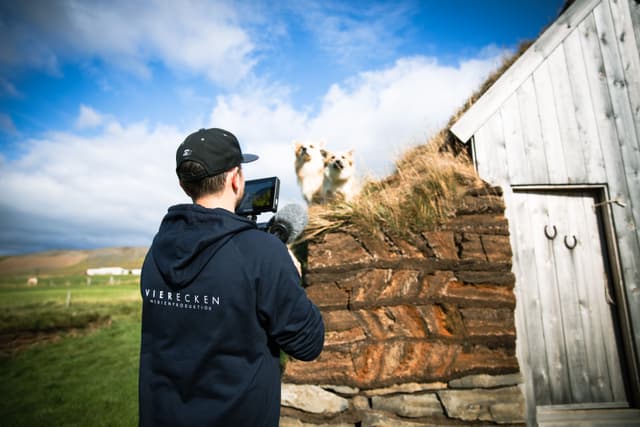
Exciting times ahead
Even though I haven't written much recently, I have been steadily working on the project, reading and researching. The next part of the website is almost ready, and it will include a section where you can browse and read stories about Icelandic sheepdogs that I have received. These are all sorts of stories, short and long, and it will be fun to get them started. Yesterday, I advertised again for old photographs and received so many responses, so many tips and pictures that I sat at the computer far into the night. Thank you to everyone who contacted me. I feel like I'm finally one step closer to having old photographs for the exhibition. There's so much coming up for us in the next few weeks. We plan to participate in the travel exhibition, Mannamót in Reykjavík next week, where we will introduce our exhibition to travel agencies and tour guides and distribute marketing material. In February, we will have a team join us to record various dog-related photography content and videos for the exhibition, and I am really looking forward to it. We know this young team that has previously created marketing material for us, and we met today to put together ideas and a work plan. Wow, this is all becoming so real!
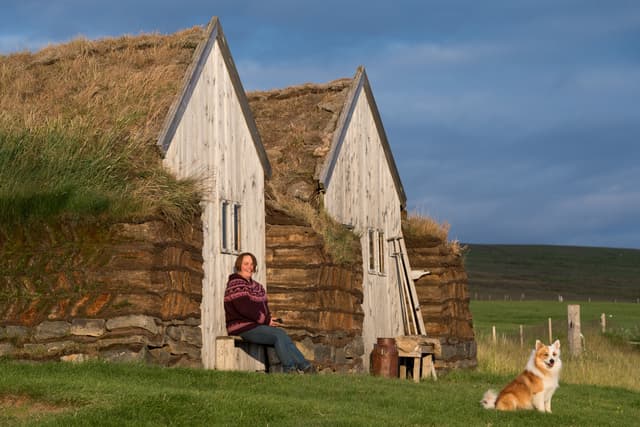
More funding for the project
This fall, I applied again for funding for the project on the Icelandic Sheepdog, as without funding it is impossible to work on such a project and bring ideas to life. Recently, I was informed of grants I will get. One is from a Development Fund in Northwest Iceland, which will fund me for a second time. This grant will cover the design and setup of the exhibition. I also received a grant from the Culture Fund of the local cooperative KS which will be put to good use in covering certain costs such as marketing. I am very grateful for this financial support which shows equal trust in my ideas and ability to bring up the exhibition about the history of the Icelandic Sheepdog which will hopefully raise the image of the national dog to a higher level.

The poem RAKKI
RAKKI Sá er nú meir en trúr og tryggur með trýnið svart og augun blá, fram á sínar lappir liggur líki bóndans hjá. Hvorki vott né þurrt hann þiggur, þungt er í skapi, vot er brá, en fram á sínar lappir liggur líki bóndans hjá. Ef nokkur líkið snertir, styggur stinna sýnir hann jaxla þá, og fram á sinar lappir liggur líki bóndans hjá. Til dauðans er hann dapur og hryggur, dregst ei burt frá köldum ná, og hungurmorða loks hann liggur líki bóndans hjá. This beautiful poem RAKKI is after Grímur Thomsen (1820-1896), an Icelandic poet. Grímur often sought inspiration from the past in the style of romantic poets. He wrote the poem, about an Icelandic dog that died of sorrow due to the loss of its master. The bond between a dog and its master can sometimes transcend death. I do not trust myself to translate this masterpiece and did not find a translation of it yet but the story behind the poem is believed to have taken place in East Iceland in 1869: _On the path to the churchyard in Þingmúla in Skriðdal there is a statue of a dog lying out on its paws. This is the path of Þorgrímur Arnórsson, who in his lifetime was a priest in Hofteigur in Jökuldal and in Þingmúla. He was a great farmer and animal lover. He had excellent horses and always had a dog which lay in his lap when he was at home, and always followed him on his travels. The last dog of Reverend Þorgrímur was called Rakki. When Reverend Þorgrímur died, the dog did not want to leave his body, and Rakki was promised to lie with the corpse. He could not be convinced to take food or drink. The body was put in a coffin, and Rakki kept vigil. Then the funeral procession began, and when the coffin was carried into the church, Rakki followed it to the church doors. When the coffin was carried out, it became apparent that Rakki had been waiting at the church doors. He followed the coffin, and when the grave had been filled in, he lay down on the grave mound. He was tried to be carried away, but he resisted the worst, and as soon as he was released, he ran out into the churchyard and lay down on Reverend Þorgrímur's grave. Rakki was given food and drink, but he did not take any of it, and eventually he died of hunger on the grave. A British traveller who came to Þingmúla was told the story of Rakki. He was so moved by it that he had a statue of the dog made and sent it to Iceland with the instructions that it should be placed on Reverend Þorgrímur's grave._ _Source_ [_Dýraverndarinn 1955_](https://timarit.is/page/4948420#page/n1/mode/2up)
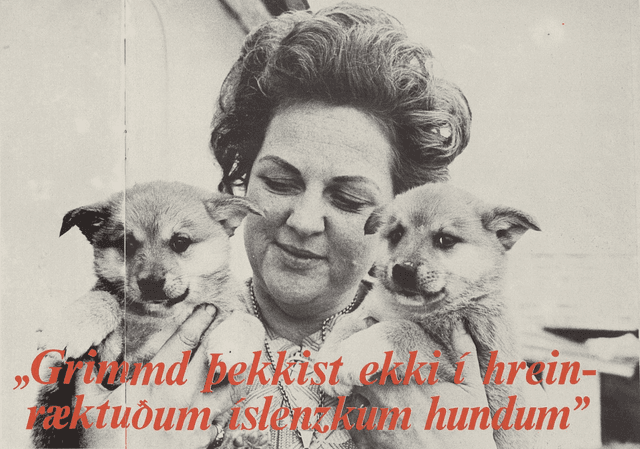
Sigríður Pétursdóttir from Ólafsvellir
Sigríður Pétursdóttir (1934-2016) from Ólafsvellir in Skeiðahreppur unquestionably had the greatest role in saving the Icelandic Sheepdog breed in Iceland by starting breeding work in the sixties in collaboration with veterinarian Páll A. Pálsson at Keldur. Páll A. Pálsson sensed the danger facing the Icelandic dog population and had purebred Icelandic puppies bred from the remaining bitch in Keldur, one of the dogs that Mark Watson had collected for export. The bitch was called Pollý and came from Tálknafjörður in the Westfjords. Sigríður also collaborated with Mark Watson and other parties in Britain who provided her with invaluable assistance and information about breeding. Sigríður then brought two females from Britain that Mark Watson gave her. The breeding stock in Iceland was very poor at that time, but Sigríður managed this extensive project. Sigríður, along with several others, founded the Icelandic Kennel club in 1969. In 2008, she was honored with the Icelandic Falcon Order at Bessastadir for her work in the breeding of the Icelandic Sheepdog. You find a great article in English about Sigríður after Þórhildur Bjartmarz on her website [Hundalífspóstur](http://hundalifspostur.is/2016/01/22/in-memory-of-sigridur-petursdottir/). There is much of interest in old interviews and articles about Sigríður, which say so much about her view of the breed and her breeding goals. [An article from 1973 quotes](https://timarit.is/page/4472538#page/n23/mode/2up): “This (achievement of Icelandic dogs in foreign shows) is not due to me but only to a small degree, said Sigríður, but it is due to the fact that the Icelandic breed is of good quality. It has been preserved by individual farmers who have wanted to keep their own dog breedline and skilfully bred it. We owe it to these few farmers that the breed has been kept pure…the danger of degeneration is always present in such circumstances, but these old people knew what they were doing and they have managed to get a strong foundation without degeneration.” When asked about the character of the dog, Sigríður replied: “The Icelandic dog is very strongly attached to human and is very sensitive to the feelings of its owner. They are very cheerful and follow the disposition of their owner. They are lively and entertaining if the owner is in such a mood, and they are calm if the master is calm. Aggression is not known in the pure-bred Icelandic dog. This quality has been eradictaed in the Icelandic sheepdog, because the farmers have put down aggressive dogs. Aggression is an unacceptable quality in the breed, since it is meant to drive livestock to and from, not to guard against attack as is expected of some other sheepdog breeds…in this way, this good character has been chosen and in my opinion, these qualities and cheerfulness are the strongest characteristics of the Icelandic dog.” In an interview in 1978 published in [Morgunblaðið](https://timarit.is/page/1502344#page/n9/mode/2up), she spoke about the nature of the dog: "The Icelandic is considered the only one of these Spitz breeds living in the countries around the North Atlantic that is not aggressive. Furthermore, the Icelandic dog is very intelligent, even though it is slow to mature....The Icelandic dog is very attached to its human and needs to be around people a lot." In one interview, Sigríður was asked about alspori dogs, which are dogs with double dewclaws on their hind and front paws. In the old days, it was believed that if a puppy was born as an alspori, it would be the best working dog. "-- Is there any truth to this superstition about alspori dogs? \---Maybe this is just superstition like many other things. Another thing is that perhaps people have paid more attention to teaching alspori puppies, because they were sold at a higher price and it was thought that there was more hope for success. Then the puppy has had more opportunity to learn and become a better dog for the job." Source: [Morgunblaðið, 1978](https://timarit.is/page/4472538?iabr=on#page/n23/mode/2up) What it means to breed dogs from a stock with only a few individuals is well expressed in an [interview from 2008](https://www.bssl.is/erfidast-ad-velja-undaneldisdyrin/): “What I found most enjoyable about my breeding at the time was that it was successful. But what was most difficult was when I chose the individuals that I could go on with breeding and had to let certain individuals go, had to put them down. I could not sell or keep more than a limited number of dogs which were not meant for further breeding. This was no 'production', but rather a precise and careful breeding and I had to choose and be careful about what I was doing. It wasn't finally possible to choose individuals to keep unless they were already of a certain age and when the traits, character, size and color could be seen. Everything had to be matched up as best as possible with what I was trying to achieve. The dogs had to be six months old before they could be evaluated and at that point they were already very attached to me.” Sigríðurs words show that she had great responsibility in breeding the Icelandic Sheepdog. She also expressed her concerns that the popularity of the dog could increase too much. She said: "If the Icelandic Sheepdog becomes fashionable then they will start to produce him instead of breeding him." I myself had never the honour to met Sigríður, but I have a lot of respect for this accomplished woman. I hope that her work to save the Icelandic Sheepdog will never be forgotten and will be kept alive for many years to come! Picture: [Víkan - 1973](https://timarit.is/page/4472538?iabr=on#page/n23/mode/2up)
Advent
One of the very famous dogs in Icelandic literature is the Icelandic sheepdog Leó from the book Advent by Gunnar Gunnarsson. The story of Benedikt's dangerous adventure with his dog Leó and the leading sheep Eitill, on their journey across the rugged wilderness of the north, is considered a masterpiece. Advent is based on the true story of _Fjalla-Bensi_'s searching trip in December of 1925. Benedikt sets out on a journey to the mountains in search of sheep that had not been found during the sheep round up in autumn. Benedikt is getting old, he is fifty-four. In the story, he is about to go on his twentieth and seventh search for sheep at the beginning of Advent. He starts the journey on the first Sunday of Advent and with him are his dog, Leo, and the ram Eitill. Benedikt looks upon them as his trusted friends. They are also necessary for the journey because of their sense of direction and ability to herd sheep. Gunnar Gunnarsson (1889-1975) was one of the foremost Icelandic writers of the 20th century. No book of Gunnar's has gone as far as Advent, which has been translated into about 20 languages. In Sarpur, the cultural historical database, I came across this interesting picture of _Fjalla Bensi_. It is owned by the Museum in Akureyri and I could order it from there. The picture is by Bárður Sigurðsson (1877-1937) and it comes with the following description: "_Fjalla-Bensi, Benedikt Sigurjónsson born on April 9th, 1876 on skis with a dog and sheep, in the studio of Bárður in Höfða. It is not certain whether these are the dog Leó and the lead sheep Eitill._ _It's interesting to take a closer look at this picture. Much effort has been put into taking up turf and putting it on the floor so that it looks like Benedikt is standing on skis with the view of Mývatnssveit behind him. To the left, Bárður's forge can be seen and to the right, a coffin. Bárður's photo studio was also his forge in Höfða, so he earned a living in this studio, both with smithing and photography._ Reading the book Advent has become an annual tradition for many during December and I can recommend reading it now during Advent and dive deep into the adventure and view of life of Fjalla Bensi, together with his sheep dog Leó and Eitill the ram.
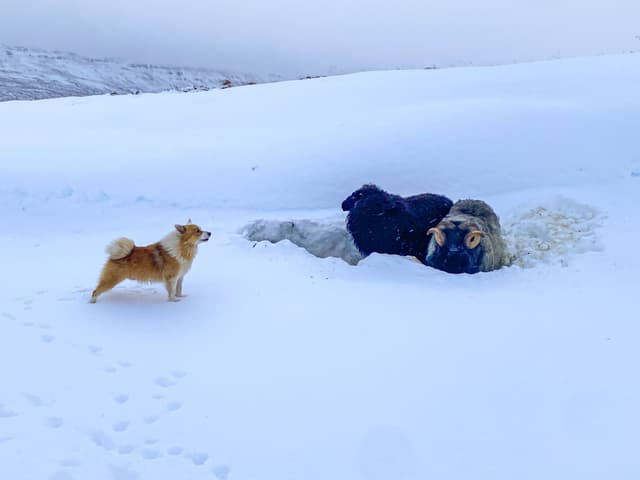
Sense of smell
It's dark outside and winter has set in with the associated stormy weather. Then it's best to rummage around a bit, and today it's a questionnaire about dogs in Sarpur, a cultural historical database, that was chosen. I came across a story about the dogs' sense of direction and sense of smell, which I would like to quote here. It is a man, born in 1912 who writes: "Stories of the wisdom of dogs will be countless, but I lack the knowledge to trace them here, as it would be too long. It is certain that many people who were lost in storms or snowstorms resorted to letting the dog lead them home, and it rarely failed. It often happened that sheep were lost in storms and sometimes survived in the snow for weeks and months. Then it was good to have a dog that could find the lost sheep, and some farmers had them and were then hired for searching. These were dogs of the Icelandic breed. Some of them could distinguish whether the livestock in the snow were alive or dead. One farmer had two such dogs, one only searched for living sheep, and the other for dead." Attached is a picture from October this year.
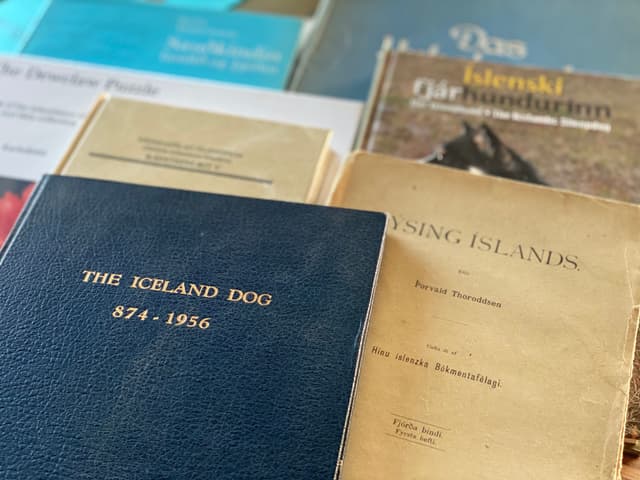
Books
I love books and for that reason I am incredibly pleased to have some books either about the Icelandic sheepdog or containing material related to Icelandic dogs and their history. In my collection is The Iceland Dog 874-1956 by Mark Watson which refers to many old books and I find it fun to dig up these primary sources. Some I have found online (in digital libraries) and some I got in antiquarian bookshops, for example Das unbekannte Island by Wather Heering (1935), Lýsing Íslands IV by Þorvald Thoroddsen (1920) and the large travel book by Eggert Ólafsson and Bjarna Pálsson 1752-1757. So is the book Icelandic Sheepdog by Gísli Pálsson (1999) in which he briefly goes over the history of the Icelandic sheepdog and then gives an overview of the breeders of Icelandic sheepdogs at the time the book was published. The breeders describe their dogs their breeding is based on and it is very informative to read through this because the number of pure bred dogs is still rather small at this point in time. There are also pictures of the main coat colors of the Icelandic Sheepdog and a name bank in the book. The books by Stefán Aðalsteinsson are interesting because he has researched the origin of domestic animals in Iceland and is often referred to in recent sources. Much interesting information about Icelandic farm animals can be found in Íslenzkir Þjóðhættir by Séra Jónas Jónasson from Hrafnagili (1934). In the book The Dewclaw Puzzle, Moniku D. Karlsdóttir writes about her theory of the inheritance of dewclaws in the Icelandic sheepdog. I'm sure there is much more about Icelandic sheepdogs hidden in my book shelves that I have not yet found. If someone knows about "hidden" stories in various books, please do not hesitate to let me know and contact me by email at [email protected].
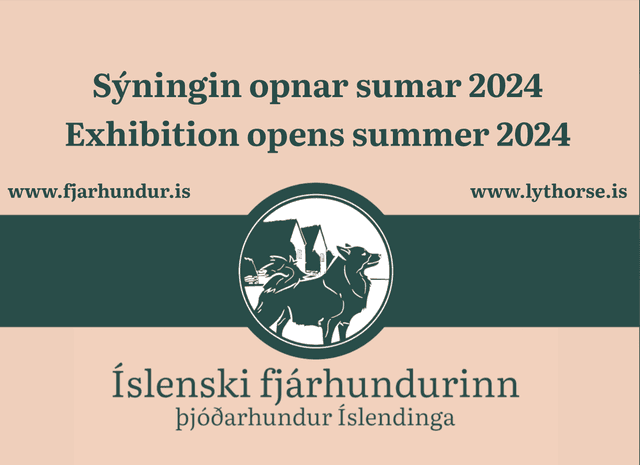
The goal 2024
About a year ago I started working on the project about the Icelandic national dog and I am pleased with the progress. I have read a lot, both in books and on the internet. I have connected with many people, both at home and abroad, and I find that most of the people I have talked to have a burning interest. I have been collecting stories and pictures and I need to keep finding interesting content in the database. It's a bit slow to get answers from local photo galleries/collections to be able to buy old pictures but I will continue to work on it. Now is the time with the shortest days of the year, which is exactly the best time for me to work on this, and next on the agenda is to set up space on the website to publish the stories I have been given. There is still a lot of work to be done but the goal is set: opening the exhibition in the summer of 2024. I look forward to bringing my ideas about the exhibition into action and of course I will continue to talk about the progress of the project here in the blog along with various speculations and interesting information.

Origin of the Icelandic sheep dog
It is said that dogs were brought to Iceland in the 9th century by the first settlers, just like other animals, and dogs were to assist with herding and grazing of sheep, cattle and horses, as fencing was not present in this untamed land until the 20th century. Little is written about dogs in Icelandic literature and it is not known what farm dogs looked like in the settlement period, but in the story of King Olaf Tryggvason, it is said that there was a famine in Iceland in 990. It was proposed that most or all dogs in the country should be killed because they were so many that the people could be saved from starvation with the food that went into the dogs. But the farmers did not follow these instructions and the dogs held on to life. The most famous dog in Icelandic sagas is probably the dog Sámur owned by Gunnar in Hlíðarendi, who was most likely an Irish wolfhound. Sources tell us that during the Middle Ages, the Icelandic dog had become a sought-after export item, as a house pet of English ladies of high rank and in 1570 the Icelandic dog was described as being so furry that it was almost impossible to distinguish head from body. Eggert Ólafsson and Bjarni Pálsson travelled around Iceland between 1752-57 and in their travel book there are good descriptions of the Icelandic dog at that time, they spoke of three types of dogs: sheepdogs, hunting dogs and dwarf dogs. The sheepdogs are described as such: They are smaller than the others, hairy, with thin, short legs. The tail is rounded and the muzzle short and narrow. They are very useful for gathering sheep. They seek the sheep, if directed, high up on the mountains and herd them into a group, where the shepherd is waiting, and track the sheep without biting or otherwise harming them. Some of the sheepdogs are especially thick-haired and curly-haired. They are called lubbar and are considered more willing to learn than other dogs. It is interesting to speculate about the origins of the Icelandic Sheepdog. Some sources credit the Norwegian Buhund, which was brought here by the settlers, but in 1983 the blood of 56 Icelandic Sheepdogs was tested to investigate the breed’s origin. The results showed a clear connection between the Icelandic Sheepdog and the Finnish Karelian Bear Dog. The Karelian Bear Dog is of Russian origin and is one of the so-called Laika dogs, which have erect ears and rounded tail. It is therefore clear that the Icelandic Sheepdog has been brought here from Norway, and the affinity to the Karelian Bear Dog also points to the fact that the dog must have come from the east, just like the Icelandic horse breed because it is descended from Norway and its roots can be traced east to Mongolia. Picture: Icelandic Sheepdog probably from the South Iceland. From the Photo Archive of Byggðasafn Garðskaga. Author and year unknown.
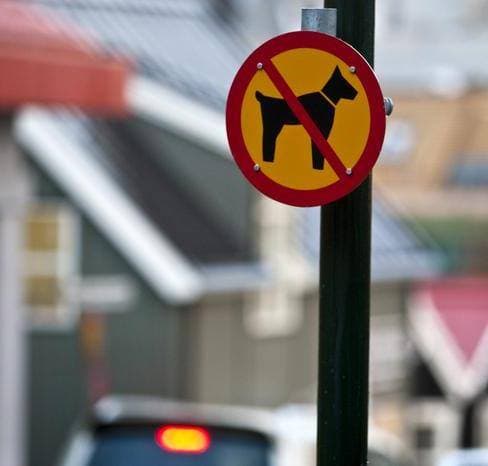
Dogs banned in Reykjavík for 60 years
Icelandic society changed rapidly and significantly in the 20th century. The fishing industry began with the arrival of motorboats, fishing villages were established and urban areas increased in population. People moved from their farms in the countryside to the developing capital Reykjavík. Dogs often followed their owners to their new homes. At this time, farming was still practiced in Reykjavík and the dogs that came from the countryside mixed with the dogs that were already there. As a result, there was a great increase in stray dogs running loose in the streets of Reykjavík and caused trouble and impurities. By 1910, the dog population in Reykjavík had become very large and actions to combat hydatid disease had not yet reached success. These were the two factors contributing to the dog ban in Reykjavík. In order to respond to the situation, Regulation No. 124 from October 26, 1910, was put in place regarding restrictions on dog keeping in Reykjavik. The regulation specified the obligation of dog owners to mark their dogs with a special Reykjavik brand. Those dogs that did not bear such a brand or were considered stray dogs, dogs that were not visited within three days of being advertised, were declared outlawed and should be killed. On the other hand, the regulation provided for annual dog deworming and that tapeworm cysts should be buried in the ground. When these measures proved unsuccessful, suggestions were introduced to grant authorities to restrict or prohibit dogs in towns in 1924. The suggestions were approved and law No. 8/1924 was passed to ban dogs in towns and urban areas. Based on this new law, a regulation on dog keeping in Reykjavík was introduced. It stated that no one in Reykjavík was allowed to have a dog unless he had a permit for a working dog. Each dog could be killed unless a permission had been granted for him or he was accompanied by someone from outside Reykjavík. The police had to enforce the ban and hundreds of dogs were killed in Reykjavik after the dog ban was put into place. Most of the dogs were put down in 1948 or 170 dogs. In 1953, 64 dogs were put down and at least 70 dogs in 1954. No mercy was shown to illegal dogs and they were taken and shot. Source: [Vísir](https://timarit.is/page/1180763#page/n11/mode/2up) In 1968, all farming and livestock handling in Reykjavík was banned, thus ending the era of the working dogs. Around the same time, discussions began about the future of the Icelandic Sheepdog, as people believed that the breed was on the brink of extinction. Calls for official participation in the form of subsidies for breeding and saving the Icelandic sheep dog were made. In 1969, two organizations were founded for the benefit of dog lovers and owners: the Dog Friends Association and the Icelandic Kennel Club (HRFÍ). The goal of the organizations was to fight for legal dog keeping in the city, but the main goal of HRFÍ was to protect the Icelandic Sheepdog breed through careful and organized breeding. The establishment of the organisations had a great impact in how the discussion about dogs and dog keeping in Reykjavík developed. The years 1983 and 1984 marked a turning point in the fight against the dog ban and its support by the government. Two things should be mentioned in this context. On the one hand, there was an incident in Reykjavík when two dogs were put down on the spot without a trial or law in 1983. See article in [Morgunblaðið](https://timarit.is/page/1580725#page/n47/mode/2up). On the other hand, it was the case of Finance Minister Albert Guðmundsson. Journalist Rafn Jónsson sued Albert for illegal dog keeping after publicly describing Albert's dog-keeping on television. Rafn argued that the public had to accept laws while the upper class kept their dogs untouched. Albert was opposed to the dog ban from the beginning and considered the dog-keeping laws outdated and unjust. After Albert had been sued, he declared that he would rather leave the country than let his bitch Lucy go. The case received a lot of attention both [domestically](https://timarit.is/page/4029413#page/n3/mode/2up) and [abroad](https://timarit.is/page/2235862#page/n0/mode/2up). The case of Albert led the administration of Reykjavík to have to find a solution to the problem. Sixty years after the dog ban was introduced to Reykjavík it was lifted in 1984 with the Decree on Dog keeping in Reykjavik No. 385/1984. Dog keeping was still banned, but an exemption could be applied for. It wasn't until 2007, however, that the dog ban was completely lifted and the exemption from the ban was changed to a permit. Finally, it is worth mentioning that the current Icelandic laws give local authorities a lot of autonomy when it comes to dog keeping. For example, the Decree on Dog keeping in Akureyri from 2011 states that "Dog keeping is prohibited in Grímsey and dogs may neither reside there nor visit." Grimsey is an island, 40 km off the north coast of Iceland, part of the municipality of Akureyri since 2009. This post only skims the surface of a rather large matter, but I tried to summarize the most important points.
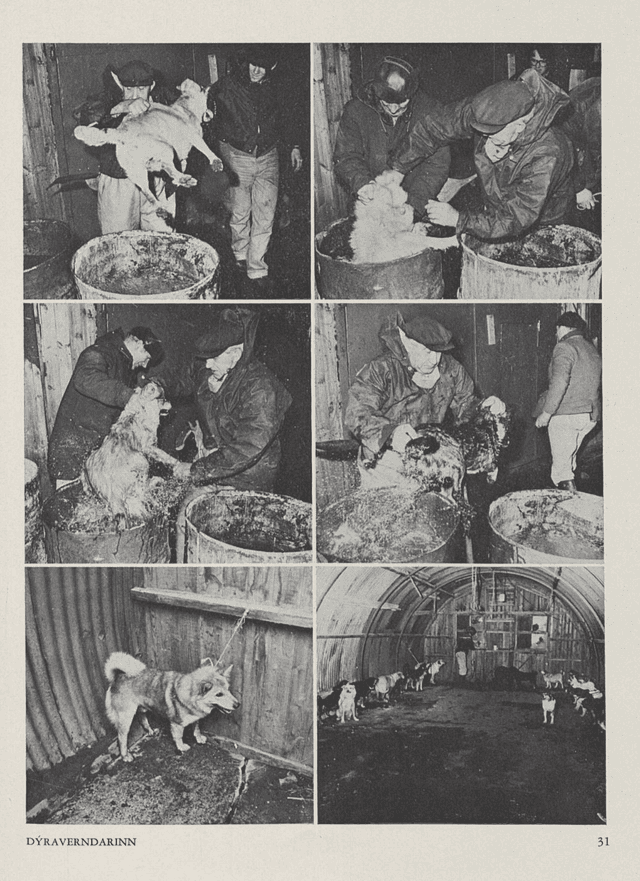
Hydatid disease and deworming
Icelandic people suffered from hydatid disease for many centuries and it was one of the most serious diseases of the country for a long time. It is well known that Iceland has long been considered the worst hydatid disease area in the North Atlantic and further afield - writes Guðmundur Magnússon in Overview of the History of Hydatid Disease in Iceland ([Yfirlit yfir sögu sullaveikinar á Íslandi, Reykjavík 1913](https://timarit.is/page/4911631#page/n0/mode/2up)). It is believed that hydatid disease was initially brought to the country by sick dogs imported from the western countries, especially from Germany. The oldest historical sources indicate that by 1200, the hydatid disease was known in both humans and animals. The cause of the disease is the larvae of several subspecies of Echinococcus tapeworms that use intermediate hosts (f.e. sheep) that contain eggs of the tapeworms and are then infected with tapeworm larvae when the final host (dog) eats the intermediate host's organs that is infected with tapeworm cysts full of larvae. [See more here.](https://en.wikipedia.org/wiki/Echinococcosis) The Danish doctor Harald Krabbe came to Iceland in 1863 and stayed here for research on tapeworms in dogs along with Jóns Finsen, district doctor in Akureyri. They found that 28% of the Icelandic dogs were infected. At this time there were about 70,000 Icelanders and the estimated dog population at the same time was 15-20,000, or one dog per 3-4 inhabitants. Krabbe concluded that the spread and prevalence of hydatid disease in Iceland was mainly due to the fact that here, compared to the headcount, there were many more dogs than elsewhere (Guðmundur Magnússon, 1913). The hydatid disease could kill people and animals and it was estimated that every fifth Icelander was infected with the disease. Krabbe thought that the best way was to reduce the number of dogs and educate the Icelandic people about the nature of hydatid disease and ways of preventing the disease. These conclusions were followed by the Dog Ownership Regulation of 1869 ([_Tilskipun um hundahald 1869_](https://timarit.is/page/4911674#page/n43/mode/2up)_)_ to reduce the number of dogs and the Dog Tax Law of 1890, but it was not enough to improve the situation. It was common practice on the farms that dogs were allowed to lick people's bowls, eat slaughter waste, hang around yards and barns, sleep in sheep folds at night, and drink from people's water containers. From the turn of the century, dog deworming came into play. Dogs were collected together for deworming on certain days and were given worm medication. Dog deworming was done in a house or barn, where the floor and walls were made of stone or other dense material, which was easy to clean. The dogs had to be fasted 24 hours before the injection. It was necessary to make sure that the dogs did not throw up after the injection, otherwise it had to be repeated. After they had finished cleaning themselves with enormous diarrhea while they were tied up in the barn for up to six hours, they had to be bathed in a special cleaning agent before they were allowed to go home. This method was used for a long time in some municipalities, see article in Animal Guardian ([Dýraverndaranum](https://timarit.is/page/4954468?iabr=on#page/n29/mode/2up/search/averndarinn)) from 1 February 1978 . But as harsh as the dog deworming practice was, it led to hydatid disease being eradicated in Iceland in the 20th century and so the disease is no longer found in Iceland. Today, treating dogs with worm medicine is necessary [due to the tapeworm](https://www.vet.cornell.edu/departments-centers-and-institutes/riney-canine-health-center/health-info/tapeworms), but fortunately, the methods are different from before. The picture above shows the deworming practice in Iceland in the old days. See the full picture [here](https://timarit.is/page/4954468?iabr=on#page/n29/mode/2up/search/averndarinn).
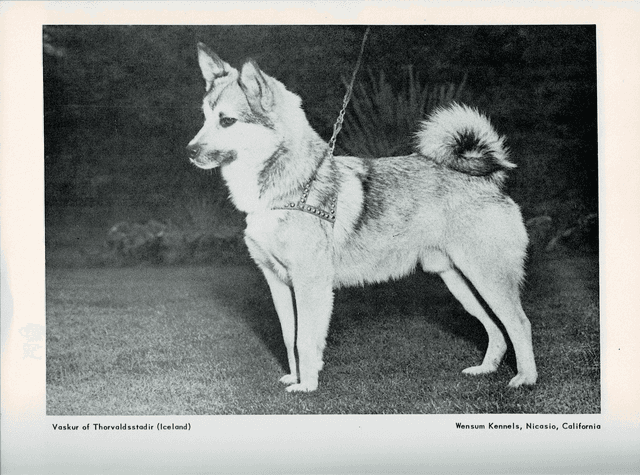
Vaskur of Thorvaldsstadir - the HRFÍ logo model
Vaskur of Thorvaldsstadir was one of eight dogs that Mark Watson bought in Iceland and moved to California in the fifties to breed Icelandic sheepdogs so they wouldn't become extinct. Shortly after the dogs arrived to California, a dog plague struck and some of the dogs died. Those who survived had descendants and seemed to not have mixed with other breeds. Watson later moved back to England and took the dogs with him to keep the breeding going. Vaskur survived the dog plague and moved with Watson to England. There he had a big success at the Crufts dog show in 1960 when he became BOB (best of breed), at seven years old. [In an article from February 1960](https://drive.proton.me/urls/4JV6CQVNYM#xVGAiQfZfkSL), most likely from the magazine [Our dogs](https://www.ourdogs.co.uk/subindex/home.php) the judge Mrs. W. Barber is quoted: "Vaskur completely won over me as a good looking medium sized dog, sound and with the essentials of his breed standard clearly defined, he was a happy and friendly dog to meet and appeared to be enjoying his outing." Vaskur was judged "Novice 1" and "Open 1". Here one can see [the breeding standard](https://drive.proton.me/urls/XPXMMA6CHG#mjGHVKziw0wn) of that time that Vaskur was likely judged by. In 1969, the Icelandic Kennel Club (HRFÍ) was founded at Hotel Saga in Reykjavík. 29 enthusiasts of Icelandic sheepdog breeding stood at the founding of the club. One of its goals was to protect and breed the Icelandic sheepdog and the first board agreement was to prepare the registration of the Icelandic sheepdog's characteristics. A picture of Vaskur of Thorvaldsstadir was then the model for the logo of the [Icelandic Kennel Club](http://www.hrfi.is/english.html). The kennel club later got membership of the international dog breeding associations FCI and the Nordic Dog Breeding Associations NKU and today is a collaborative platform for owners and enthusiasts of various dog breeds. [The Icelandic Sheepdog Department (DÍF)](https://www.dif.is/DIF/index.php) was founded in 1979 and operates within HRFÍ as one of its largest departments. The logo of the department is the same except Vaskur is looking the other way. Hopefully Vaskur will be able to be at peace in the kennel clubs logo for the coming times as a representative of Icelands national dog. The picture is from Mark Watsons book _The Iceland dog 874-1956._
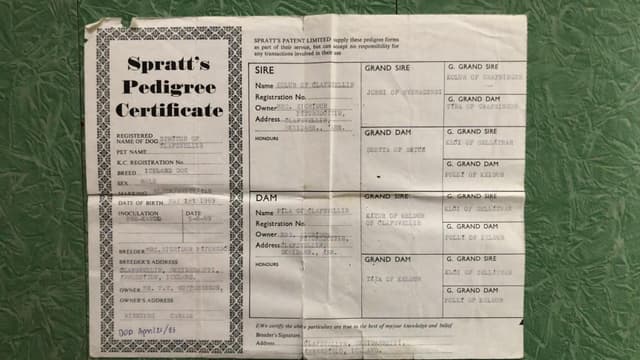
Notable dogs
In my research on the history of the Icelandic Sheepdog, I have come across many interesting stories about dogs and people. I'm trying to structure all the material I've read and gathered to present it on this site and also in the exhibition. For this, I read many things more than once to better understand all contexts. For instance, I just revisited [an article about Kátur from Keldur](http://hundalifspostur.is/2016/01/27/ur-sami-katur-fra-keldum/) where it states: "Kátur from Keldur, ID number 11-68, passed away on December 22, 1978. This notable dog, from whom most if not all Ólafsvellir dogs trace their lineage, was born at Keldur in October 1959 and was thus in high age when he died. He spent the first years of his life in Írafell in Kjós but came to Sigríður and Kjartan in Ólafsvellir in 1964 and remained there until his death. Kátur from Keldur was a much-indulged dog in this large household and enjoyed various privileges, as there were always many dogs there. In the last two years, his health deteriorated, his sight and hearing failed, and he became arthritic. Kátur was a very beautiful dog at his best. Red-golden, with a white spot on his neck, white paws, and light in the tail. He was big and handsome, perhaps a bit too long if anything, but otherwise well-built. His temperament was especially good, and no one doubted his intelligence who knew him. He has a vast lineage. Kátur's parents were Klói from Sellátrar and Pollý from Keldur, and all currently living Icelandic dogs trace their lineage back to these notable dogs. G.S." The picture of Kátur that accompanies the article reminded me of the picture I used in the blog post about Strútur, Kolur, and Mark Watson. That picture is of Kolur, Strútur's father. I started looking into the material Salín sent me about Strútur, and among other things, there is a copy of Strútur's pedigree. There I saw that Kolur, Strútur's father, is not a son of Kátur, but Strútur's mother is a daughter of Kátur from Keldur. Her name was Píla from Ólafsvellir and her mother's name Táta from Keldur. Upon closer inspection, it turns out that Táta, Kátur, and Kolur's mother, named Skotta from Sætún, were all siblings. Look at the picture above for a better understanding! Their parents were, as mentioned above, Klói from Sellátrar and Pollý from Keldur. Klói had four offspring with Pollý, but according to the [DÍF database](https://www.dif.is/hundarnir/hundar_grunnur_einstaklingur.php?id=4582), Pollý also had Snotra. Snotra was a son of Tryggur, who was a descendant of the siblings Kátur and Skotta. Snotra is not listed in the [ISIC database](http://www.islenskurhundur.com/Dog/Details/5097) as far as I know. This clearly illustrates the challenge at the time of breeding the Icelandic Sheepdog from a very small stock of dogs, and it's truly an incredible achievement that it was successful. I decided to include Strútur's pedigree (with thanks to Salín) with this post, and pictures of Klói and Pollý can be found in the [ISIC database](http://www.islenskurhundur.com/Dog/Details/4965).
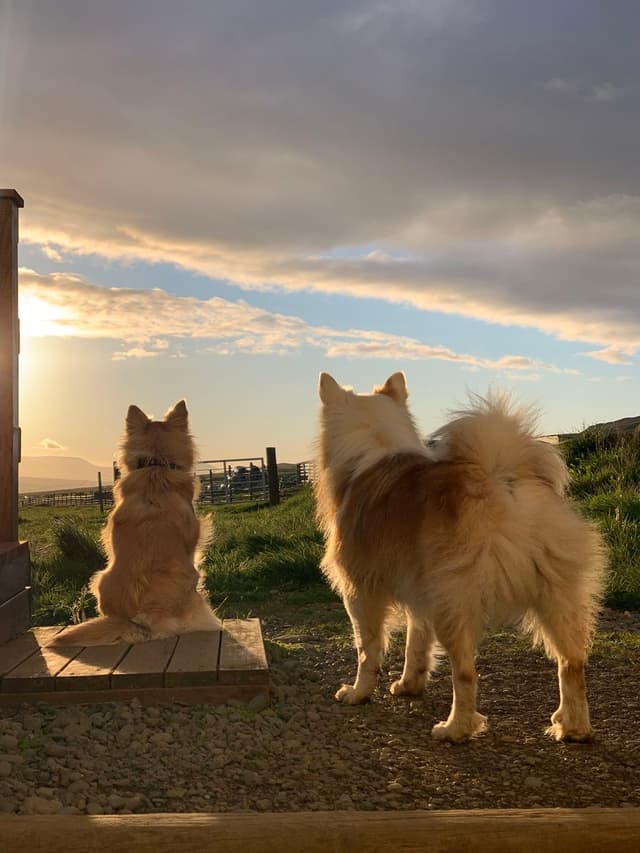
Pish for thee Iceland Dog! Thou prick-ear´d cur of Iceland!
Yesterday, we welcomed a group of British tourists in our popular program, Horses & Heritage. As often before, the visitors showed no less interest in the dogs than the horses, and they of course received an introduction to Icelands national dog. The group had been to Glaumbær and had received information about the British nobleman Mark Watson and his rescue measures regarding the old farm. I explained to the people the role Watson played in the rescue of the Icelandic Sheepdog, and they were quite surprised that the breed is not well known in Britain and not recognized by the British Kennel Club. I then told them that the Icelandic Sheepdog was particularly favored by the British elite in the 16th century and that William Shakespeare even mentioned it in the play "Henry V.", written around 1600: Pish for thee Iceland Dog! Thou prick-ear'd cur of Iceland! These are probably not the nicest words that have been written about the Icelandic Sheepdog, but nevertheless, they are evidence that the dog breed from our remote island in the Atlantic was known in Britain at that time. Our British guests found it very interesting to learn about the Icelandic Sheepdog and its connection to their own homeland.
Is the Icelandic sheepdog a working dog?
I was wondering how much people use the Icelandic sheepdog as a working dog. I posted the question on the Icelandic sheepdog department's Facebook page the other day and received a tremendous response in a short time. It appears that the dog is still used around sheep. They actively participate in sheep gathering in the autumn, saving people and horses many steps in the Icelandic highland pastures. They can be sent a long distance away or kept barking by one's side. The Icelandic sheepdog is a herding dog, keeping sheep away from houses, pastures and woodland within a certain radius and thus being invaluable to many. The dog is also used around horses. Some dogs fetch horses from the pasture and drive them to their owners. Stories were told of dogs hunting mice just like cats, which is well-received in rural areas. There was a discussion about the working nature of the Icelandic sheepdog, which is very different from the nature of the Border Collie (BC). While BC dogs herd sheep by running around them and are usually silent, the Icelandic sheepdog barks while working. This working nature suited (and still suits) Icelandic conditions and landscape. Most owners of an Icelandic sheepdog in the city probably want it to bark as little as possible, which leads to a certain tension between the dog's thousand-year-old nature and modern life expectations. But no one wants a dog that barks excessively, which everyone agrees on. Breeders have an undeniable responsibility when choosing dogs for breeding. Arnþrúður Heimisdóttir, who has bred Icelandic sheepdogs since 1998 under the name Fljóta-kennel, provided an informative contribution on her theories regarding the history and breeding of Icelandic dogs over the centuries. I was given permission to publish her segment here: \--- Why did Icelanders have dogs: 1\. To comfort little children, preventing them from becoming paralyzed with fear and loneliness, children who were expected to be shepherds day and night, terrified by tales of trolls and ghosts. To be their friends (since they might be the best dogs in the world to instill trust and courage in people, being friendly and brave). 2\. To drive sheep out of pastures, acting as a virtual fence since people built their farms right in the middle of the best pastures. So the dogs stayed home at the farm and drove away animals all day. I heard in a radio show recently about a foreign traveler's account from the 1800s describing how every farmer had about 5 dogs that chased out roaming animals and horses (since there were no fences back then). The history of Icelandic agriculture tells us that there was immense pressure after the settlement to fence in, using stone walls, to separate grazing lands and pastures. All men were legally obligated to work on this for one month each year. Then around 1200, this was removed from the law as it was too much work. My theory is that people started breeding these indigenous dogs that drove out of pastures, as most/all stone walls soon became unusable. 3\. For gathering and herding in autumn, also during winter time when farmers moved livestock from shelter to winter pasture in often snow and harsh weather conditions. They also helped children/shepherds drive the flock out for grazing and back home. I doubt they've ever herded sheep like Border Collies. At least I've never noticed any Icelandic sheep dog doing it today, but perhaps you can point to other examples. 4\. To help people find their way home in snowstorms, both travelers who unexpectedly got caught in a snowstorm, and winter shepherds who faced the same with their sheep. 5\. To help people find livestock buried in snow after snowstorms. \--- I thank everyone who participated in the discussion, which was both enlightening and necessary. We must never forget what the dog was used for throughout history, which shaped the dog's nature we know today. I personally want to see more Icelandic sheepdogs in the country's rural areas. As the national dog of Iceland, it should be a pride on many if not all farms all around the countryside. Being a farm dog does not exclude it from being a show dog. There are examples of Icelandic sheepdogs that have received champion points and champion titles at HRFÍ shows and also perform very well in herding and driving livestock. Let's be proud of this friendly and diligent national dog and work against prejudices that it's just a useless barker. Show responsibility in breeding and respect the dog's nature. Train it well and let it work according to its nature if the opportunity arises!
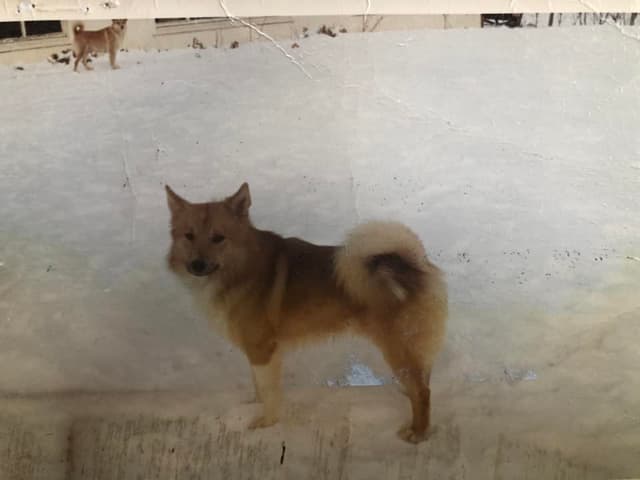
Strútur, Kolur, and Mark Watson
Working on this project is both intriguing and enjoyable. I am deeply passionate about it and feel an immense need to collect information and stories about the Icelandic Sheepdog. We need to preserve these stories and make them accessible for the future. The dog is part of our cultural heritage, and it has accompanied the nation through thick and thin for over 1000 years. It is the responsibility of our generation to maintain a testament to its history. I came across a Facebook post related to Icelandic Sheepdog Day where a Canadian woman showed a picture of a dog named Strútur. Strútur was the first known Icelandic Sheepdog in Canada in recent times, arriving there in 1969. I got in touch with Salín Guttormsson, the woman who posted the picture, and we have been communicating since then. Salín recently published an article about Strútur's history in "Lögberg - Heimskringla", and she gave me permission to post it on this website (which will likely be available in the fall). Salín's father had corresponded with Mark Watson in 1970 as he tried to purchase the book "The Iceland dog", which unfortunately was out of print. Watson replied that the book was sold out and no copies were left, but he sent him photocopies of the main sections of the book, along with an revised introduction. In his letter, Watson wrote that there were about 50 Icelandic Sheepdogs in Britain and they were recognized by the English Kennel Club. The Club had recognized the breed in 1905. However, the breed is not recognized today as there are too few Icelandic Sheepdogs in Britain. Watson also mentioned in the letter that he had recently moved two dogs to England which he purchased from Sigríður Pétursdóttir of Ólafsvellir. And Strútur also came from Sigríður's breeding. I am including a picture here of Kolur, Strútur's father. Sigríður Pétursdóttir took the picture in 1969. Salín allowed me to show this picture, and I am immensely grateful to her for sharing the story of Strútur and the correspondence between Watson and her father. Receiving these narratives is invaluable to me.
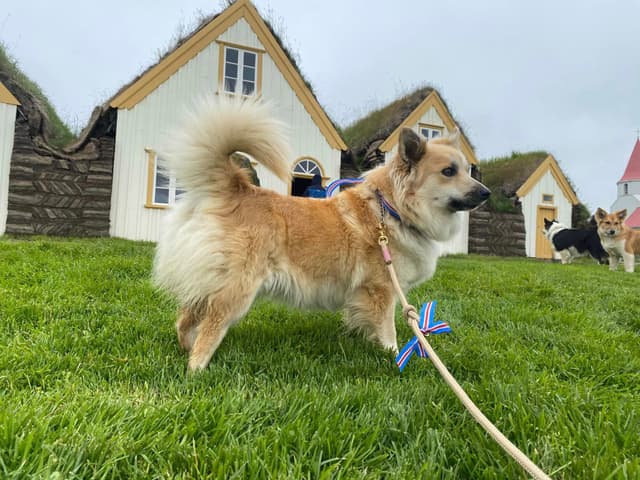
Happy Icelandic Sheepdog day!
Today is the day of the Icelandic Sheepdog! In the breeding goal for the Icelandic Sheepdog, it is stated: "The Icelandic Sheepdog is Iceland’s native breed of dog. It is the descendant of the dogs brought to Iceland by the original Viking settlers (AD 870-930). The dogs became indispensable in the rounding up of livestock and in the daily work on the farms. Their method of working adapted to the local terrain, farming methods and the people’s hard struggle for survival over the centuries. The Icelandic Sheepdog is a Nordic Herding Spitz, slightly under medium size, sturdy, with erect ears and a curled tail. Seen from the side the dog is rectangular. The expression is gentle, intelligent and happy. A confident and lively bearing is typical for the breed. There are two types of coat, short and long, both thick and very weather-resistant. There is a marked difference in appearance between the sexes" Those interested can continue reading in [FCI-Standard N° 289.](https://www.dif.is/UmTegundina/289g05-en.pdf) As usual, we visited the heritage museum in Glaumbær today and enlightened and educated the museum's guests about our national treasure! Happy Icelandic Sheepdog day!
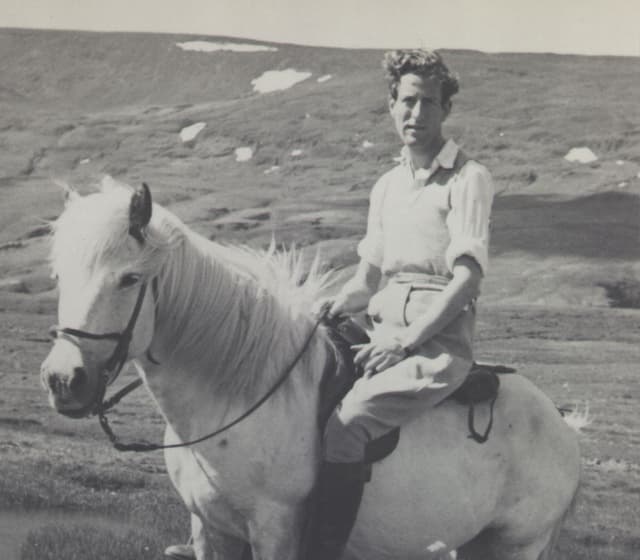
Mark Watson - the savior of the Icelandic Sheepdog
Mark Watson is known to many owners of Icelandic sheep dogs all over the world. Watson's achievements can't be adequately summarized in a short blog post, and he will be given more space on the website and in the upcoming exhibition. But I will still summarize a few points as we approach the Icelandic Sheepdog Day on July 18, which is Mark Watson's birthday. Mark Watson was born on July 18, 1906, in the United Kingdom. His family was very wealthy, owning an estate in Scotland and a summer house in Austria. They lived lavishly in London. Watson was well-educated and studied at the best schools in Britain and on the continent. He spoke fluent French and good German. He traveled extensively and developed an interest in Iceland from an early age. He dreamed of adventures in Iceland and made his first trip to Iceland in the summer of 1937. The following year he traveled around the country on horseback. During these trips, he took photographs and motion pictures, which were shown in London and at the World's Fair in New York in 1939. Watson was very generous to Icelanders. He donated over a hundred watercolor paintings by Collingwood, a British painter who traveled around Iceland at the end of the 19th century, to the National Museum, along with other artworks he gifted to the museum. In the summer of 1938, he came to Glaumbær in Skagafjörður and fell in love with the old farm. Watson wanted to buy Glaumbær, restore it to its original form, and turn it into a museum. But the farm was not for sale. When he got home, he decided to send two hundred sterling pounds to Iceland, so that repairs could begin on Glaumbær. Watson was a great dog lover and was one of the first people to realize that the Icelandic Sheepdog breed was dying out. He therefore decided to save the breed. He had dogs collected that had the typical appearance of the Icelandic Sheepdog and bought them. Later, they were sent to California where he lived for years on the Wensum kennel farm in Nicasio. In 1957, Mark Watson published a book on the Icelandic dog breed. The book is called The Iceland Dog 874 – 1956 and in it, Watson lists all the data he found about the Icelandic Sheepdog. Watson helped Sigríður Pétursdóttir from Ólafsvöllur (who will receive a more detailed review on this site later) to transport Icelandic Sheepdog puppies from his breeding from England to Iceland to start important breeding work. Sigríður Pétursdóttir, along with others, founded the Icelandic Kennel Club HRFÍ in 1969. The aim of the association was the protection and breeding of the Icelandic Sheepdog breed. At the founding meeting, it was agreed to show the Iceland friend Mark Watson the respect of making him an honorary founding member, as he has initiated the protection of the Icelandic Sheepdog, in addition to writing a book about the breed. In early 1973, Watson gave Icelanders a fully equipped animal hospital. Mark Watson died at his home in London in March 1979. Interested parties are referred to the booklet of the Skagafjörður Heritage Museum [Mark Watson and Glaumbær](https://www.glaumbaer.is/static/files/Skjol/vi-mark-watson-og-glaumbaer.pdf) and the article [Mark Watson and the day of the Icelandic Sheepdog](https://hundalifspostur.is/2015/12/15/the-honourable-richard-mark-watson/) by Þórhildur Bjartmarz to learn more about him.
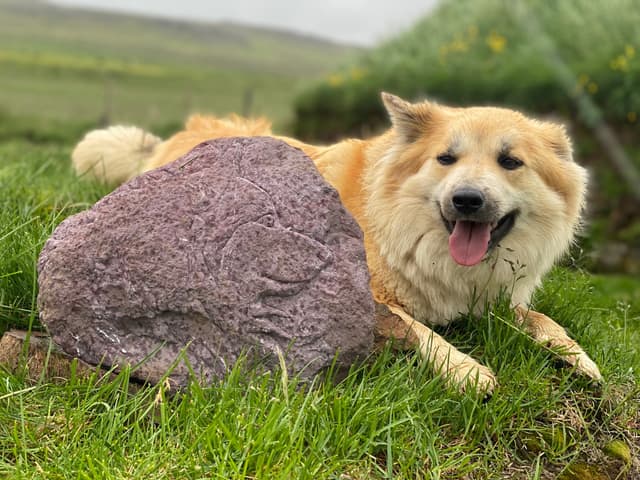
Artwork in honour of the Icelandic sheepdog
I commissioned the young artist Josefina Morell, who lives in Borgarfjörður, to create an outdoor artwork for me in honor of the Icelandic Sheepdog. After some deliberation, we decided that she would create a sculpture or a kind of profile picture from rhyolite stone. An appropriate stone was finally found in Bæjargil in Húsafell. The stone is purple-blue and very beautiful. A picture of Sómi was then used as a model, and the result is magnificent. Josefina came and delivered the work to me a couple of days ago. The stone was initially placed on the wall of the turf shed, but the location will be reviewed when appropriate. I am extremely pleased with the work, and who knows, this might be the only sculpture of an Icelandic Sheepdog in Iceland? In any case, I think it's time we had a monument to the national dog!
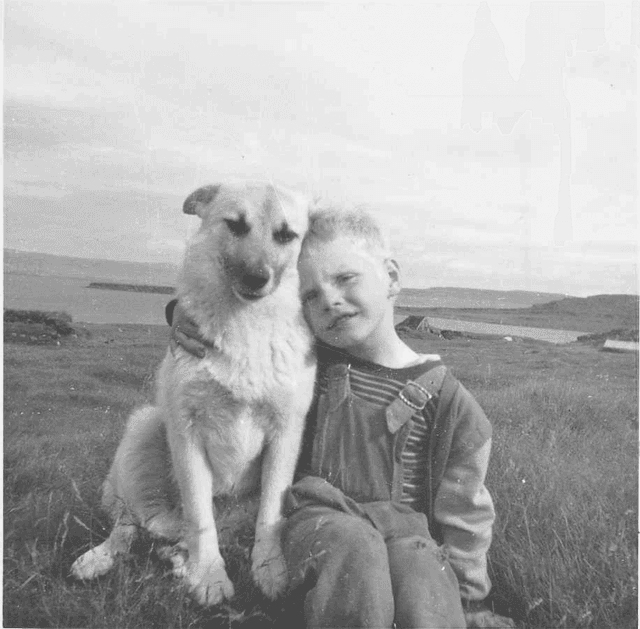
Old photographs
One of the things I'm going to do in this project is to set up a database with pictures, both old and new, black and white, and colored. Pictures always tell a story about the relationship between a human and a dog. I have received several pictures from photo and local history museums and also some from private ownership. The picture that accompanies this post was taken in 1960 in Þernuvík in Ísafjarðardjúp and shows a dog named Brandur and a boy named Gunnar. Gilla from the Hnífsdal kennel sent me this picture and an interesting story about Brandur accompanies it. It will be told later. Dear reader, if you have pictures that you are willing to contribute to the database, please get in touch with me!
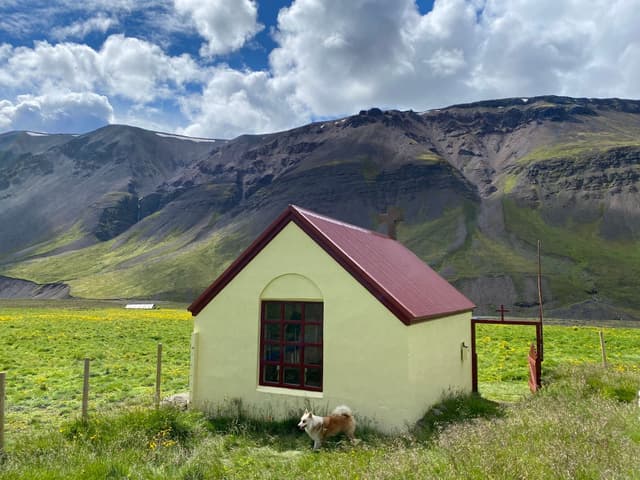
To the church
There is much of interest on the cultural historical database [Sarpur.is](https://www.sarpur.is/). Among other things, it has a large collection on folk customs, and when looking for material on dogs, many curious things come up. For instance, there's a narration about going to church in the old days: "...It could hardly be said that going to church was an exception to dogs joining the journey. Many dogs often arrived at the church, both willingly and unwillingly, and were often a great nuisance, for example, they got into the churchyard and went berserk, as was often their habit as previously mentioned. Some slipped into the church itself during mass and crawled under the benches. However, they didn't like being inside. It was not uncommon for some to lose their most devout attention when the assistant came, took the dog by the scruff of the neck and dragged it, howling, out of the church..." Source: [Sarpur/Folk customs. male, born 1912, Kirkjubæjarklaustur](https://www.sarpur.is/Adfang.aspx?AdfangID=542101) (Icelandic)

Book gift
I have been so fortunate recently to acquire the book "THE ICELAND DOG 874-1956" by Mark Watson, which is an absolute treasure for anyone interested in the history of the Icelandic Sheepdog, like me. The book was published in 1957, in which Watson lists all the data he found about the Icelandic Sheepdog from the settlement years to "present day" as stated in the preface written by Watson in 1956. Watson himself funded the publication of the book, and the profits from its sale he donated to the Reykjavík Animal Protection Association at the time. It is believed that the book was published in 500 copies, which is of course not very many, and therefore the book is very rare and valuable today. The book is a gift to me for the exhibition about the history of the Icelandic Sheepdog, and it was Jørgen Metzdorff who gave it to me after he heard about my project. Jørgen breeds Icelandic Sheepdogs in Denmark ([Naskur kennel](https://www.naskur.dk)) and is a great enthusiast of the dog's history. He has researched the book very well and has given a lecture about it in connection with the Day of the Icelandic Sheepdog. Since Jørgen had three copies of the book, he decided to give me one copy for the exhibition. I am very grateful to him for that! The book is indispensable for the exhibition about the Icelandic Sheepdog. [You can read the book here.](https://drive.proton.me/urls/MSZXKPRSBW#NJ3Xh5blzdvJ)
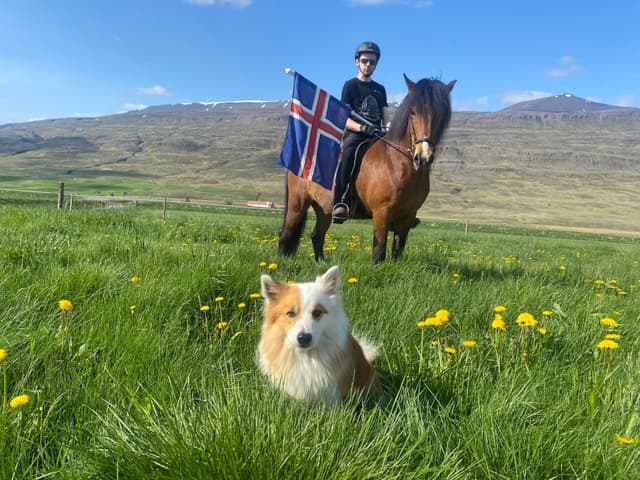
A living work of art
On February 15, 1994, Guðni Ágústsson, a member of Parliament, proposed to increase the respect and prestige of the Icelandic Sheepdog: "The Icelandic Sheepdog is a national heritage and a national treasure of Iceland, it is a living artwork that we must preserve." Parliament concluded by appointing a committee to make proposals for measures to protect and purify the breed of the Icelandic Sheepdog. [The proposal can be read here.](https://www.althingi.is/altext/117/s/0588.html) (Icelandic) Friðjón Þórðarson, former minister and district commissioner, saw the humor both in Guðni's exposition and argumentation and summarized the subject of his speech in a verse that went like this: Ó,íslenski fjárhundur,lifandi listaverk með ljómandi augu sem höfða til réttlætiskenndar. Með hringaða rófu og hálsband um loðna kverk, Nú heiti ég á þig að komast til allsherjarnefndar. ## Happy National day!
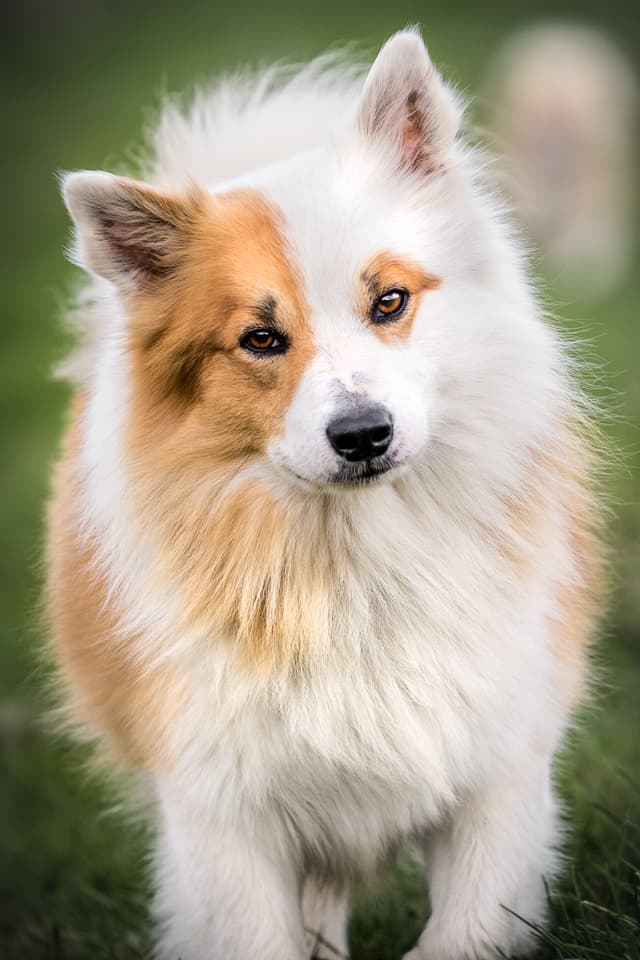
Social Media
To build a network and promote a project, it is essential to be visible on social media. A Facebook page was recently set up when our blog site was launched, and I will post updates there about the project and later about the exhibition. The Instagram account is more intended for the daily dog life at Lýtingsstaðir, and those interested can follow us there. We look forward to connecting with as many people as possible.
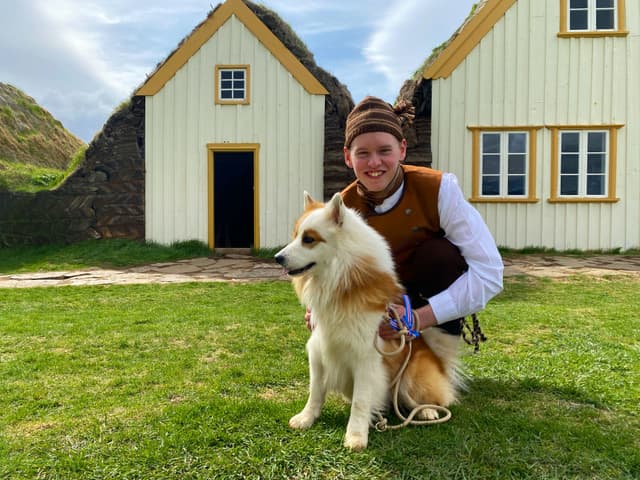
75th Anniversary Celebration in Glaumbær
A splendid anniversary celebration was held in Glaumbær on May 29, marking 75 years since Mark Watson donated money to preserve the farm. The Skagafjörður Heritage Museum is thus the oldest heritage museum in Iceland - thanks to this monetary gift from Watson. Mark Watson is, as mentioned in a previous post, also referred to as the savior of the Icelandic Sheepdog. This provided an opportunity to bring Icelandic Sheepdogs to the anniversary celebration, and 12 dogs attracted a lot of attention and excitement among guests and passers-by.
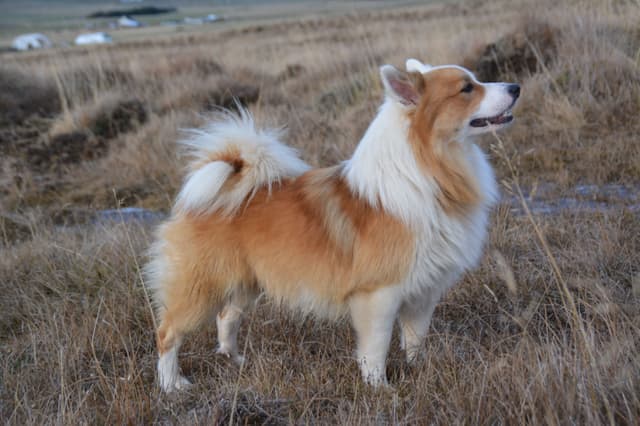
The Logo
I think it is necessary to start promoting the project as soon as possible, and for that, a beautiful logo is needed. Sómi had to be in the logo, as he is the beginning of everything related to the Icelandic Sheepdog here at the farm. Since he and the turf houses at Lýtingsstaðir are inseparable, it was decided to include them as well. I commissioned a young woman from the United States who owns and breeds Icelandic Sheepdogs across the sea and does dog-related marketing materials ([greyfindesign.com/home-dog](https://www.greyfindesign.com/home-dog)). Kristine Olivia designed the logo for me based on this picture of Sómi.

The Grant
In December 2022, I was informed that my project, The National Dog of Iceland, would be granted a subsidy from the development fund of Northwest Iceland up to 1.6 million ISK. I am very grateful for this, as the grant enables me to work on the project and preparations started immediately in January 2023. Ahead is research work, working on the project's website, marketing actions, writing texts, and collecting stories and photographs about and from Icelandic sheep dogs. I will use this year to prepare for the exhibition and aim to open it in the summer of 2024.
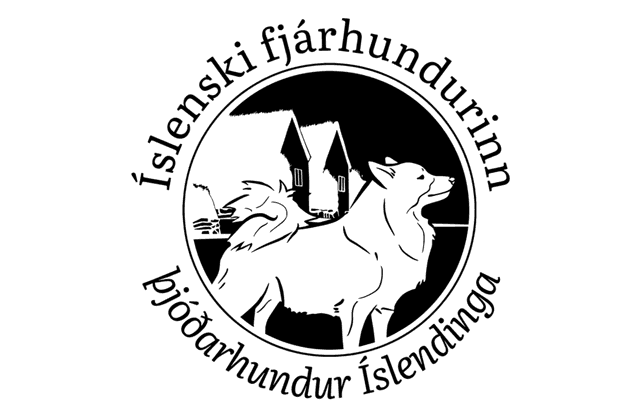
The National Dog of Iceland
I began to delve more and more into the history of the Icelandic Sheepdog. Not only to introduce it better to my guests but I was starting to completely fall for this breed. As a cultural anthropologist, curiosity and interest in everything that is Icelandic and unique awakens in me. In the fall of 2022, I made the decision to apply for a grant from SSNV to set up an exhibition about the history of the Icelandic Sheepdog. While I was writing the application, I shaped the idea for this exhibition. I contacted people who I knew had been working for decades to strengthen the image of the Icelandic Sheepdog. I want to mention Þórhildur Bjartmarz who has collected a lot of material about the dog, given lectures on the subject, and maintained the website [hundalifspostur.is](https://hundalifspostur.is) where there is much of interest to be found. Þórhildur welcomed me and showed me all the data she has collected. We discussed a lot and this meeting with her gave my idea more depth, and I am very grateful to her for this insight and kindness towards me.
Icelandic Sheepdog Day
Post Covid - When life returned to normal, I took Sómi to dog shows and both Sómi and Hraundís to events related to Icelandic Sheepdog Day (every July 18) in Glaumbær. Dog owners from North Iceland often gather there with their dogs. In this context, it's worth mentioning Mark Watson, who is often called the savior of the Icelandic Sheepdog (more on that later). He is also the savior of Glaumbær, where he generously donated money to preserve the old farm. His birthday is on July 18, which was chosen as Icelandic Sheepdog Day. Icelandic Sheepdog Day has been celebrated annually since 2016, and the Icelandic Sheepdog Division of the HRFÍ (Icelandic Kennel Club) oversees it in Iceland.
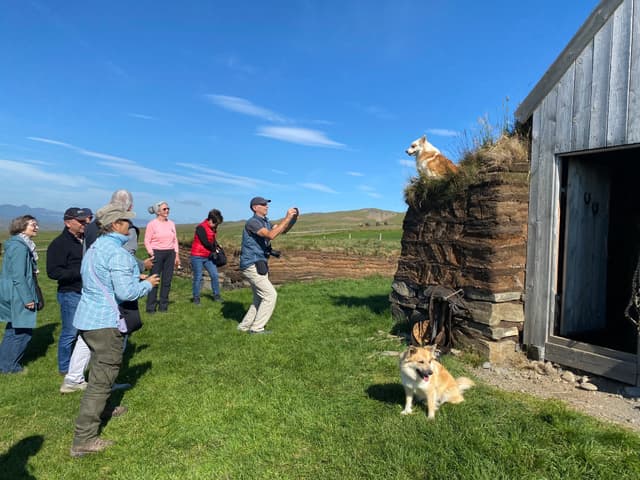
Horses & Heritage
From the summer of 2021, Sómi and Hraundís started participating in the reception of tourist groups and immediately became very popular in our program, which we call Horses & Heritage. In this program, we introduce the history and characteristics of the Icelandic horse, turf houses as the architectural heritage of Icelanders, and the Icelandic sheepdog. Often, the dogs steal the show and perform their tricks on top of the turf houses. It's safe to say that the dogs always impress the tourists.
Hraundís
In April 2021, I got a wonderful dog, Huldudals Hraundís, called Skotta in everyday speech. When I received her, she was 9 months old and badly injured. She underwent surgery where the hip joint had to be removed. The surgery and recovery process went better than expected and after five months she was almost completely mobile. We need to monitor her closely but she lives a good life today. Hraundís is in many ways completely different from Sómi and it's always fun to watch them. She takes on the role of carefully watching the horses and is good at herding them home and into the stable with the accompanying yelping, while Sómi is more interested in sheep.

The pandemic
In March 2020, the pandemic struck Iceland (and the rest of the world) and people were asked to stay at home. Pictures of Sómi cheered up friends and acquaintances around the world during these strange times, as I had ample time to photograph and post on social media. Very few tourists visited us at home this fateful year, but Sómi charmed everyone who came to the farm. Various marketing efforts were made for our tourist business at Lýtingsstaðir in the summer of 2020, and Sómi played a role in all of them. Gradually, the idea sparked to do more with the subject of the Icelandic sheepdog, but first, I wanted to familiarize myself better with the dog's environment in Iceland. Not easy during a pandemic, but social media provided opportunities to meet other owners and breeders of the Icelandic sheepdog in Iceland. There was also a lot of education through online lectures.
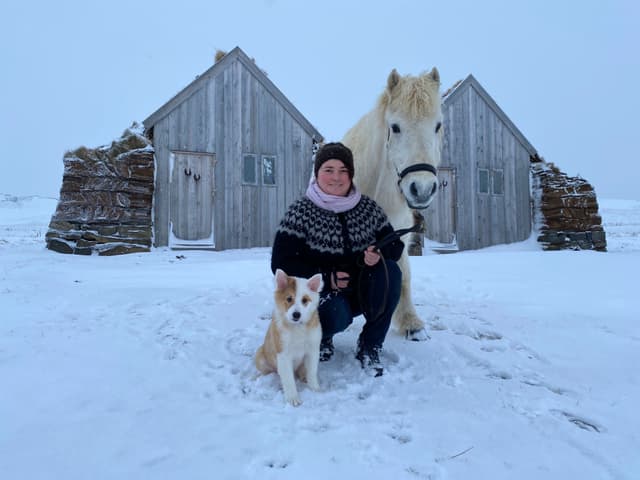
Íslands Sómi
In December 2019, the Icelandic sheepdog, Reykjavalla Íslands Sómi, joined our family. Before him, we had Border Collie mixes, who were also wonderful dogs. Shortly after Sómi arrived home, it became clear to us that he was a gem and could contribute to the project that has been underway here at Lýtingsstaðir for several years: showcasing Icelandic cultural heritage. Sómi discovered the roof of our turf houses as a viewing point just like dogs did in the old days. Sómi and the turf houses immediately became the most popular subjects for photos in the following months.
Contact
Lýtingsstaðir, 561 Varmahlíð.
+354 893 3817
[email protected]

